Australian
and international
exploratory
performance and
media arts
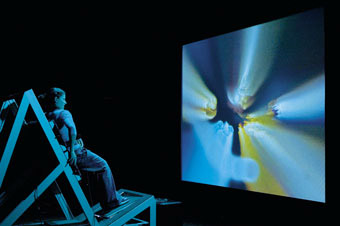
transmute collective, Intimate Transactions (2005)
photo David McLeod
transmute collective, Intimate Transactions (2005)
Keith Armstrong is a leading Australian artist with an integrative and collaborative mastery of diverse practices and media. Since 1993 he has created site-specific electronic art, networked interactive installations, performances and art-science collaborations, shown successfully here and overseas.
Central to Armstrong’s work is the notion of “embodied media”, which has taken his work and the creations made with Transmute Collective beyond conventional text and mouse-based interactivity into the potent realms of sensory and perceptual responsiveness.
Armstrong is currently exhibiting as part of Bathurst Regional Art Gallery’s Showing Off, a large-scale new media art survey exhibition curated by Daniel Kojta, running August 7 to September 20, 70-78 Keppel St, Bathurst, NSW. www.bathurstart.com.au
Transmute Collective’s acclaimed networked interactive installation, Intimate Transactions, now touring for Visions of Australia, completes its journey by connecting participants between the Albury and Dubbo Regional Galleries through physical action and empathetic virtual engagement. September 18-October 18.
A recent work, Knowmore (House of Commons) will appear in Montreal at the Elektra media arts festival in May, 2010.
A new large-scale interactive work, Triple Bypass, “based around the cultural dimensions of climate change”, has first stage funding from the Inter-Arts Office of the Australia Council. The work’s focus underlines Armstrong’s ecological interests—not only environmentally but in terms of the way that “scientific philosophical and ecologies…influence and direct the design and conception of new artworks.”
Documentation and images from Armstrong’s works, including those with Transmute Collective, along with research and writings can be found on his website: http://www.embodiedmedia.com.
interactive re-futuring
keith gallasch talks to keith armstrong
the ecology of interaction
greg hooper: intimate transactions
between research, philosophy & documentation
barbara bolt: intimate transactions, the book
interactive mysteries
greg hooper: shifting intimacies
animating the interactive spin
greg hooper: knowmore (house of commons)
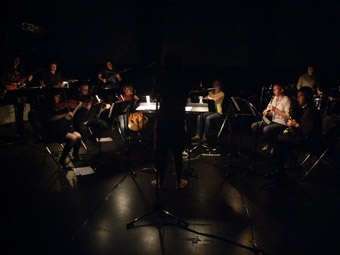
Chronology Arts Ensemble playing Alex Pozniak's Illuminations
Formed in 2007, Chronology Arts is a new force in contemporary art music in Sydney, promoting and producing the creations of young composers with its young ensemble. The group is adding breadth and complexity to a new music scene in which groups as diverse as Ensemble Offspring, Halcyon and Song Company and adventurous New Music Network concerts stimulate an audience greedy for new challenges as well as opportunities to reflect on 20th century innovations that live on.
Chronology Arts will announce its 2010 program on September 4. Back in May, I attended its Gradations of Light concert in CarriageWorks' vast Bay 17. Undaunted, Chronology Arts filled the space with new music, light, responsive video art and ideas and, in Andrew Batt-Rawden's Rise—Gradation from Darkness to Light, moved musicians around and through the audience.
Rise emerges from a cello singing high against dark percussion. Other instruments are added, playing first from behind the audience and then joining the initiators in a rich texturing and swelling of sound with violin, viola and bird-like flute. The ensemble is supple, enveloping, accelerating like wind. A saxophone warbles. The pulse quickens into an aberrant march and then a strange dance, dwelling on an affecting flute passage, rising to ecstatic saxophoning, like the full glare of the sun. The world fades in a slow release breathed in long, sustained notes, the musicians ambling back into the dark. On a small screen in the stage foreground, coloured shapes have reconfigured themselves mysteriously in designer Ed Saribatir's Light Instrument, apparently in direct response to the played score.
Composer Batt-Rawden writes in his program note that sun-rise inspired the work, providing a metaphor for “facing our demons, rising to new challenges.” The result is, as he writes, something “of a primordial ritual…that touches on our cognitive-animal strength.” “Appollonian” might be an apt description for a work suggestive at once of a primal reality but at the same time one blessed with a sunny rationality—there's lucid construction, a sense of occasion and moments of intense feeling but with an optimism that elegantly eschews high drama.
Melody Eötvös' cool Figure Seven contrasts starkly with the warmth of Rise. It's “based on six digitally created creatures from a software program designed to map out evolutionary processes. Each section unfolds from a collection of pitches derived from a 'grid' of 36 squares superimposed over each picture (6 pitches along the y axis and 6 along the x axis). Therefore the subtle changes in the pitch collections mirror the gradual evolution of the images.” This is a work at once stark and delicate, its quietly insistent pulse relieved by pizzicato, downward glissandi and lyrical erhu phrasings (from Nicholas Ng), integrating an intriguing meme to this strand of Modernist evolution.
Ng's own work, Light channels: on circulation and percolation, is inspired by an 8th century Chinese text on alchemy, specifically “the flow of light energy through certain passages or channels in the human body.” The erhu is at the centre of the composition, again framed by Western instruments and tonalities. Gonging and glissandi, some striking, deep, flowing saxophone and jaunty flute and clarinet lines provide rich interplay. In a second movement solo, the erhu, increasingly and fascinatingly distorted, is amplified dramatically against pre-recorded sound (not unlike deep breathing and percolation) suggestive of physical interiority. The work then becomes almost meditative before dancing to a finish.
If there was a lot to take in aurally in Light channels, there were also visual demands. In the first movement, three large screens behind and above the musicians revealed a Rorschach-like triptych of initially abstract shapes folding in and out of themselves and gradually revealed to be a meditation on a tree, splitting, fusing and evolving. It's a work by Christopher Fullham that could stand on its own; here it seemed aptly complementary. In the second movement, clouds drifting against blue sky and criss-crossing each other proved less engaging if providing a kind of visual bass line in their quiet monumentality.
In Illuminations Alex Pozniak aims to generate “an elastic interaction of cells of material across the ensemble…with the instruments and instrumental section (winds, strings, electric guitars) negotiating different degrees of cohesion and liberty in textures that represent light as a dynamic source of energy.” The work opens with high whistlings and a growing sense of vibration replete with tumbling sax notes and rapid flute runs, high strings and guitar harmonics. Three electric guitars swell the scale of Illuminations, each soloing distinctively while accompanied by the other two, ranging from austere lyricism to a chugging slo-mo heavy metal and artful feedback before being joined by the balance of the ensemble in a beautiful collective drift to silence.
Scott Morrison's video response to Illuminations comprises unfocused lines—black, grey, white—running in vertical parallels and then intersected by horizontals. It's a gentle, unhurried work, serenely accompanying the growing passion of the score rather than mimicking its intensity.
Gradations of Light was a satisfying multimedia experience: an ambitious concert built thematically around light (actual and metaphysical) but also, for the most part, dextrously realised in inventive staging and engaging projections. Conductor Morgan Merrell calmly ensured that the ensemble ably managed the numerous demands of these welcome new compositions.
Works by Alex Pozniak will be the focus of a September 8 concert at Sydney University's Manning Bar, and the 2009 Chronology Arts season will end with a concert titled Playing in Tongues, December 9 at the Sydney Conservatorium of Music.
Chronology Arts, Gradations of Light, composers Andrew Batt-Rawden, Melody Eötvös, Nicholas Ng, Alex Pozniak, conductor Morgan Merrell, flute Jane Duncan, clarinet Toby Armstrong, saxophone Andrew Smith, viola Luke Spicer, cello Eleanor Betts, viola/violin Victoria Jacono, erhu Nicholas Ng, guitars Matthew McGuigan, Zane Banks, Matthew Kurukchi; CarriageWorks, Sydney, May 15; www.chronologyarts.net
RealTime issue #92 Aug-Sept 2009 pg. web
© Keith Gallasch; for permission to reproduce apply to realtime@realtimearts.net
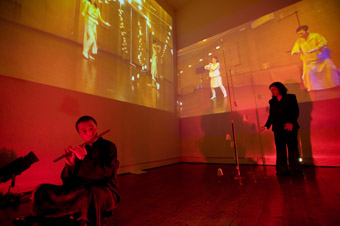
A Nest of Cinnamon
photo Damian Vincenzi
A Nest of Cinnamon
Cross-cultural collaborations can produce surprising hybrids, especially so when the resulting collision is one of Australian-Greek, Chinese and Japanese cultural and aesthetic practices. Angela Costi, poet and performer, quietly confronts her audience dressed in a spiffy yet heavily symbolic black suit. In contrast to this rather business-like cloak of death, musician Wang Zheng Ting, covered in an azure silk gown, solemnly holds before him an enigmatic imbroglio comprising grained wood, labyrinthine finger holes and a stainless steel mouthpiece. It’s a musical instrument the like of which I have never seen, and the wail that it produces is reminiscent of a flightpath borne of great pain.
The driving motif behind A Nest of Cinnamon, a work in progress, is the phoenix; which is appropriate really. Resurrection, or the release of human consciousness from its earthbound location in order to reshape itself elsewhere might very well be a type of ‘creative development period’ in and of itself. Time, space and matter compressed into an eternal present, cross-cultural arts practice is similarly characterised by a Borgesian premise, ie what if..?
Creative development showings are potentially testing for all concerned, particularly so here. The Japanese offering, rather than being performed live, is a video presentation of work completed in Japan some months earlier. It’s more perplexing that Stringraphy, the performance troupe who transform gallery space into acoustic installations that screech with the sounds of global transmission, is the basis for this performance’s rhythmical component. Consequently, the rhythms of the overall performance are simultaneously live, pre-recorded and split between watching bodies move through space and hearing the pre-recorded sound of Stringraphy’s musical instrument. Of course, the rhythms of video and live performance are very different. Digital sound and what the audience hear as Stringraphy pluck decentered lengths of monofilament stretched and threaded through polystyrene cups can in no way compare to the sound and active rhythms of Stringraphy’s ensemble members seen projected on a rear wall as each moves through a gallery space. A dilemma to be sure, but one that teases at the brain in the same way a prototype model of Stringraphy’s installation cum musical instrument does: one constructed in real time centre stage by the creators of Nest of Cinnamon in order to familiarise this Australian audience with the presence of the monofilament and styrene confabulation that can also be seen onscreen.
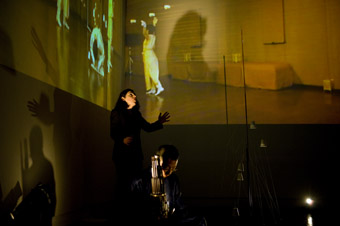
A Nest of Cinnamon
photo Damian Vincenzi
A Nest of Cinnamon
And yet I sense that all is well in this performance. In spite of the difficulties in understanding the context of this work there occurs a moment onscreen when a Stringraphy ensemble member steps forward and utters something in unintelligible Japanese. Almost immediately, the oblique rhythms of Angela Costi’s poetic presence and the piercing tremolo of Zheng Ting’s metal and wood imbroglio coalesce with Richard Vabre’s subtle shifts in red, orange and yellow light. This shift in complexion is less to do with external stimuli and more a case of individual perception. I can now see how this performance might integrate, once in its completed state. The intricate rhythms of Stringraphy’s global transmitter will, like all successful collaborations, intermingle and underpin Costi and Zheng Ting’s reflection upon the resurrecting spirit. From Canterbury-Bankstown to Reservoir, via Beijing and Okinawa, the story of what was once called migration is still one of people incinerating the past for the purpose of igniting a future. The global flow of human traffic is still, and forever will be, consistent with the resurrecting myth that is the flight of the phoenix.
A Nest of Cinnamon: a work in progress, dramaturg, director Christian Leavesley, poet-performer Angela Costi, sheng performer Wang Zheng Ting, Stringraphy Ensemble: Midori Yaegashi, Mitoko Shinohara, Momo Suzuki, Kiku, lighting Richard Vabre, producer Keiko Aoki, Global Japan Network; Arts House Meat Market, Melbourne, June 19
RealTime issue #92 Aug-Sept 2009 pg.
© Tony Reck; for permission to reproduce apply to realtime@realtimearts.net
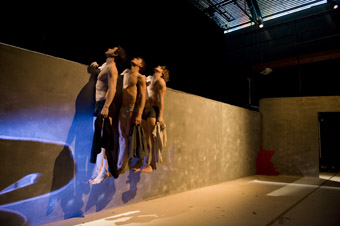
Nowhere Fast, Dance North
AN UGLY, GREY, DEAD END LIT BY A SINGLE STREETLIGHT AND OBSERVED BY THE COLD RED EYE OF A SURVEILLANCE CAMERA MOUNTED HIGH ON A WALL FORMS THE UNSYMPATHETIC SET OF DANCENORTH’S NOWHERE FAST. THE GRUBBY WALLS BEAR THE PENTIMENTI OF EARLIER TRAGEDIES—IS THAT A BLOODSTAIN IN THE CORNER?—BUT GIVE LITTLE ELSE AWAY. AS THE WORK UNFURLS THE SET FULFILS ITS PURPOSE, REPRESENTING BOTH THE OBSTACLE AND THE VOID AGAINST WHICH THE TWITTERING MASSES HURL THEMSELVES IN THE SEARCH FOR MEANING OR, AT THE VERY LEAST, SOME ATTENTION.
Nowhere Fast is Ross McCormack’s first full length choreography. The New Zealander has danced with the Royal New Zealand Ballet and Australian Dance Theatre, winning a Helpmann Award in 2004. He moved to Belgium to work with Les Ballets C de la B, and part of the idea for Nowhere Fast arose from the “urban loneliness” he observed living in the most densely populated country in Europe, as well as his concern for a generation experiencing “life at one remove” through a variety of new media. His principal visual influence is the work of American photographer Gregory Crewdson, whose meticulous set pieces reek of alienation within suburban ordinariness.
The musical score is the work of Jody Lloyd in his first foray into composition for dance. Much of it was developed in his studio, referencing McCormack’s rough ideas, Crewdson’s photographs, and DVDs of the work in progress. He spent the final two weeks prior to the show in Townsville working directly with the company, honing the atmosphere and pace of the varied soundtrack. It collages everything from ground shaking car stereo ‘doofdoof’ to Maria Callas to “squashed and pulled Hawaiian steel guitar”, solidly underpinning the action.
McCormack says he asked the six dancers to “put away technique to develop character, explore and express yourself emotionally.” The physicality, youth and raw strength of the Dancenorth ensemble rises to the task from the moment the work commences with a naked young man clambering over the wall to stand vulnerable and semi-exposed in the twilight. Initially, it’s as though D’Arcy Andrews, so unsure and awkward, has found himself there unexpectedly; and like the audience, is trying to figure out what’s going on. He pulls on underwear—dressing, undressing and clothes swapping are recurrent themes—and begins scrawling on the wall. Luke Hanna appears, fighting unseen demons, evoking Munch’s The Scream in his facial contortions and self-flagellation. Andrews observes tentatively, briefly mimics Hanna’s wild movements; Hanna licks Andrews, leaving a trail of bright blue across his body, but it is an arbitrary mark with no connection or empathy evident.
Hsin-Ju Chiu enters and Hanna and Andrews observe her warily as she primps and poses. Alice Hinde and Nicola Leahey join her and the three begin compulsively flicking their hair in unison, laughing flirtatiously but manically in a dance where the flicking becomes scruffing becomes violent scratching. The heels come off to be banged and dragged against the walls, but attention spans are short and Hanna is off tweaking the surveillance camera, and a shaking skinhead is emerging from the shadows, graffiti-ing the walls, chalk in both hands.
The shaking man, Joshua Thomson, draws, increasingly frenetic, leaping and circling rapidly, and suddenly he is a human compass, his head centred on the wall and his outstretched arms drawing a near perfect circle as he spins on the spot. He stops and turns, resting his back against the wall, arms still wide—a latter day Vitruvian Man for an instant, having just created a bespoke frame for his exact proportions. As he slathers his head with magenta paint, his eyes and veins popping, a shot rings out and Thomson convulses in death throes. Writhing in Goya-esque agonies, he then enacts suicide by decapitation, disembowelment, strangulation, in a distressing and relentless, but utterly compelling sequence.
Atop the wall perch the girls, a giggling trio, reaching toward Thomson, chirruping platitudes. “Awww, honey!”, croons Nicola Leahey inanely as the consummate Barbie doll. The incongruity of their responses reaches its height as Thomson opens his mouth to scream and they literally begin to drag him up the wall by his open mouth, before dropping him in a heap in the corner.
This scary juxtaposition of vacuousness and sheer muscle plays out in several scenarios within the work—another frantic sequence sees the group fling Hinde through the wall. They look at each other in silence. A dog barks in the distance. Andrews lamely attempts to reassemble the broken pieces of the wall to conceal Hinde’s inert form. Hsin-Ju holds out her mobile phone and films the accident scene. Leahey laughs and disrobes to divert attention to herself, running back and forth, dress on and off, posing against the wall art like a demented package tourist doing Rome in a day. The boys are momentarily amused before they too start running and stripping, looking off into the distance to see who’s observing them.
In the final sequence all the dancers perform a repetitive floor-slapping routine in unison, like a wordless prayer for connection. But, frustrated by their own clueless self-obsession, it is a one-step-forward, two-steps-back exercise in futility. A shirtless Hanna personifies their internal stasis by contorting his jawdropping physique into a state of semi-mobility, a marble Rodin under the white-blue light. All are as disparate in the end as they were in the beginning.
Nowhere Fast left some of its audience scratching for a storyline, accustomed as they are to the strong narratives in the works of former artistic director Gavin Webber. McCormack’s guest work taps the same vigour and grit the Dancenorth ensemble have become renowned for, perhaps less poetically, but to powerful, confronting and often unexpected effect. The disjointed feel of the piece; the frenzied action interspersed with loitering, watchfulness, imitation and self-conscious posing; the frustrated attempts at meaningful connection; all successfully capture the mood of an age where we are so busy media surfing in an effort not to miss anything that we are in danger of going nowhere, fast.
Dancenorth, Nowhere Fast, choreographer Ross McCormack, performers D’Arcy Andrews, Hsin-Ju Chiu, Luke Hanna, Alice Hinde, Nicola Leahey, Joshua Thomson, composer Jody Lloyd, lighting Natasha James, Townsville, July 1-5
RealTime issue #92 Aug-Sept 2009 pg. 36
© Bernadette Ashley; for permission to reproduce apply to realtime@realtimearts.net
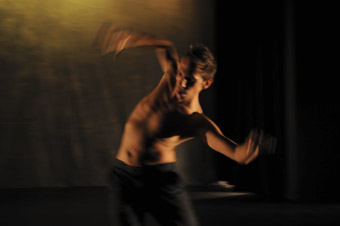
Martin Del Amo, It’s a Jungle Out There
photo Heidrun Löhr
Martin Del Amo, It’s a Jungle Out There
MARTIN DEL AMO IS UBIQUITOUS. HE POPS UP WILD HAIRED AND UNDIE-CLAD SO OFTEN ON THE SYDNEY UNDERGROUND DANCE LANDSCAPE THAT EXPECTATION IS FASHIONED BY FAMILIARITY. YET HE SURPRISES. HIS INSOUCIANT BELIEF IN THE INHERENT WORTH OF WHAT HE HAS TO SAY GIVES HIS WORK A TRADEMARK INTENSITY THAT RESULTS FROM THE PIQUANCY OF FASCINATION AND RESEARCH. WHATEVER DEL AMO IS INVESTIGATING, IT IS DONE WITH A FEROCIOUS AND METICULOUS ATTENTION THAT IS A LUST TO DISCOVER, UNCOVER AND REVEAL.
It is this lust that saves It’s a Jungle Out There from cliché. The work’s stated intention is to explore “the modern city as an ever changing organism.” Within such a topic lies potential for trite statements about regulation, hurried temporalities, frayed nerves and harried obedience. And Del Amo does make such statements. But he tempers predictability with the truths that emerge from research. He does not merely condemn ‘the city’ as a Gomorrah of undisputed self-interest; he also investigates it as a site of fertile possibility. Dance becomes embodied investigation and his body asks: what is it to exist in this landscape?
The invited opening night crowd warble in. Just sitting atop this diffuse murmur is another muffled voice. Del Amo is crossing the stage in straight lines, incessantly speaking numbers into a head mike. I am surprised by his modest and conservative clothing and tamed hair. Nearly corporate, neat, almost sharp. Gail Priest’s soundscape rumbles subterraneously and like the hum of a city goes almost unnoticed until it erupts into occasional porcelain scratches that hurt my teeth. In the black and grey space the numbers get louder and del Amo gets closer. The dancer’s shadows loom large and small, walking away from self. Numbers engorge themselves into ridiculousness then transform into pithy scenic descriptions. Del Amo’s voice remains incessant and constant, occasionally yelling to break the hypnotic patina. Now the script is akin to rapping, and rhythm is meaning. This first section is building with an almost foreboding rhythmic curve that stops me laughing at the very funny things he throws at us. As the performance unfolds this rise to climax and subsequent release will occur with regularity, even predictability, but it still works.
In his attention to detail, del Amo asks me to notice it too. In this opening section, walking is the dance. Each step is lovely. Each step is soft, loving the ground. Focused feet articulate bones, shifting in repetition and variation. In cities we walk. Cities make us walk. And this particular walking, slightly knock-kneed, sure but not bored, is both heartbeat and journey.
The climax rips apart the hypnosis of repetition. Lights flash and flare blindingly to shake us out of the zone. Almost reassuringly del Amo has removed his smart city shirt and his shadowed and naked torso swings and creaks like a rusty gate in the wind.
Section 3 presents as a lecture. Quietly del Amo brings out a microphone stand and delivers a monologue about a particular kind of urban agoraphobia where sufferers are compelled to build life-like models of the outside world inside the safety of their homes. Like so many of the artist’s observations, the potency resides in an admixture of disquiet and humour.
The disquiet tumbles into section 4 where del Amo runs and runs, round and round, carving the neverending figure eight pathways that now sit layered on the linear grids, mashing up space, making mess. To Priest’s repetitious pulse he runs backwards and forwards, he dodges, weaves, reaches, turns, twists, throws with a kind of focused anxiety rooted in the torso. The legs keep running. He sweats. I am getting warmer. And I realise that one of del Amo’s gifts is the creation of atmosphere through an embodiment that knows exactly why it is doing what it is doing and will keep on doing it. His use of repetition, development and variation allows these atmospheres to build through diffusion, thickening of temperature and sculpted temporalities.
As his breathing calms, section 5 develops into a square dance of negotiation: small steps forward, back and side create little lines of direct action. Restraint and constraint drive the performance down to mad quantum ruminations. Do the little red and green men who live in traffic lights change location? Do they talk to each other?
Emerging from this performance I am close to wordless. Like leaving a David Lynch movie, I don’t quite know where I am. The sensation is dreamlike, but not fuzzy. This dream is ripe with observational truth, clarities born of flesh, rhythm and atmosphere. It is not the clarity of intellect but of mindful body-in-place. This is because Martin Del Amo is a researcher. He does not seek to manufacture but to authenticate. He writes: “as part of my research for this piece, I conducted a series of excursions to heighten my perception of the city’s impact on the body. They included walking backwards through Sydney’s CBD, walking blindfolded along Parramatta Road during rush hour and crawling on all fours in the historic part of The Rocks.” From these bleeding-for-art excursions, blood, body, breath and rhythm speak.
Campbelltown Arts Centre Contemporary Dance Program, It’s a Jungle Out There, performer, devisor Martin del Amo, composer, live sound Gail Priest, lighting designer Travis Hodgson, designer Paul Matthews; Campbelltown Arts Centre, Sydney, June 25-27
RealTime issue #92 Aug-Sept 2009 pg. 36
© Pauline Manley; for permission to reproduce apply to realtime@realtimearts.net
KAREN THERESE’S THE RIOT ACT FOR CAMPBELLTOWN ARTS CENTRE IS A GRUELLING PORTRAYAL OF THE SYMPTOMS AND CONSEQUENCES OF SOCIAL DISADVANTAGE.
A conventional opening satirically trashes the caring rhetoric of politicians, bureaucrats and welfare NGO executives, their public platitudes eviscerated by a string of mobile phone calls they insist on answering. A subsequent media circus bribes the disaffected to perform badly, as expected, while behind the action huge projected graphs of crime rates and domestic abuse statistics in Sydney’s outer suburbs pulse by. Then everything changes. We’re transformed from our addicted media watcher selves into clinical observers of caged animals, society’s victims, in a world where time slows almost to a numb halt. The Riot Act has mutated into a largely mute, contemporary performance work where appalling states of being are doggedly examined.
This imploding non-time is interpolated with outbursts where the subjects abuse themselves and each other in acts sexist, racist and seemingly psychotic. Eventually a riot erupts from an apparently incidental trigger, igniting the fuel of accumulated pain and the delirium of insistent state surveillance. It’s a riot without an agenda, unplanned and with nowhere to go except more punishment and abjection—guilt confessed to the media, save for one dissenting voice.
The Riot Act offers neither small ‘l’ liberal comforts—there is rarely reassuring compassion in this non-society, rarely any reflection, sustained games, completed art—nor radical analysis. The riot itself is generalised: it doesn’t explode from a single motive—resisting or enacting racism in Cronulla or protesting police arrest in Macquarie Fields. Therese appears to be saying, specific trigger or not, the potential for riot is ever present given the abject states her subjects must endure. To amplify the danger inherent in this condition, she has chosen, in the style of Les Ballets C de la B, to convey a sense of real threat with performances that read like improvisation, unpredictable and sometimes visibly dangerous. But there is none of the Belgian company’s redemptive choreographic and musical collectivity. Therese’s performers are not allowed such spirit or virtuosity. It’s a risky strategy that inclines the Riot Act to one-dimensionality, melodrama (compounded by a point-scoring sound score) and formlessness. That said, the performances are passionately committed and, like a bad dream of a life you would not want anyone to live, the Riot Act worries at you weeks after you’ve peered into its darkness. The Campbelltown Arts Centre has boldly championed a challenging if challenged work.
The Riot Act, director Karen Therese, performers Matthew Day, Matt Prest, XX, Lalau Leo Tanoi, Latai Tauoepeau, Lizzie Thompson, design Mirabelle Wouters, Lara Thoms, sound design James Brown, Gail Priest, dramaturg Chris Mead, movement Kathy Cogill, video Scott Otto Anderson, lighting Paul Osborne, producer Annemarie Dalziel; Campbelltown Arts Centre, June 4-13
RealTime issue #92 Aug-Sept 2009 pg. 38
© Keith Gallasch; for permission to reproduce apply to realtime@realtimearts.net
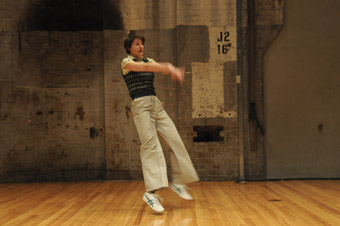
Rosie Dennis, Fraudulent Behaviour
photo Heidrun Löhr
Rosie Dennis, Fraudulent Behaviour
IS THIS THE REAL THING—ROSE DENNIS, IN A SHOW CALLED FRAUDULENT BEHAVIOUR, WITH WHITEBOARD, CHATTING AMIABLY TO US LIKE A RACONTEUR, LECTURER, STAND-UP THEORIST, FOR THE BEST PART OF AN HOUR? OR A FRAUD, A FAKE—NOT THE FAMED, REAL ROSIE DENNIS OF 20-MINUTE TOURETTE-ISH BOUTS OF QUICKFIRE POETRY AND SPASMS OF LOVE AND OTHER ANXIETIES.
This Rosie Dennis whiteboards Nietsche’s “We need lies in order to live”, rattles off a long list of everyday and sometimes very funny, lateral untruths that illustrate how we deceive others and ourselves and then breaks away to have a familiar word or two with a decoy duck in a bowl on a plinth. She inexplicably dances at length in loping, elegant strides and tight turns to Tom Waits. That seems innocent enough, unless she’s in a reverie, a private lie of being somewhere or someone else and ‘big in Japan.’
Next on the whiteboard is Herman Hesse: “There is no reality except the one contained within us; that’s why so many of us live unreal lives.” We are introduced, consequently, to an imaginary childhood friend, Elvira, who subverts the laws of physics and time and will take Dennis “to paradise one day.” This comforting lie segues into an account of a couple living out another, the ‘paradise’ of co-dependency. And on Dennis goes, delving into our snowdome reality (a sustained image both spoken and actual in the show) with a Paul Austerish intensification of coincidence and misconception as she recounts taking a long, perhaps potentially risky cab ride.
This other Rosie Dennis is an amusing then worrying confider, netting the sudden moments of self-awareness she prompts, trawling us with her into uncharted metaphysical outer space. By the end we might be missing the original manic Dennis a little, but this laidback substitute is just as scary, and possibly not a fraud at all, but the same person. Whatever, this new Rosie Dennis persona is an intriguing development, still evolving and not quite on top of her play with her puppet-ish props. But it’s lovely to be lied to so convincingly.
See our online producer Jo Skinner’s response to Fraudulent Behaviour, a video excerpt from the show and links to archived RealTime articles about Rosie Dennis.
Fraudulent Behaviour, performer, devisor Rosie Dennis, trumpet Simon Ferenci, Performance Space at CarriageWorks, June 11-12
RealTime issue #92 Aug-Sept 2009 pg. 38
© Keith Gallasch; for permission to reproduce apply to realtime@realtimearts.net
{$slideshow} THREE RECENT PRODUCTIONS MOUNTED AS PART OF THE VICTORIAN ARTS CENTRE’S FULL TILT PROGRAM HAD ME PONDERING THE SCIENCE OF INTERPRETATION. THE FIRST, A REMOUNT OF RED STITCH ACTORS THEATRE’S WONDERFUL RED SKY MORNING, WAS A BIT OF A SCHRODINGERIAN CAT. HAVING ALREADY SEEN IT IN ITS INITIAL INCARNATION AT RED STITCH’S TINY HOME IN ST KILDA, I WASN’T SURE HOW IT WOULD SURVIVE WHEN TRANSPLANTED TO THE BIGGER BOX OF THE ARTS CENTRE’S FAIRFAX STUDIO. I’M STILL UNCERTAIN WHETHER IT SURVIVED OR NOT.
red sky morning
I like to think the cat is alive. In Erwin Schrodinger’s famous thought experiment, we are meant to imagine a cat in a box along with poison which may be released without our knowledge. According to the physicist, the cat is both alive and dead until the moment the box is opened and, lo, we can observe the reality. Schrodinger wasn’t advocating the killing of cats, and I hope that nobody’s actually followed through with the experiment. But he was attempting to illustrate the limitations of a science that logically implied the possibility of incommensurable realities existing simultaneously. Which sounds to me suspiciously like art.
The play is, to my mind, one of the finest products of creative collaboration in years. It traces a day in the life of a family of three, all infected with a heart-wrenching depression that takes form in various ways. Mum suffers from a painfully realistic alcoholism that does away with simple clichés of the happy/angry/functional/dysfunctional drunk. Father is a painfully laconic figure whose inability to articulate his feelings has increasingly terrifying effects. Daughter’s teen frustrations make her a social pariah, unable to forge meaningful connections with her parents or peers. There is no obvious source for the dangerous black dog which menaces the family; its effects, however, are all too clear. Red Sky Morning is also very funny.
This is an astounding work of theatre that could only have resulted from an intensive association between its writer, director and performers over a long period of time. It’s exactly the kind of production I would want to see picked up by programs such as Full Tilt, allowing it to be exposed to a wider audience than Red Stitch’s considerable subscriber base alone. But of course I’m biased—having enjoyed its first outing so much, the cat is still alive for me. Transposing Red Sky Morning from a tiny St Kilda theatre to the sizeable Fairfax (which was itself curtained back to half its usual scale in order to maintain the tight forward focus of the original) may have reduced its effectiveness for newcomers, but I sincerely hope that this is a piece with a strong life ahead of it.
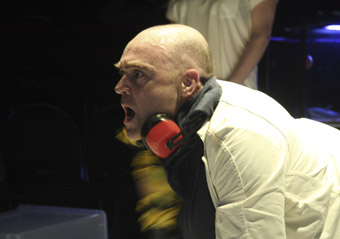
Simon King, Poet #7
photo Daisy Noyes
Simon King, Poet #7
poet #7
The second of Full Tilt’s most recent season of programmed works was a more difficult exercise. Ex-Melbourne playwright Ben Ellis has based himself in the UK for a number of years but his recent writing still has strong connections with the work he was producing here. One common thread is the use of apocalyptic scenarios: 2002’s Falling Petals saw the youth of a country town succumbing to a mysterious plague-like illness, while last year’s The Zombie State featured hordes of working-class undead ravaging Melbourne (RT88 online: www.realtimearts.net/article/issue88/9256). His theatre has often employed such imagery for political ends, to comment on the real dynamics and perils of contemporary culture. Like philosopher Slavoj Zizek, I’ve long been wary of the effectiveness of apocalypse as an ideological framing device—it’s all too easy (and disempowering) to imagine that radical change can only occur through a complete upheaval in society. Such scenarios, while undoubtedly terrifying, are seductive in the freedom from conventional morality and social bondage they envision, but are equally fantasies which deter us from imagining actual methods of altering the systems of power that presently exist.
Ellis doesn’t fall prey to this tendency, however, and Poet #7’s setting (or rather, settings) within a world that has undergone a cryptically-referred-to Armageddon are not accomplished simply in order to make crude comments on the problems of modern life. In fact, the setting would seem almost superfluous if it didn’t afford Ellis the chance to produce some wonderfully evocative poetry. The title of the piece refers to a poet recalled by one of the four narrators—a poet destroyed by a bomb blast while clasping the speaker’s hand, and which hand stays unwittingly clasped by the dazed speaker as he runs in terror from the scene.
We learn very little of the titular poet, and over the course of the play we don’t learn an awful lot of its characters either. Ellis’ script gives us four voices that each inhabit a different temporal zone. Though they’re related in various ways, it’s up to the audience to piece together a narrative from these fragmented chronologies. While it’s not unusual for theatre (or other art forms) to play with time in this way, it’s rarer to witness a work in which each character exists in complete temporal isolation.
Poet #7 is a fascinating experiment—appropriate given its lab-type setting and medical-procedural themes—but its consciously high level of formal stylisation will mean that any observer will come away with a different interpretation. Science knows, I haven’t found two people who can agree on what is actually supposed to have occurred in the piece, and responses have ranged from ecstatic to bored. Perhaps, in discovering the narrative ‘truth’ of the work, its aesthetic beauty loses focus—and vice versa. This variety of individual interpretations is itself a kind of Heisenberg Principle given dramatic expression. In any case, it’s the kind of boundary-pushing work seldom seen in a state arts centre.
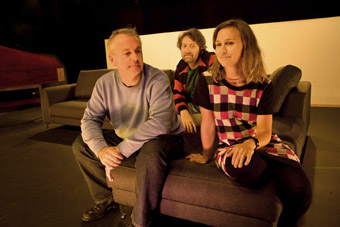
Affection, Ranters Theatre
photo James Boddington
Affection, Ranters Theatre
affection
Ranters Theatre’s recent works have been just as edgy, but as anyone who witnessed the brilliant Holiday will attest, their unique innovations are so thoroughly approachable that even the most wary of theatregoers will find themselves seduced. Affection isn’t as carefully crafted a work as Holiday, though it has developed from the same practices which informed that piece. It is styled as a hypernaturalistic series of conversations between people who appear as simply themselves—character, plot and backstory are dispensed with, and what we see is exactly what it is. This is harder to accomplish than it sounds. As audiences, we’re trained to look for deeper meanings, subtexts, the relationships and histories of the people we see onstage. Of course, we do this during Affection too, but the casual reticence of Ranters’ method makes us aware of our own role in constructing these narratives. Theatre no longer becomes a case of solving the mystery or finding the secret truth to a text, but instead forces us to consider that our own act of observing brings with it a history that massively affects our understanding of what we see. The Observer Effect, after all, isn’t limited to physics. Art is a science with infinite variables.
Red Stitch Actors Theatre, Red Sky Morning, writer Tom Holloway, director Sam Strong, performers David Whiteley, Sarah Sutherland, Erin Dewar, designer Peter Mumford; Fairfax Studio, June 3-13; Poet No. 7, writer Ben Ellis, director Daniel Schlusser, performers Edwina Wren, Merfyn Owen, Simon King, Georgina Capper, designer Meg White, sound designer, composer Darrin Verhagen, Martin Kay, Nick van Cuylenburg, lighting Kimberly Kwa, costumes Jemimah Reidy; The Black Box, June. 11-20; Ranters Theatre, Affection, text Raimondo Cortese, director, devisor Adriano Cortese, performers, co-devisors Beth Buchannan, Paul Lum, Patrick Moffatt, Anastasia Russel-Head, Heather Bolton The Black Box, Arts Centre, Melbourne, June 1-11
RealTime issue #92 Aug-Sept 2009 pg. 40
© John Bailey; for permission to reproduce apply to realtime@realtimearts.net
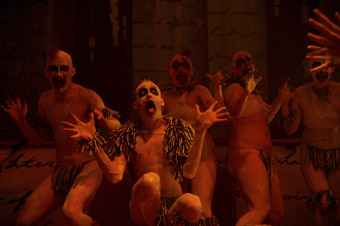
Calibans, Zen Zen Zo, Tempest
photo Simon Woods
Calibans, Zen Zen Zo, Tempest
THERE IS SOMETHING SWEET, ENTIRELY SINCERE, SOMETHING WHOLLY OWNED BY THE CAST AND CREW OF ZEN ZEN ZO PHYSICAL THEATRE’S ADAPTATION OF SHAKESPEARE’S THE TEMPEST THAT WEAVES ITS OWN SPELL. THE TEMPEST HAS BEEN DESCRIBED AS AN ATTEMPT TO ENVISION UTOPIA WITHOUT UTOPIANISM, AND THERE’S SOMEHOW AN OVERDETERMINATION IN THIS PRODUCTION THAT SEEMS TO BE SUITED TO THE NATURE OF SHAKESPEARE’S PLAY.
It doesn’t simply stem from the energy of the mainly young cast or the eclectic fusion of high art and pop culture tailored for young audiences, but from what can only be described as a residual faith in art on its ultimate borders where, as the critic Leslie A Fiedler points out, it becomes indistinguishable from sorcery. This production actually contemplates a transformation in the fundamental structures of everyday life, a concept that shouldn’t be so astonishingly novel nowadays when it seems nothing less will halt the headlong destruction of the planet. The Tempest is the most quotable of Shakespeare’s plays, including that one line about the whole globe dissolving, leaving not a rack behind.
Lynne Bradley’s director’s notes announce that the core message of the company’s version of The Tempest is that “it is every human being’s imperative to struggle for freedom—both political and personal.” All the characters, including Prospero himself, struggle to be freed from some kind of internal or external entrapment—to write, as it were, their own scripts. It is the courtiers and the politicians who are enmired. As we enter the space, we notice that visual director Simon Woods has writ large across the cavernous Concert Hall walls what look like reproductions from the Folio manuscripts, simultaneously creating the dioramic impression of waves round Prospero’s island and generating notions of the text as either a set of discourses or set in stone by claims made in the name of The Tempest’s timelessness and transcendence. Later on, with gesturing hands, Prospero will visibly underscore the demeaning irony of being trapped inside another person’s script against this backdrop. The Tempest is a play in which the word ‘strange’ is the most frequently used adjective, and we are inducted into this promenade style theatre by wandering among living statues, tableaux of the actors who are not simply still but emanate that ‘ferociousness of being’ that Rilke attributes to the presence of his angels. The atmosphere is ‘strange’, but it is we who are the strangers.
Zen Zen Zo aim to create total theatre, with “the spoken, physical, visual and aural texts all playing equal roles in imparting the meaning.” They are also a training institute, which accounts for their need for a large cast in order to incorporate students. Physical disciplines predominate, including the Suzuki Method, Butoh and Contact Dance. All three are usefully in there, but it is the Butoh movement adopted wholesale by the Caliban Chorus that amounts to a conceptual as well as physical tour de force. Zen Zen Zo has drawn from post-colonial readings of the play, and the Calibans are portrayed somewhat as the American Indian tribes encountered by English settlers in Shakespeare’s time (Pocahontas met Ben Jonson): almost naked, hair tufts and terrifying facial war paint. These Ur-Indians who are also Butoh exponents might seem a bridge too far, but they could hardly be real Indians. Caliban was part fish, already ersatz. They are the European Other everywhere who must be taught language (as Prospero teaches Caliban) as a technique of colonial rule. In fact, the Calibans are the fantasy of the Other owned up to, swallowed and vomited forth—quite horrifying in the permutations of their degradation by the insouciant in-comers to the island. I flinched. What was magnificent, in balance, was the log rebellion, the mass enaction of Caliban’s suggestion to his outlander co-conspirators, Stephano and Trinculo, that they stave in Prospero’s head. Dale Thorburn articulated Caliban’s position well.
Music is the foundation of The Tempest: “Sounds and sweet airs that give delight and hurt not.” The music makers on stage are Ariel and Prospero, cabaret artiste Emma Dean and classic actor Brian Nason, doyen of his own Grin and Tonic Theatre Company in Brisbane: natural collaborators in terms of the play. Offstage the composers were Emma Dean and Colin Weber. Dean is a physical dynamo, snazzy, a musical virtuoso (piano and violin) and, indeed, the flighty Ariel threading the show. Nason is the ground. Properly irascible as his Prospero is, as internally conflicted, he has a lute player’s touch on Shakespeare’s language. Even in the soundaround his performance chimed. His final exchange with Caliban—“this thing of darkness I acknowledge mine”—shone with heartbreaking lambency.
Zen Zen Zo Physical Theatre, The Tempest, director Lynne Bradley, visual director Simon Woods, performers Bryan Nason, Emma Dean, Dale thorburn, Jill Guerts, Alex Mikic, Jamie Kable, Jane Cameron, Luke Kerridge, Alice Flynn, Carolyn Eccles, Jess Samin, Natalie Bak, Brigid Blanckenberg, Caesar Cordovana, Jamie Kendall, Alison McGregor, Emma Bleanay, Harriet Devlin, Krystal Hart, Oliver Skrzypczynski, Lisa Worthington, composers Emma Dean, Colin Webber, lighting designer Jason Glenwright, costume designer Angela White, set designers Drew der Kinderen, Lynne Bradley, Luke Kerridge; Old Queensland Museum, Brisbane, June 2-July 1
RealTime issue #92 Aug-Sept 2009 pg. 42
© Douglas Leonard; for permission to reproduce apply to realtime@realtimearts.net
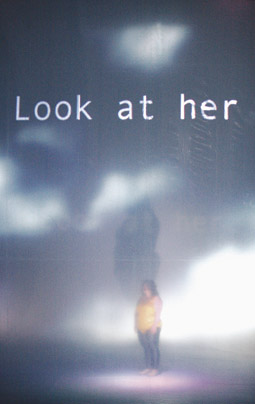
Food Court, Back to Back Theatre
photo Jeff Busby
Food Court, Back to Back Theatre
THE LAST TIME I SAW BACK TO BACK THEATRE, THEY WERE FRAMED BY THE CONCRETE PYLONS OF SYDNEY’S CIRCULAR QUAY RAILWAY STATION. IN THAT SHOW, SMALL METAL OBJECTS, THE SPECTATORS BECAME THE SPECTACLE—SITTING IN BLEACHERS IN THE CUSTOMS HOUSE FORECOURT—WHILE THE ACTORS EXPERTLY PERFORMED THEIR INVISIBILITY. IN FOOD COURT, HOWEVER, THE AUDIENCE SITS IN THE CONFINES OF THE OPERA THEATRE, ANONYMOUS AND UNSEEN, AS THE ACTORS ASSUME A SELF-CONSCIOUS HYPERVISIBILITY, COMPLETE WITH RED VELVET CURTAINS AND GOLD LEOTARDS.
Food Court begins with the three musicians from The Necks making their way down to the pit to take up their positions on piano (Chris Abrahams), double bass (Lloyd Swanton) and drums (Tony Buck). The opening notes sound out their instruments, each other, and the audience, two of whom cough in response. The red curtains open to reveal a wide and shallow stage with black drapes which part as a man carrying a wooden chair comes onto the stage. Soon he has set up three chairs and two gloriously, grotesquely overweight ladies in gold leotards (Rita Halabarc and Nicki Holland) join him. They parade like gymnasts at the end of a floor routine: arching, stretching, posing and mugging you might even say. Their glitzy leotards recall the circus or the freak show, where performers with disabilities have historically been placed, and for a moment we wonder whether this show will be any different.
The reply comes soon enough, as a thinner woman (Sarah Mainwaring) enters and seats herself, her hands shaking involuntarily. The other women interrupt their banal conversation—“Have you ever had a hamburger?”—to declare, for no apparent reason, “You’re fat.” Though the insults start with a false innocence—“I don’t want to upset you but…”—they soon come without apology: “You’re fat, you’re a fat lady, you’re disgusting, you’re embarrassing, lose some weight, she can’t even talk, learn to speak English.” The phrases are discomfiting not only because the text is projected onto the black curtains but also because they seem like comments the performers themselves might have heard over the years. When the surtitles falter momentarily it is as if the abuse has become literally unspeakable.
Without landing a single blow, the second act proceeds to unleash extraordinary violence. The black drapes part to reveal a scene behind a milky scrim, distorting the silhouettes behind it and making them seem far away. The music gathers apace as the two women, all the while screaming abuse, force the other to strip slowly and dance naked. When Mainwaring lopes elegantly across the stage, the lighting shifts and what was a black shadow becomes pink flesh as she oscillates to her own hidden rhythm, oddly beautiful. Someone steps in from the side, then another and another, and soon she is surrounded by a crowd standing and pointing at her. The image recalls a schoolyard, a desolate car park, and an asylum, all at once.
When the crowd leaves the stage, the scene shifts and we see a projection of a forest and sky that looks like a Bill Henson photograph. We are in the same liminal zone that his images occupy, though instead of being on the child/adult threshold we are on the border of the human/inhuman or what has been called in the context of Romeo Castelluci’s work (a possible influence) the human/dis-human. One of the characters even calls the victim an “animal person” as they proceed to brutally and relentlessly beat her. In the midst of this violence, there are absurd demands for intimacy: from one gold lycra’d lady to another; from a lonely man (Marc Deans) to the lifeless victim. The scene reaches fever pitch when the victim wrenches the following from her body (and lone letters simultaneously dance into words on the scrim): “Be not afeared. The isle is full of noises, Sounds, and sweet airs, that give delight and hurt not …” The lines are from Shakespeare’s The Tempest but by this time my febrile brain thinks of every island under the sun: the Island of Dr Moreau, Jules Verne’s Mysterious Island, John Donne’s “No man is an island”, Australia. This chain of thought is typical of the many associations that every image in Food Court creates. Finally, the back screen and scrim fall away, revealing a figure that is brave, humble and all too human.
The image fades, the music softens, and the retina starts to restore itself but the show offers little consolation; even during the curtain call one of the performers appears ill and walks off stage. She is not alone in feeling off balance—coming up into the night air I have a dizzying sense of the bends, a desperate desire to decompress. Compression is key to Food Court, which, like an elegant picture of barbed wire, depicts violence, beauty and tragedy in a single piercing image. Food Court pricks the conscience, senses, skin.
Back to Back Theatre and The Necks, Food Court, director, set design, devisor Bruce Gladwin, performers, devisors Mark Deans, Rita Halabarc, Nicki Holland, Sarah Mainwaring Scott Price, music by The Necks, set design Mark Cuthbertson, lighting design and technical direction Andrew Livingston, bluebottle, animated design Rhian Hinkley, sound design Hugh Covill, costume design Shio Otani; Luminous program, part of Vivid Sydney, Festival of Music Light & Ideas, Opera Theatre, Sydney Opera House, June 9-10
RealTime issue #92 Aug-Sept 2009 pg. 42
© Caroline Wake; for permission to reproduce apply to realtime@realtimearts.net
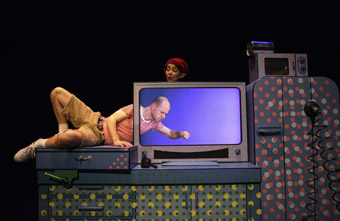
Jeff Michel, Sabrina D’Angelo, The Falling Room and the Flying Room, Terrapin Puppet Theatre
photo Sean Fennessy
Jeff Michel, Sabrina D’Angelo, The Falling Room and the Flying Room, Terrapin Puppet Theatre
TERRAPIN’S LATEST SHOW CONTINUES THE COMPANY’S INVESTIGATIONS INTO THE NEW REALM OF DIGITAL PUPPETRY. IN EFFECT WHAT YOU GET WHEN YOU SEE THEIR NEW SHOW, THE FALLING ROOM AND THE FLYING ROOM, IS A SORT OF EXPERIMENTAL THEATRE AIMED AT CHILDREN.
As with Terrapin’s Helena and the Journey Of The Hello, there are ‘Wow!’ moments where I was impressed by very clever devices and nicely thought through ideas. The strong, clear narrative drives everything: Samuel Paxton, a young lad with a lot of energy and imagination, is being somewhat ignored by his grumpy family, so he tackles their grumpiness, and his loneliness, by making a wonderful machine that contains special spaces—the falling room and the flying room. Sam makes his magical creations by ‘fixing’ old junk from the back shed. He’s a curious fellow who exhibits a streak of self-reliance and invention—he might even be an artist in the making.
Eventually Sam moves into the shed with a big screen he can crawl into and literally be on TV—transformed into pixels but still present. This is the digital puppetry terrain Terrapin is investigating—a highly choreographed effect whereby an actor’s arms can reach into a TV screen and be seen on it—like looking at someone reaching into a fish tank, or even climbing into it. Puppets drift in and out of this screen world as well in a deftly executed bit of theatre that excited me. It was pretty clever but, vital to the narrative, never an end in itself. Sam effectively discovers re-contexualisation as a way of of re-making the world and even making it a bit better, at least for him and his dysfunctional family.
In fixing all the broken stuff in the shed—magically making something better rather than simply restoring its former function—Sam repairs his family as well. They all get together and play with his crazy machines. The distant parents recall falling in love, remembering its importance and that doing things together is what a family does. There’s a kind of healing in this play about about human interaction that could be understood in the imagination-ruled world of an eight-year old child and by any adult.
The cast had a lot of work to do: Sam was brought to life by Jeff Michel while Sabrina D’Angelo played all the other characters including the family members and the elf Sabrina who guided Sam about, all the while never speaking or quite being seen by him. More than comic relief—with her silent asides—for a primary school audience, she seemed to me like the boy’s muse.
D’Angelo’s direct communication with the audience and Michel’s wandering into the auditorium reduced the somewhat distant staging at the Theatre Royal. The theatre is by no means cavernous, but The Falling Room and The Flying Room is an intimate show that wants strong contact with the audience to get the magic flowing. Luckily, the show is built to tour 40 schools across Tasmania, so up close is how most children are going to encounter Samuel Paxton, his family, his magic rooms and his sneaky elf pal in their endearing world.
Terrapin Puppet Theatre, The Falling Room and the Flying Room, director Frank Newman, writer Finegan Kruckmeyer, performers Sabrina D’Angelo, Jeff Michel, design Rachel Lang, puppets and props design Greg Methé, sound design, music Fred Showell, video animation Solid Orange, lighting designer Reuben Hopkins; Theatre Royal, Hobart, June 10, 11
RealTime issue #92 Aug-Sept 2009 pg. 44
© Andrew Harper; for permission to reproduce apply to realtime@realtimearts.net
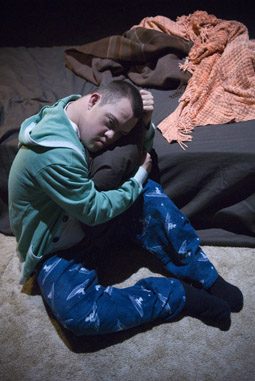
Andrew Pandos, Bedroom Dancing, Restless Dance Theatre
photo David Wilson
Andrew Pandos, Bedroom Dancing, Restless Dance Theatre
THE INTIMATE PRIVACY OF THE BEDROOM MAKES IT AN APPEALING—YET SOMEHOW DISARMING, EVEN UNSETTLING—SUBJECT FOR SPECTACLE. THE APPEALS OF EXPOSURE AND INSIGHT ARE GENUINE, BUT THE SENSE OF INTRUSION IS DIFFICULT TO SHAKE. BEDROOM DANCING FROM RESTLESS DANCE THEATRE EXHIBITED THE CONTENTS AND OCCUPANTS OF 15 BEDROOMS IN ADELAIDE’S GUTTED QUEEN’S THEATRE.
In the foyer, a video-installation from Lachlan Tetlow-Stuart invited spectators into bed with the cast. Spectators could snuggle up to a pillow and listen to sweet whispers from a speaker concealed within, while video projections of the performers one-by-one sprawled and rolled their way across the vertically-mounted double mattress. Inside the space, the audience were welcome to walk through and watch as bedroom scenes on adolescent themes were played out.
Evenly dispersed on squares of carpet—like booths in an exhibition hall, the beds were single and, for the most part, solitary. Their occupants were preoccupied with various choreographic tasks. Sleeping—even pretending to sleep—did not figure prominently in the work. Rather, the bedrooms were personal zones of retreat, their occupants engaged in world-making and connecting at a distance, communing with objects and media projections of stylised selves.
The mattresses and bedspreads—those soft, intimate technologies of comfort, warmth and enclosure—were, for the most part, misused and displaced. In one room, the bed itself was upended, the bed clothes spilling out in a twisted mess. In another upset gesture, the mattress became a trampoline in defiant memory of however many times a parent told us not to jump on the bed.
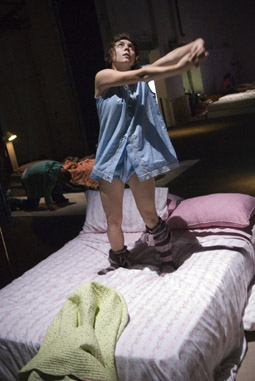
Kyra Kimpton, Bedroom Dancing, Restless Dance Theatre
photo David Wilson
Kyra Kimpton, Bedroom Dancing, Restless Dance Theatre
At an audio installation in the middle of the exhibit, one performer explained that “dancing in the bedroom is not what I usually do.” What distinguished each bedroom were the activities and technologies—some old, some new—of play and escape: a pair of dice, a jigsaw, some toy soldiers, a ukulele, a torch and a book, pencils and paper, travel magazines, a CD player, a radio, a laptop with Skype video-conferencing.
As a piece of dance theatre, Bedroom Dancing was a large-scale assemblage—a collaboration between 15 performers of the Restless Youth Ensemble and an artistic team comprising director Steve Mayhew, choreographer Alison Currie, designer Gaelle Mellis, sound artist Jason Sweeney and lighting designer Ben Shaw. It was also a project for a company in transition, initiated by outgoing artistic director Ingrid Voorendt and staged as incomer Philip Channells took up the role.
Presented as part of Come Out 2009, the Australian arts festival for young people, Bedroom Dancing attracted strong audiences over the course of a week. There were almost too many spectators at the performance I attended. Walking amongst the bedrooms and the crowd entailed an up-close relation of looking down at the performers’ work, which tended to individualise and isolate each bedroom as an exhibit in itself.
Instead of wandering from exhibit to exhibit, I found myself wanting to get down low and look across—to see and sense connections and relations across the array of bedrooms. But opportunities for a wide-angled, zoomed-out focus were difficult to grasp, until, cued by Sweeney’s sound work, the performance climaxed in a communal shudder.
Occasionally during the performance, some dancers visited each other’s bedrooms where they danced together for a while. These were welcome moments because they enacted a desire for contact to cut across the cell-like isolation of the exhibits. Prompted by memories of the adolescent loneliness evoked in this work, I felt a desire for more of these moments of connection across bedrooms.
Contact and connection are the hallmarks of Unreasonable Adults’ successful Gift/Back series. In its latest incarnation as part of Come Out, Unreasonable Adults invited young people to participate in the gift-exchange of supplying raw materials with which the artists make art. The artists called for gifts of a virtual, mediated or actual kind. Kids donated photos, drawings and paintings of themselves and their worlds. They also donated dolls, bears and cartoon characters, popsicle puppets, a clock, a billy cart and a large bag of rice, the names of some colours and some scraps of text. The artists’ undertaking was to use and respond to all they received.
The resulting mix-and-match process yields outcomes both inherently surreal and intimately connected to their audience. As an avant-garde approach to the making of art, the Gift/Back technique seems uncannily suited to a young audience. In creating opportunities for contribution, participation and recognition, it also models an artful ethic of re-use, re-cycling and re-invention which merits emulation.
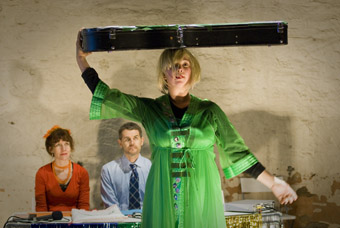
Julie Vulcan, Jason Sweeney, Kerrin Rowlands, Gift/Back, Unreasonable Adults
photo Sam Oster
Julie Vulcan, Jason Sweeney, Kerrin Rowlands, Gift/Back, Unreasonable Adults
At the performance I attended, the audience sat—cross-legged, of course—on squares of carpet in the Queen Theatre’s second space. We were addressed by the performers directly. The structural clarity of the work—with its step-by-step articulation of segments and an hilarious half-time break for orange slices and odour-ama—revealed an almost educational aptitude for engaging the audience in a process of aesthetic elaboration. I was taken by the work.
The look was colourful and bright. Three performers—Julie Vulcan dressed in orange, Kerrin Rowlands in green and Jason Sweeney in blue—performed a series of meditations on the value of colour in our world. Caroline Daish appeared remotely as an animated face. The set was as vibrant as children’s television. The mood was lively and engaging, the themes just slightly sinister.
Vulcan, addressing the audience in story-book mode, invites us to consider a world in which the colours orange, green and blue are replaced wherever they appear with dismal shades of grey. With excess affect, Rowlands dances in an apple-green negligee with a guitar case, the contents of which remain unrevealed. Intimate on live video, Sweeney tells a stick puppet story of lost children and croons a medley of blue tunes.
The work was intriguing, visually delightful and gently subversive with its imaginative narratives of abnegation and loss. The pleasures for an audience of young adults at the evening performance were apparent. The performers seemed ready to entertain, freshened perhaps by the afternoon performance to an audience of parents and children.
I attended the evening performance so I can’t say how the work played to children. But if I had taken a child or two I would have been grateful for their opportunity to participate in the artful reciprocity of Unreasonable Adult’s Gift/Back.
Come Out 2009: Restless Dance Theatre, Bedroom Dancing, devised and performed by the Restless Youth Ensemble, director Steve Mayhew, choreographer Alison Currie, design Gaelle Mellis, sound Jason Sweeney, lighting Ben Shaw; Queen’s Theatre, May 15-22; Unreasonable Adults, Gift/Back, Caroline Daish, Kerrin Rowlands, Fiona Sprott, Jason Sweeney, Julie Vulcan, Queen’s Theatre, Adelaide, May 29, 30
RealTime issue #92 Aug-Sept 2009 pg. 45
© Jonathan Bollen; for permission to reproduce apply to realtime@realtimearts.net
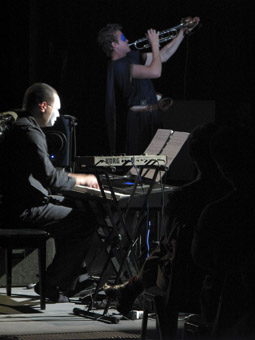
Michael Fowler, Tristram Williams, Act II, LICHT
photo SIAL Sound Studios (Lawrence Harvey)
Michael Fowler, Tristram Williams, Act II, LICHT
IN THE ATRIUM OF SYDNEY CONSERVATORIUM, A FANFARE DESCENDS FROM THE UPPER LEVELS, WELCOMING A MIX OF VISITORS AND AUDIENCES TO THE SMART LIGHT FESTIVAL’S STOCKHAUSEN PROGRAM, A DAY OF LIGHT. THE STARK MELODY, MARKED BY VISCERAL BREATH ACCENTS ON PICCOLO, ACCOMPANIED BY CLARINET AND BARITONE SAXOPHONE IS, HOWEVER, VASTLY DIFFERENT FROM A TRADITIONAL PUNCHY, OPTIMISTIC BRASS FANFARE. WHAT BEGINS IN THE ATRIUM CONTINUES ON IN AN UNRELENTING CYCLE, PUNCTUATED BY LONG SILENCES AND TURNING INTO A MUSICAL JUGGERNAUT, SEEMINGLY UNSTOPPABLE AND ALWAYS UNRESOLVED. THIS IS THE LICHT-RUFT (1995), THE EPIC FANFARE INTRODUCTION TO KARLHEINZ STOCKHAUSEN’S SEVEN-DAY OPERA CYCLE, LICHT (LIGHT).
An hour after it began, the fanfare did indeed prove to be unstoppable, as it continued to play while audiences were ushered into a small recital hall to hear two Stockhausen works performed by Ensemble Offspring. Setz Die Segel Zur Sonne (Set sail for the sun), delicately evolved from a contemplative opening ambience. Part of a series of text-based works titled Aus Den Sieben Tage (From the seven days, 1968), this piece was treated with necessary reverence by the performers. The works comprise vague yet poetic guidelines for improvisation, such as “play a note for so long/ until you hear its individual vibrations” and “…slowly move your tone/ until you arrive at a complete harmony/ and the whole sound turns to gold,/ to pure, gently shimmering fire.”
For a composer often identified as belonging to a European avant-garde known for treating every musical parameter with the utmost precision and detail, in this work Stockhausen demonstrates a fierce creativity and extreme openness in finding new musical terrain. In this rendition, the ensemble interacted through subtle sculpting of dynamics and blending of instrumental colour, resulting in a delicate balance and an ethereal quality, never dominated by an individual player.
Tierkreis (Zodiac, 1975), a series of melodies based on the signs of the Zodiac, represented a vastly different compositional approach, the melodic character a radical departure from the textural and atmospheric nature of the opening work. More traditional in comparison with many of Stockhausen’s works, and characterised by unusual scaleic materials and intervallic harmonies, Tierkreis was at times reminiscent of Stravinsky—sometimes haunting and simple, at other times driving and rhythmically complex.
Originally composed for three music boxes as part of a children’s theatre show, these pieces can be performed for any combination of suitable instruments. Ensemble Offspring’s rendition moved through a colourful array of instrumental combinations and playing techniques. Arranged for clarinets, flutes, percussion, piano, toy piano, accordion, melodica and celeste, this version was never dull as new sounds injected fresh energy into the piece throughout. Perhaps the most poignant moment was provided by the sound of a fragile solo music box, seeming all the more vulnerable when exposed by a single spotlight. There were dramatic elements too that breathed additional life into the performance—Clare Edwardes swinging a cowbell while walking through the space and Jason Noble marching around the stage performing a melody on his clarinet.
The creative interpretation of these works conveyed a sense of daring that seemed to be relished by Ensemble Offspring. This was a beautifully curated concert; the material well balanced and standard chamber music conventions interrogated.
The audience emerges into the Atrium, the LICHT fanfare continues. The juggernaut rolls on and already we sense the prolific, intense output of this composer.
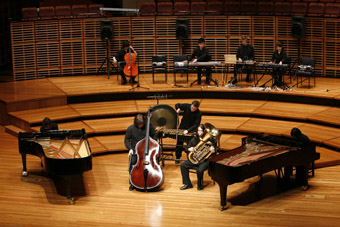
Licht
photo David Clare
Licht
Following Ensemble Offspring, The Song Company performed two works, taking us directly into the world of the opera, LICHT. The six-strong company were joined by six vocal students from the Conservatorium to perform Chor-Spirale, from Fritag aus LICHT (Friday of Light, 1994)—”six hybrid couples conceived as six candle flames unite into a single flame, spiralling up into heaven.” The use of glissandi and hissing added new colours to the conventional pallet of unaccompanied voices, and was executed with utmost precision under the direction of the curator of the Day of Light, Roland Peelman. As the piece evolved a solo bass and soprano moved respectively to the lower and upper extremes of their ranges. Towards the end, silences of increasing length added a new dimension, bringing with it a palpable tension.
From Sieben Lieder Der Tage (The Seven Songs of the Days), the Song Company then performed Montag aus LICHT (Monday from Light, 1986) adapted for six singers and piano. Each singer represented a day of the week and dressed in a corresponding colour. This visual element played out further as the singers, in two rows spread out across the stage, stood dead-pan waiting for their solos, all of which were delivered with dramatic poses or gesturing. Against this stark theatricality, the piano accompaniment—characterised by irregular rhythms and a chromatic spectrum of pitch material—maintained an ambling sense of flow.
The centerpiece of the day’s concerts was Act two from Dienstag aus Licht (Tuesday from LICHT, 1990-91), the Australian premiere of part of the cycle. In a darkened studio the work opened with an ominous electronic score. Drones, various timbres and occasional explosive gestures morphed and blended through an eight channel spatial mix, demonstrating Stockhausen’s remarkable skill in sustaining an homogenous texture over such a long duration. Perhaps this dark sound world is symbolic of the mountainside—the focal point in the story of the second act of Dienstag aus Licht.
Camouflaged by the similar pitch space of the electronic score, the sound of a trombone emerges from the mix and Lucifer, played by trombonist Ben Marks, enters. Moving around the stage, up one aisle, behind the audience, back down the other aisle and onto the stage again, all the while Marks performs fragmented phrases made more palpable by a set of gestures that point the trombone in different directions. The short phrases are punctuated further by occasional use of one of several mutes strapped to the player’s waist. It’s as if Lucifer is attempting to break through the mountain—the vast electronic score that continues to surround us. Although not presented in this modestly staged version, the mountainside is penetrated, revealing a metal wall. During a battle between Lucifer and Michael, played by trumpeter Tristram Williams, the wall disintegrates, revealing solid crystal.
A duet follows between the wounded Michael and Eva (Stockhausen’s variation on the biblical Eve), played by soprano Jess Aszodi. By now the electronic score modulates, allowing a greater depth of interaction between the performers and the score itself. Aszodi manages to successfully project her voice through a still very dense sound to blend with Williams’ trumpet. The unusual musical development of this extended piece was at times interspersed with extended techniques such as tongue clicks, whistling and inhalation sounds on the trumpet and might have been more succesful had Aszodi’s voice been amplified to bring greater clarity to these smaller sounds amidst the electronic wash. Nonetheless, her projection was remarkable under the circumstances. Both players conveyed a powerful stage presence through an extreme economy of physical movement.
The electronic score geared up once more and entered into another extended segue, this time in anticipation of Synthi-fou, a trickster figure who distracts the war-makers. Dressed in a multi-coloured robe and surrounded by a multi-synthesizer set-up, Michael Fowler performed this highly complex and intricate music with remarkable showmanship and ease. With manic laughter, over the top gestures and wide-eyed smiles, the eccentric performance culminated in Fowler standing to count down from 13, waving his hand with each count and slowing as he approached one. Synthi-fou’s broad pallet of sounds seemed to interact with and manipulate the electronic score, blending so well that it was, at times, hard to distinguish their source.
The fanfare, concerts, semi-staged opera extract and other events in Day of Light at the Con amply and admirably demonstrated over more than eight hours the epic nature of Stockhausen’s vision. Often the sheer duration of his works conveyed a force almost sufficient to intimidate even a curious and willing audience. As Andrew Ford remarked in his introduction to Ensemble Offspring’s program, Stockhausen’s creativity, now enjoying fresh recognition, was truly fierce and at his death in 2007, we lost a composer like no other.
Smart Light Sydney & Sydney Conservatorium of Music, A Day of Light at the Con, curator Roland Peelman, part of the Vivid Sydney Festival of Music, Light & Ideas, Sydney Conservatorium, June 6
RealTime issue #92 Aug-Sept 2009 pg. 46
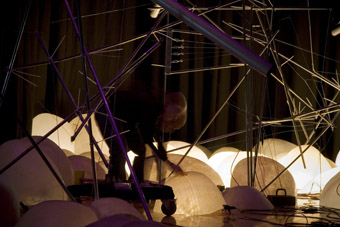
Plump, LA10 Sydney
photo Kazumichi Grime
Plump, LA10 Sydney
IT WAS SYDNEY LAPTOPPER ALEX WHITE WHO KICKED OFF THE FIRST CONCERT OF THE LIQUID ARCHITECTURE 10 PROGRAM AT CARRIAGEWORKS. HIS ARCHITECTURAL IMAGES WERE BUILT IN THE LISTENING SPACE FROM WHITE NOISE THAT ARRIVED, DISAPPEARED AND ACCUMULATED. IT WAS HARD TO LISTEN TO AT FIRST UNTIL HEARING ADJUSTED TO THE EMERGING SUBTLETIES WITHIN MULTIPLE SOUND-PIPES AND PULSES CROSSING TRAJECTORIES AND CAUSING A RUCKUS. VOLUME LEVELS WERE NOT HIGH BUT MY AUDITORY MEMBRANE STILL OSCILLATED WILDLY TO MAKE SENSE.
Surprisingly White had a couple of walk-outs but the work following him had most of us reaching for the ear plugs (supplied at the door) as West Australian musician Cat Hope alternately attacked and lulled the listener. Ear plugs were, however, no defence against an atmosphere pressurised and made tactile by imperceptibly low frequencies arising mysteriously from somewhere in the auditorium. Attuned perhaps to the ghosts of the funeral march Hope was interpreting, the body vibrated, depending on the particular frequencies she produced. These deep resonances were a long way from the silence notated (bars and staves only) by 19th century Chat Noir activist Alphonso Allais who inspired the work. He was long gone yet only traces of Hope’s physical presence were evident. Her apparition flickered across the video screen in indecipherably low-lit, live-feed images gradually providing clues to the nature of her concealment below the seating grid.
I found out later that we were hearing Hope’s bass guitar mediated by an array of effects and sub-woofer speakers. It was played variously by collisions with the seating superstructure or by simply coaxing sound out of it by more or less hitting parts of the instrument. This music was moving but not for the faint-hearted and many punters ran for it. The architecture felt the stress too with shockingly high pitched screams triggered in the lighting rig and mid-range metallic groans and murmurs vibrating in the seating structures. This Cat was playing the room, co-opting the building into her program and providing the most challenging work in this year’s Sydney concerts.
A little easier on the body was Bradbury. The image of a wax light was projected as beautiful bell sounds began the first of about nine pieces. Bradbury has a unique, recognizable style favouring short pieces and often re-moulding material into beats or reconfiguring field recordings into new contexts. One piece mixed a Jimmy Saville style TV shopping salesman and flat piano tones with delay drenched loops transforming from humour into a poignant statement about commercialism.
The clarity of Bradbury’s video projection was replaced for Thomas Köner’s piece by more obscured objects. It would take Imax technology for Koner’s projected images to successfully match up to the enormous spectrum of sound he created. The looped vision of a metro train journey and various ghostly humans superimposed onto similarly smeared locations became a puzzling distraction from the immersive engagement of his sound world. I greatly enjoyed the intriguing aestheticisation of the everyday via the overheard but indistinct human voices set amidst grand, airborne sonic gestures. At one point a passing jet seemed to have entered the space even though the expected decay of its passing was never realised.
Köner’s approach shared some aesthetic points with Asmus Tietchens who closed the Saturday concert. Tietchens as one of the innovators of electronic music in Germany has had an enormous influence on the form since the 1970s. He created a wonderland of sound, layering frequencies in a concerto supported by a riveting bottom end through to high-pitched ringing with occasional bursts from every register in between. Machinistic throbs were sunk into hypnotic ground and opposed by sudden fanfares which were then subsumed into the underlying pulses. The composition was very finely crafted, working with rhythmic oscillations and many unidentifiable and peculiar creations constantly reconstituted by Tietchens’ settings. Attention to detail was as delicate as the harpist’s stroke, one of the transitions dropping down into an almost inaudible range.
Unlike Tietchens and his colleagues of the men-at-tables ilk, Plump explored the sound qualities of a sculptural installation they had constructed over the five hours preceding Saturday night’s concert. It took up most of the performance area of the theatre. They played a surprisingly restrained set considering the scale of the instrument—a series of angular but asymmetrical suspensions of cable and scaffold-like aluminum. All this was complemented by a dozen or so randomly placed, mis-shapen light shades about the size of physio balls. Marc Rogerson controlled these from upstage by using hand-held arcing low-voltage contacts across a live power board. Philip Samartzis began with soft cricket whispers yielding eventually to many clangs and cries from Dave Brown’s bowing and tapping. Ringing, cello-like laments combined with electronic interpretations of sounds picked up from various contact points around the structure and processed by Samartzis. We could have been witnessing the capture of the musician by some terrible arachno-robotic figure as Brown provoked and stroked the beast variously by hammer and bow to produce ‘architectural’ music par excellence.
Opening the Saturday night concert alongside the imposing Plump sculpture, Somaya Langley was a diminutive figure in her suit of triggers and hanging projection surfaces. Her piece was, however, underwritten by some big ideas and the modulated swoosh and crash of her limbic sound-triggering produced some tasty sonic onomatopoeia.
Whirlpool (Chris Abrahams playing pedal harmonium and Kraig Grady on prepared vibraphone) followed Plump after the interval looking more austere but drawing from an enormous tonal pallette. Once acoustics had been contained by the ‘curtaining’ of the perimeter walls, the ringing began. Grady had repositioned the vibes’ metal bars unconventionally to create beautiful dissonances, enthralling beats and strange harmonies. They cut across and embedded themselves into the drones provided by Abrahams and it was hard to believe at times that they were both completely acoustic. Some of their discords struck disturbing resonances even in (or perhaps because of) the cavernous spaces of CarriageWorks. The piece was like an amalgam of gamelan with early Moog music as Abrahams demonstrated his penchant for extracting sonic modernity from pre-electronic keyboards.
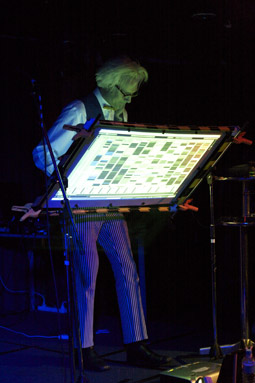
Marc Gunderson, LA10 Sydney
photo Kazumichi Grime
Marc Gunderson, LA10 Sydney
As compere Brent Clough noted, we were “sopping wet with sound” after these two concerts so it was hard to muster enthusiasm for DJ-driven music. But the 10th anniversary after-party at Hermann’s Bar (complete with a profiterole stack) also contained some unexpectedly exciting sound art. Best of these for me was Buttress O’Kneel (sic) who intervened with marvellous invention into some well-known pop using effects pedals to alter musical states in extreme ways. As ‘his’ androgynous mask and wig messed with our minds, his mix attacked Stairway to Heaven, the themes from Skippy and Sesame St not to mention the Australian national anthem—no cow was too sacred for deconstruction. This work would have easily fitted into the concert context—extraordinary found-sound noise art.
But it was the great humour of The Evolutionary Control Committee and the wonders of the “Vidimasher 3000” that rocked the room from the moment Mark Gunderson indicated that he had “got our attention.” He struck quite a figure with his Warholesque shock of peroxide hair and a goatee nearly reaching his sternum. Gunderson was attached to the Vidimasher 3000 via light triggers wired up to his fingers which controlled projected click buttons on a large canvas-like screen. In his capable hands this great showman DJ took us on an exciting journey via the most improbable combinations of songs. They were collapsed into Gunderson’s mixes in such a way that the uninitiated might assume them to be the originals: Led Zeppelin dueting with Hip-hop, La Belle with Dire Straits, Brittany Spears and Kermit the frog with the Jackson 5. All were twisted into a laudable and audible logic with other familiar beats and riff samples and subsumed into new creations with five or six layers of “copyright violations.” An exciting finish to a very sound weekend.
Liquid Architecture 10, Sydney directors Jennifer Teo, Shannon O’Neill, CarriageWorks, June 26, 27; Anniversary, Hermann’s Bar, Sydney University, June 27
RealTime issue #92 Aug-Sept 2009 pg. 48
© Tony Osborne; for permission to reproduce apply to realtime@realtimearts.net
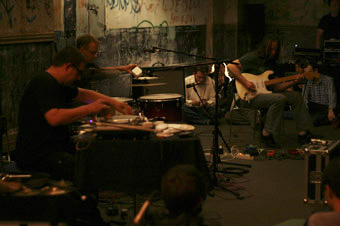
Perlonex, LA 10, Brisbane
photo Bryan Spencer
Perlonex, LA 10, Brisbane
NIGHT ONE. LONG NARROW ROOM, CUSHIONS ON THE FLOOR, A WELL DESERVED ROUND OF APPLAUSE AS LAWRENCE ENGLISH REMINDS EVERYONE THAT THIS IS THE 10TH ANNIVERSARY OF LIQUID ARCHITECTURE. A WOMAN AT THE FRONT DESK ASKS MY SON IF HE WANTS EARPLUGS. HE LEANS OVER TO ME AND ASKS, “WHAT SORT OF CONCERT NEEDS EARPLUGS?” ONE THAT IS, AT TIMES, FAR TOO LOUD. MAYBE AT TIMES LOUD ENOUGH TO CONSTITUTE ASSAULT AND LOUD ENOUGH TO CONTRAVENE APPROPRIATE CODES OF CONDUCT AS LAID DOWN BY SOMEBODY SOMEWHERE. I DON’T KNOW. WHEN IT GOT LOUD I CLOSED MY EARS, ALL THE BETTER TO HEAR ANOTHER DAY.
Perlonex (Ignaz Schick, turntables and electronics; Jörg Maria Zeger, electric guitars; Burkhard Beins, percussion) have been around for about a decade. Before things begin they ask for the air-conditioning to be turned off and then start soft, well below the noise floor the aircon had set up. Beins uses a small kit—drum, cymbal. He rubs something, maybe a rattle, around the drum head—friction drumming—and sets up a soft, sibilant drone. The rhythm is understated, a cyclical wave of changing amplitude. Cymbals hiss. Schick adds hints of electronics and underneath and barely perceptible Zeger plays a gently pulsed tonal wash on guitar. Homogenous ensemble playing, a single rich texture. Slow build up (unavoidable cliché of ambient music?), then ear-split into some ugly sounds, then slow relax. What’s the zeitgeist around this (pleasant ramps up to awful ramps down to release)? Is it disappointment? I thought life’d be good but it turned out nasty? Dunno, but there’s a lot of it about.
Asmus Tietchens and Thomas Köner each had solo sets on the second night. But on the first night they played together as Kontakt der Jünglinge. A no fanfare start. Crowd milling in the foyer hubbub and a drain gurgle looping a metrical pulse. Old school musique concrète, very tape, layers of field recordings and heavily processed/synthetic sounds. (Is there much of a difference between processed real and fully synthetic sounds now that sophisticated signal processing is a free download away?) The Stockhausen tradition comes through in the sequencing of quite abstract sound into coherent musical gestures. Volume is perfectly placed to let ambient and close miked recordings of different acoustics create spatial depth. Sub bass reminds us of the resonant properties of our body cavities. The bump and looping gurgle of the beginning comes back, decays into the noise floor of the air-conditioning. Exit.
Night the second. I arrive a little early to check out the two installations. Eugene Carchesio has a small piece, a few blinking lights in what looks like a jewellery display case. Unfortunately the piece gets lost in the space. Scott Arford has a sound+projection piece. Wide screen movies of bleached out and light-flared industrial scenes plus manipulated field recordings taken at the same industrial sites. The manipulation is minimal—underlying bassy drone, large metal doors being slammed, truck reversing beeps, chutes and engines. Each short piece is introduced by a black screen with a number—like a catalogue capturing industrial phenomena before it disappears.
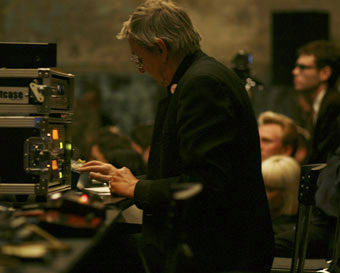
Asmus Tietchens, LA 10, Brisbane
photo Bryan Spencer
Asmus Tietchens, LA 10, Brisbane
Asmus Tietchens begins with filaments and layers of filtered noise. Occasional glitches burst then decay into hiss. Then the hiss slows to a crackle, drones give way and the crackle becomes marbles dropped into a jar. Each glassy plink dilates to become pitched and tonal. The smooth transformation of sounds, blended, layered and free-form looped; the varying scales of activity—from microsound to gesture to section—modulates our attentional focus into specifics and then away into layers of abstraction. Work that comes from a lifetime of listening and compositional refinement.
Thomas Köner presents video+sound in his solo set. A train slowly circles on an elevated track in a nondescript city—empty station to empty station. Unseen crowds murmur over a low and mournful tonal progression. The video floats, is blurred, solarised, fades in and out. Muted and grey, alien, slashes of garish colour; is the city real? Modelled? Second section and the sounds of mild explosions. People move slo-mo across the screen, outlined and hollow like cells under the microscope, sometimes they are opaque enough to hint at faces, the patterns of clothing. One person stands still for a while, slightly hunched, facing the camera, facing us. Implied accusation: Why are you there when we are here?
The setting looks architectural, but abstract, maybe a garden centre with stacked pots, maybe something completely different. It is hard to tell; there is obviously a meaning to the environment but that meaning is completely opaque—you just know there is a meaning there that you will never understand. It is as if one is profoundly outside, witnessing the residual echo of an unfathomable civilisation. More and more people appear, still ghostly, but now layering over each other. And instead of walking across the scene they start coming towards the camera, leaving traces of their paths, a history, glimpses of faces, parts and details, moving and layering until the screen looks like bitumen after the rain. Thunder cracks. Fade out and fade in to landscapes framed like a first-person homunculus staring out from the back of the skull. Fade again and back into the endless empty journey of the beginning. The train grinds to a halt, fades out, fades in to an urban wasteland. A child’s voice, an aimless dog. Clumps of stringy weeds and an abandoned access road, gravel pressed into the dirt. Traces of people walk past. The image fades one last time. A train sounds. A chord. Sub bass vibrates the room and is gone.
Liquid Architecture 10, curator Lawrence English, artists Joel Stern, Asmus Tietchens, Thomas Köner, Kontakt der Jünglinge, Jason Kahn, Perlonex, David Shea and Kristi Monfries, Plump (Dave Brown, Philip Samartzis, Marc Rogerson), Eugene Carchesio, Scott Arford; Brisbane Powerhouse, July 3-4
RealTime issue #92 Aug-Sept 2009 pg. 48
© Greg Hooper; for permission to reproduce apply to realtime@realtimearts.net
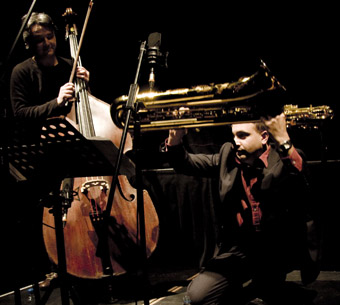
Mark Cauvin, Adam Simmons performing Syd Clayton’s “Yehudi”
photo Louise Cooper
Mark Cauvin, Adam Simmons performing Syd Clayton’s “Yehudi”
A DECADE IS A LONG TIME IN THE WORLD OF EXPERIMENTAL MUSIC AND SOUND, AND THE STAYING POWER OF THE ANNUAL LIQUID ARCHITECTURE FESTIVAL IS A TRIBUTE TO THE ORGANISERS, ARTISTS AND AUDIENCES WHO ENTHUSIASTICALLY SUPPORT IT. AROUND AUSTRALIA, THE ANNUAL LA SERIES OF CONCERTS, FORUMS AND WORKSHOPS SHOWCASE THIS FIELD AND ALSO CONTRIBUTE TO ITS DEVELOPMENT. IN MELBOURNE, LIQUID ARCHITECTURE CELEBRATED ITS 10TH SEASON WITH AN EXCELLENT PROGRAM OF NEW AND RECENT WORK BY LOCAL AND INTERNATIONAL ARTISTS, AND THE PRESENTATION OF SOME LEGENDARY PIECES, NOTABLY EDGARD VARÈSE’S POÈME ÉLECTRONIQUE.
friday july 10
The emphasis in the Friday night concert was on listening attentively in a darkened space, and it opened with the enchanting and gentle work of Hamburg-based Asmus Tietchens. Since he began in the mid-1960s Tietchens has become a senior figure in European sound art, working outside any specific genre and often collaborating with other artists. His piece begins almost inaudibly, simple lines drawing your attention, and soon you notice additional voicing bringing complexity and depth as you enter a relaxed state of awareness. The music seems spontaneous and fluid, and you forget how it is made and just absorb it. This is perhaps the hallmark of good sound art, indeed of any interesting sound. While technological change, such as the development of computers, has affected the process of making sound, in the best works musicality is retained.
A memorable performance by the established local duo of Anthea Caddy (cello) and Thembi Sodell (sampler) followed. Contrasting strongly with Tietchens’ subtle and understated ambience, Caddy and Sodell’s intense and expressionistic work is characterised by huge dynamics, strong textures and dramatic pauses. Theirs is a unique sound, blending acoustic and sampled elements and underpinned by strong live performance, adding a freshness that is sometimes absent from the calculated presentation of pre-programmed work.
Jason Kahn’s work appears to involve manipulating feedback to produce a dense and intense body of sound. His apparatus includes a sensitive microphone placed close to the skin of a bass drum mounted on its side, and a radio whose untuned static is fed into a synthesiser with the miked sound. Kahn sits in the middle of the auditorium within touching distance of the audience, and holds a steel plate or a small cymbal just above the drum skin, subtly changing the sound by moving the object slightly. Sitting one seat away, I was one of the few who could hear a little of the unmediated sound direct from these objects. This created a fascinating effect as the sound through the PA built up. The sound evolves only slightly and gradually during the performance, so you concentrate on subtle variations; Kahn’s poised minimalism was distinctly different from the complex works that preceded it.
Tietchens reappeared with Thomas Köner as the duo Kontakt de Jünglinge, whose name pays homage to Stockhausen, and whose music is again gentle and subtle, developing in complexity as it unfolds. Their work has a maturity born of decades of development and thought. Afterwards, LA Artistic Director Nat Bates aptly described their piece as work of “glacial delicacy and restraint.” The final work of the evening was a performance by Berlin trio Perlonex—electric guitar with effects pedals, percussion and an electronically mediated turntable plied with all manner of objects. Their carefully prepared piece began quietly and gathered in intensity, with the acoustic elements combining with multiple layers of morphed sound, again emphasising live performance.
saturday july 11
Whereas the program for the first night focused on aural experience, the second concert showcased the use of sound to support, or contradict, visual experience, and also looked back to the beginnings of sound art and experimental multimedia. First we were treated to a rendition of the late Melbourne sound artist Syd Clayton’s composition Yehudi (1968). As the audience filed into the auditorium, two people were seated at a small table near the stage, chatting. The audience waited and waited and eventually the two performers—Mark Cauvin (double bass) and Adam Simmons (bass saxophone)—picked up their instruments. The performance unfolded as a mixture of mime and unconventional playing, with nonsensical physical gestures, hoots and grunts and included a tea break in which the performers discussed the piece, boiled a kettle and asked audience members for a cigarette. This is comic theatre that comments seriously on the limitations of conventional musical performance.
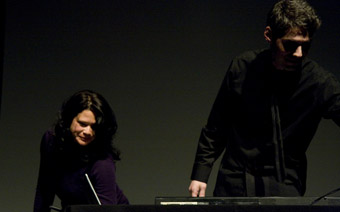
Kristi Monfries, David Shea; LA10 Melbourne
photo Louise Cooper
Kristi Monfries, David Shea; LA10 Melbourne
Another work with an historical thread followed—Kristi Monfries and David Shea’s video-sound work, the Art of Sampled Memory, that looked back at the work of Canadian experimental film-maker Arthur Lipsett. Lipsett edited the off-cuts of others’ films—mainly fragments of newsreels and documentaries—into collage works that critiqued contemporary society. Monfries and Shea re-edited Lipsett’s work and added their own sound to pay homage to his concept. Lipsett typically added sound that was irrelevant to the imagery to upset the relationship between the two, satirising the story. Monfries and Shea’s second work, Liquid Architects, commissioned by the festival for its 10th year, was a collage of videos of LA performances from previous years, showing visually enhanced fragments of performance with a contrasting sound overlay. In both works, Shea controlled the sound live, sitting centre-stage, positioning the artist as an active and visible element of the product. This was absorbing work.
Next was Thomas Köner’s moving, eloquent and very beautiful video and sound work La Barca. Köner, who performed in LA3 in 2002, has produced soundtracks for old silent films, and this work had the feel of decaying silent-film stock. The video slowly panned a deserted cityscape, shown in grey tones, positioning the audience as remote observers on a train moving inexorably through a post-apocalyptic world. Köner’s soundtrack is suitably dreamy and desolate, incorporating sampled voices and instruments. The evening concluded with a completely different audio-visual work, Plump (Marc Rogerson, Dave Brown, Philip Samartzis) ensemble’s performance involving a huge metal framework fitted with contact mikes and incorporating wires that could be bowed and plucked, set up amongst a series of sculptural forms illuminated from within and also connected to the mixer. The performer used an array of familiar objects to play this extended and highly tactile instrument.
sunday july 12
At the Melbourne Planetarium, the program included two engaging works by graduates of the RMIT University sound program, Que Nguyen and Lizzie Pogson, a delightful work by French pioneer of Musique Concrète and sometime LA associate Bernard Parmegiani, and Edgard Varèse’s Poème Électronique (1958). The afternoon concluded with Robin Fox’s very visual Photosynthesis (2004), created by feeding an audio signal into a cathode ray oscilloscope. Poème Électronique was a landmark work, developed for presentation in the Philips pavilion at the Brussels World’s Fair, combining synthesised and recorded sound with projected imagery in a purpose-built space designed by Xenakis and Le Corbusier to explore the possible relationships between sound, vision and architectural space. RMIT University senior lecturer Lawrence Harvey introduced this realisation of the work, outlining the background to the original project, its philosophical intent, and an overview of the history of sound art.
Liquid Architecture has grown from a student union event at RMIT University into a national festival that showcases the best national and international sound art (see Gail Priest’s interview with Nat Bates, RT91). The audience includes listeners at all levels of sophistication, and, importantly, artists and others professionally involved with the field. Paradoxically, presenting LA as a festival locates it within the mainstream, though sound art is energised by its experimental, critical and therefore marginal nature. So far, it has successfully operated on both fronts, complementing the range of contemporary concerts available while maintaining a critical distance. The internet now also provides a forum for dialogue and presentation, one with an almost infinite and thus unnavigable capacity. However the structured format of Liquid Architecture focuses programming and ensures vitally important curatorial direction. It is to be hoped that the festival continues to grow and develop.
Liquid Architecture 10, artistic director Nat Bates, Arts House, North Melbourne Town Hall, July 10, 11; Melbourne Planetarium, July 12
RealTime issue #92 Aug-Sept 2009 pg. 49
© Chris Reid; for permission to reproduce apply to realtime@realtimearts.net
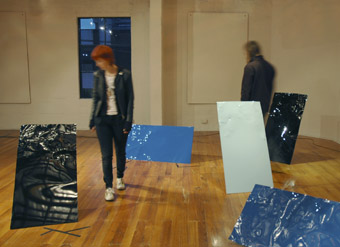
Space Shifter, David Chesworth, Sonia Leber, Conical Gallery
image courtesy the artists
Space Shifter, David Chesworth, Sonia Leber, Conical Gallery
AS YOU ASCEND THE NARROW STAIRS TO CONICAL GALLERY, YOU OVERHEAR A JUMBLE OF VOICES—SQUEALING, GROANING, CRYING, LAUGHING AND SINGING, SOMETIMES IN CHORAL HARMONY, SOMETIMES MIXED AND MORPHED, AND CONTINUOUSLY RISING AND FALLING. ONCE INSIDE, YOU ARE GREETED BY THE VISUAL ELEMENTS OF SPACE-SHIFTER—10 RECTANGULAR SHEETS OF METAL, EACH ABOUT 60 X 150 CM, PROPPED UP ON THE FLOOR AT AN ANGLE, EITHER SIDEWAYS OR LENGTHWAYS. FIVE PANELS ARE GLOSSY BLACK, THREE ARE A PALE OR MAYBE SKY BLUE, AND TWO ARE A DARKER BLUE. THE PAINT IS CAR DUCO, CLEAN AND SHINY, BUT EACH PANEL BEARS NUMEROUS DENTS AS IF IT HAS BEEN BATTERED FROM BEHIND WITH A SHARP, HEAVY INSTRUMENT, AND THE DUCO APPLIED AFTER THE BEATING TO SEAL IN THE MARKS.
In a corner of the gallery is an inverted metal bowl, about two metres across, tan or khaki in colour. Prior to painting, the bowl has also been dented and then roughly cut into 3 pieces to make it look cracked, like crockery or an eggshell or perhaps like a military helmet bearing fatal damage; and it is intriguingly bent at one edge to suggest it has been thrown vigorously into the corner of the room.
Space-Shifter thus presents a series of riddles for the viewer-listener. The sound comes primarily from four loudspeakers mounted high out of sight in the corners of the room, and the signal moves suddenly back and forth between the speakers, detached from any specific location. This dialogue is augmented by low rumbles that come from some of the metal panels, which turn out to have transducers attached, and even from the floor itself. Initially, you wonder if your presence is triggering the abrupt changes in the dynamics or direction of the sound (a strategy that is almost expected these days). But it turns out that you’re hearing a pre-recorded multi-channel tape loop of a choir (the Royal Melbourne Philharmonic Choir), and there is a large transducer attached to the floor that creates the subtle resonance you feel in your body. The work recreates the cacophony of the mind, recalling extreme emotional states. Ultimately, the sound is disembodied—shifting—so that, as you locate yourself in visual space you lose your bearings in aural space, creating feelings of uncertainty and even dread.
The metal forms initially seem disconnected from the sound. They occupy and disrupt the gallery space, drawing upon the idea of minimalist sculpture in the form of iconic shapes and colours. They suggest industrial fabrication bearing the signs of damage through misuse and abuse. The colours suggest fundamental substances such as oil, earth and air, or darkness and light, but represent a civilised world whose scars are painted over. And they are loudspeakers voiced as instruments, as is the gallery itself, to distort the sound. Overall, Space-Shifter functions as an audio-visual Rorschach inkblot in 3D. This is conceptual art that works in cycles of evaluative and experiential contemplation, testing the pull of our own subjectivity.
Visual artist Sonia Leber and composer David Chesworth have collaborated on numerous projects over many years, creating immersive environments, sometimes in public places, as in 5000 Calls (Sydney Olympic Park, 2000) and sometimes in the closed environment of the art gallery. They frequently use recordings of vocal sounds as an index of human activity and emotional reaction, sometimes recalling Hugo Ball’s Dadaist recitations at Cabaret Voltaire, and even the Tower of Babel. The Space-Shifter composition is best absorbed with eyes closed, even though this temporarily occludes the sculptural component of the work, as principal vocalists Jerzy Koslowski and Deborah Kayser contort their voices to create an intense aural drama. Ideally, you listen alone, but if other viewers are present, their whispering and shuffling merge into the soundscape.
In the program note for Space-Shifter, Leber and Chesworth suggest that the work is a psychogeography of voice and space. Psychogeography was a theme of interest to Guy Debord of the Situationniste Internationale movement of the 1950s, which critiqued urban life. Debord was especially concerned with the ways architecture locates and defines the individual in psycho-social space, a recurring theme in Leber and Chesworth’s art. Their notes also refer to our feelings of metaphysical anguish on hearing a disembodied voice, particularly a voice whose utterances make no sense. The human voice is the central element in this work, mimicking the tones of your own internal dialogue with all of its fears, desires, laughter and grief. The sound-track by itself is troubling enough, but the addition of the sculptural forms, signifying architecture that speaks, makes the work that much more harrowing.
Sonia Leber & David Chesworth, Space-Shifter, Conical Gallery, Melbourne, May23-June 13
RealTime issue #92 Aug-Sept 2009 pg. 50
© Chris Reid; for permission to reproduce apply to realtime@realtimearts.net
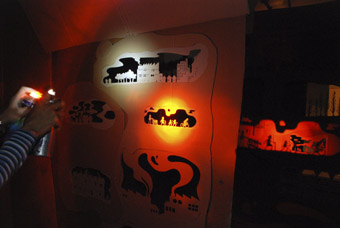
Ghost Train, Ned & Tom Sevil
photo Garth Knight
Ghost Train, Ned & Tom Sevil
“THERE GOES THE NEIGHBOURHOOD!”, TAUNTED THE US BLACK HEAVY METAL BAND BODY COUNT IN THEIR 1990 SONG, AN IRONIC TAKE ON THE PHENOMENON OF ‘WHITE FLIGHT’ IN AMERICAN CITIES AT THE TIME (THE SONG ALSO DRAWS AN ANALOGY BETWEEN THE PERCEIVED BLACK ‘ENCROACHMENT’ OF WHITE SUBURBS AND THE BAND’S ENCROACHMENT OF THE TRADITIONALLY WHITE DOMAIN OF HEAVY METAL).
The title thus frames this Performance Space exhibition squarely within the politics of contested space and the central role of race (and youth) in this contestation; it also widens the frame of reference beyond the here and now of Sydney, Australia, to shared histories and their legacy for contemporary urban living globally. This breadth of scope marked every aspect of the exhibition, from the range of artists and media, to the scale, both spatial and temporal, of many of the works. Participants hailed from across the globe, including Brazil, Spain, Denmark, US, Australia and Hungary; the range and scale of works was expansive: photographs, video, painting, installation, mapping, networked activities and performances, many either filling the gallery in innovative ways or overflowing it altogether through their presence in publication, on the web, or as external events extending over time. This scope was thoughtfully designed to reiterate the themes: spatial justice and the place of the artist in articulating and complicating these debates and strategies.
The curators (both members of an artists’ collective engaged in social and spatial mapping) did well to balance the push and pull inherent in capturing the complex and dispersed nature of the theme in a cogent and coherent exhibition. The gallery space itself is difficult, notorious for its cavernous dimensions that favour works of monumental scale, yet this very problematic appeared to be integrated and interrogated in the exhibition; the open and loose installation in the foyer of the CarriageWorks building echoed the grassroots/shopfront register of the theme, while also foregrounding the improvisational and small footprint approach taken by many artists practicing in this field. The publication of an accompanying book—which contextualizes the exhibition much more broadly than a conventional catalogue with historical essays on specific contested areas (including Redfern), interviews and theoretical discussions on both individual works and the wider issues around the impact of gentrification—is also an effective means of both containing and disseminating the themes. This is indeed an excellent anthology of benefit to a wide, interdisciplinary readership.
One of the most engaging works here was created by Australians Tom and Ned Sevil, aka The Evil Brothers, self-described as “divided by 5,000 kms of dirt and living on opposite ends of the country yet…connected through their checked [sic] history of making art on the street and their love of working in abandoned and forgotten spaces.” This ‘down home’ sensibility permeates their installation, Ghost Train, a simulated cityscape constructed out of cardboard. The viewer is invited to take a spray can that doubles as a lamp, and pick their way over tiny railway sleepers into what appears to be a dynamic shadow play of miniature city scenarios, although it is the viewer’s own movement (and imagination) that effectively animates these cut-outs. Through the simplest of technologies, and by also cleverly invoking the haptic, the work immersed the viewer in alternative perspectives of the city—a graffiti artist ‘writing’ the city’s underbelly at night, an urban planner constructing machines for living, a child playing ‘house’, a homeless person improvising a shelter. The work powerfully reminds the viewer of their own agency in creating and imagining urban spaces.
The construction/destruction of homeliness through the strategic occupation of space is also at the heart of the work by Chicago-based collective Temporary Services, whose interventions often take the form of public surveys designed to give voice to communities not fully consulted in the urban planning process. In Sydney, Temporary Services conducted a Public Sculpture Opinion Poll on Bower (2007-2008), the sculpture by Susan Milne and Greg Stonehouse installed on a prominent street corner in Redfern. Despite the creators’ participation in community workshops where local stories were gathered for integration into the work, the sculpture, described by one architect as “overscale and incongruous”, has polarized community opinion. Temporary Services, themselves without an agenda, in effect gave the complexity of the community’s response a compelling airing—with comments gathered on public clipboards and email installed in hard copy in the gallery or accessed on a dedicated website, the locals were heard in a far more public way, giving the viewer a fascinating insight into grassroots perceptions of the intersection between government, art and public space. One response read, “In my opinion this sculpture is inappropriate for the area. Those spikes and sharp edges suggest belligerence and seem to induce anxiety. Sharp edges, shooting projections, spikes are too aggressive for the area which has always been somewhat ‘on edge’” (May 15, 2009). The public debate facilitated by the artists’ intervention produced material worthy of serious consideration by policy-makers.

Shane Phillips & Noel Collett, 1992, from the series Conference Call, Brenda L Croft (in collaboration with Adrian Piper)
courtesy the artist
Shane Phillips & Noel Collett, 1992, from the series Conference Call, Brenda L Croft (in collaboration with Adrian Piper)
A strong self-reflexive impulse pervades much of the work in this exhibition, whose curators are also keenly aware of their own position in the politics of gentrification (including the argument that artists, through re-valorizing degraded spaces, often pave the way for the property speculation that accompanies ‘urban renewal’). This self-reflexiveness is particularly potent in the Spanish art collective Democracia’s video installation Images from the Welfare State (Smash the Ghetto) (2007) that features footage of the official razing of what was renowned as Europe’s largest shantytown, on the outskirts of Madrid. Democracia heightened the spectacular appeal of this event by projecting the images on three mural-sized screens and inviting the Sydney audience to sit on bleachers set up in the gallery, in the same manner as the original spectators watched the actual demolition. The work evokes the long history of the state smashing housing deemed unlivable under the auspices of regeneration—from the notorious implosion of Pruitt-Igoe to the massive pre-Olympic ‘clean-up’ of cities in the late 20th century, to the bulldozing of Palestinian settlements. But, perhaps more potently still, the work renders the viewer complicit in such destruction by foregrounding the visual pleasure we derive from watching such spectacle, with its intense drama and its promise of the ‘clean slate.’ As witnesses to the erasure of someone’s neighbourhood, we become aware of how the apparatus of spectatorship, while promising us complete immersion, instead distances us from this reality.
What renders these works so effective is their ability to transpose a complex set of ideas through a direct form of aesthetic engagement: the Holy Grail for art that seeks to be political. This exhibition was very successful in honouring the dispersed nature of artistic interventions in urban space, underlining the pressing nature of the politics of gentrification and reminding viewers of their own participation in these politics.
There goes the neighbourhood. Exhibition curators Zanny Begg and Keg de Souza, artists Daniel Boyd, Brenda L Croft, Lisa Kelly, SquatSpace, You are Here, 16beaver, Temporary Services, Michael Rakowitz, Claire Healy and Sean Cordeiro, Evil Brothers, Miklos Erhardt and Little Warsaw, Jakob Jakobsen, Democracia, BijaRi, and a re-enactment of Allan Kaprow’s Push and Pull: A furniture comedy for Hans Hofmann; Performance Space, CarriageWorks, Sydney May 23-June 17
RealTime issue #92 Aug-Sept 2009 pg. 52
© Jacqueline Millner; for permission to reproduce apply to realtime@realtimearts.net

Kissing Project (video still), 2009, Julie Traitis, Intimate Acts
photo courtesy the artist
Kissing Project (video still), 2009, Julie Traitis, Intimate Acts
THE SUBJECT OF INTERPERSONAL INTIMACY WOULD AT FIRST APPEAR TO BE A DIFFICULT ONE FOR CONTEMPORARY ART, SINCE GALLERY SPACES ARE SO TREMENDOUSLY CONTROLLED IN THEIR MECHANISMS OF PRESENTATION. LITTLE IS LEFT TO CHANCE, AS ARTISTS AND CURATORS CAREFULLY MANUFACTURE A RELATIONSHIP BETWEEN VISITORS AND ARTWORKS. IN PICA’S SHOW INTIMATE ACTS, THE BEST WORKS EXPERIMENT WITH THE LIMITS OF THIS CONTROL, AS THEIR PERFORMERS PLACE THEMSELVES IN AWKWARD SITUATIONS.
Thus in Smith/Stewart’s Mouth to Mouth (1995), Stewart is submerged in a bath, and is only able to breathe because Smith leans forward to exhale her own air into his mouth, between his bubbling outward breaths. It is this meeting of mouths that keeps Smith alive. In Patty Chang’s In Love (2001), two screens show the artist kissing her mother and father, their open mouths sharing an onion between them. Their faces turn from tears to disgust to something else, some undefined experience known only to the kissers. These works greet us as we walk into the show, and set an edgy standard. They evidence great control on the part of the performers, as they bring themselves into close contact with life-giving forces.
Such intensity is also at work within Futoshi Miyagi’s photographs of his meetings with internet dates, the Strangers series (2006). The photographs are taken in his date’s apartment or house, and show him in proximity to the stranger he has just met. In some images they are touching, in others he stares out the window or at the wall as if adopting the gaze of the stranger. These images are not, however, the kind of verite documentation that we might expect of a liberal lifestyle. The shots are instead tremendously composed, as the strangers assume postures for the camera. There is a sense of danger about Miyagi’s project that is ultimately controlled by intense performativity. Strangers and artist alike perform themselves, staging their own situation. It was Jean-Paul Sartre in Being and Nothingness who most succinctly described the self-consciousness of performing the self. Sitting in a park, he became conscious not only of being looked at, but of seeing the stranger who was seeing him. For Sartre personhood is founded on this interchange of gazes, in which the self is created in a performance that looks upon the other that is looking at oneself. There is a strange empowerment in this interval, a consciousness of self-consciousness that Sartre called freedom. In Miyagi’s photographs this freedom is visible in the postures that these strangers assume, postures that perform the freedom to be photographed by a stranger.
The other works in the show are less edgy and more conceptual, playing out various ideas in photography and the moving image. Smith/Stewart are represented once more by Intercourse (1993), a magnificent large scale video work. Spit passes between two massive screens, from one mouth into another. The scale of these mouths turn them into frightening, pulsing masses of flesh resembling giant insect predators, moving quickly to spit and swallow. By contrast Elise/Jurgen’s Convergence of our Perceivable Distance (2009) is a slow, deliberate piece. Jurgen’s shadow tries to keep pace with Elise’s video projection, as her body moves across a screen. In moments he catches up, obscuring her projection, leaving only darkness before she reappears. This is a subtly ironic work, as Jurgen’s success in merging himself with Elise would mean only darkness for the viewer. Instead, we watch Elise’s outline, her barest form in light.
Kelli Connell’s Double Life series (2002-2008) is manipulated so that the artist appears to be in a relationship with herself, in naturalistic images that simulate commercial photography. These are the classical poses of advertising, glossy magazines and websites. In one she is getting out of bed where her doubled body lies sleeping. In another she smiles at her double who languishes naked in the bath. Others are more romantic than erotic, as Connell stands forehead to forehead in front of the setting sun, or sits with herself in the alcove of a scenic window. In simulating such photographic cliches, Connell’s images recall the uncanny depersonalization of Cindy Sherman’s early work that reproduced the image world of Hollywood cinema. Connell is instead working in a digital era, in which images are created rather than reproduced, composed rather than posed. While Sherman’s work could just as well have been from an actual film, Connell’s doubling is self-contained, as if we are looking at a mirror that only looks back at itself. If Sherman’s photographs addressed the viewer’s gaze with its constructions of cinematic women, Connell’s doubles no longer need us, as they look only upon themselves or to a simulated world that is brighter than our own. Connell’s work is the product of a digital era in which reproductive technologies no longer require a machine operator, but are largely automated so that images circulate by themselves.
To make sense of the performance of self in a digital era we can turn to the performances of Julie Traitsis’ Kissing Project (2009), a record of a series of virtual kisses. Participants are asked to perform kissing for the camera as if with an invisible person. The camera faces the kissers directly, for long minutes, making the situation uncomfortable for viewers who must witness their intimacy directly. Sartre also anticipated this piece when he suggested that we only ever perform for ourselves, and indeed these performances tell us all too much about the participants. Various styles, techniques and approaches to kissing represent not so much the difficulty of performing oneself but its solitary satisfaction, as the closed eyes of the kissers allow them to escape into some fantasy or other. Flickering eyelids and tongues enact a consciousness of the self to the self. The Kissing Project casts a voyeuristic light on the rest of the show, as its performances of intimacy are unrehearsed, its performers vulnerable to our judgements.
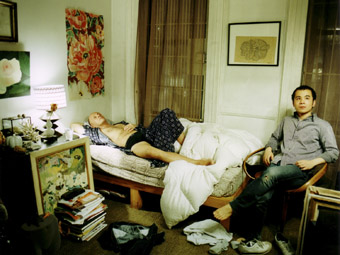
Strangers, 2006, Futoshi Miyagi; Intimate Acts
photo courtesy the artist
Strangers, 2006, Futoshi Miyagi; Intimate Acts
It is the sign of a successful exhibition when, like a good CD or LP, works try out different things but also cohere to some abiding style or concern. Curator Melissa Keys succeeds in playing out variations on her theme, such as doubling and kissing, keeping the viewer interested in the whole. Featured contemporary artists from around the English speaking world include the US (Chang, Miyagi), UK (Smith/Stewart), Australia (Traitsis, and from Perth, Elise/Jurgen). These are all young artists, infused with a generational optimism that was sadly missing in the Australian Centre for Contemporary Art’s 2008 show of the same name. While the works at ACCA spoke of impossibility and loneliness, the vibrancy of the PICA pieces turn impossible acts, such as kissing your parents, breathing another’s air, or doubling yourself, into performances that speak of care and love.
Intimate Acts, curator Melissa Keys, Perth Institute of Contemporary Art, June 18-Aug 2
RealTime issue #92 Aug-Sept 2009 pg. 54
© Darren Jorgensen; for permission to reproduce apply to realtime@realtimearts.net
version 1.0: this kind of ruckus
At an Induce workshop at the On Edge Festival in Cairns in July, David Williams of the performance group version 1.0 was adamant that the company does not make verbatim theatre. Rather, he says, it immerses itself in the epic official documents and media material pertaining to political crises (‘children overboard’, ‘wheat for weapons’) which it then distils, quotes from and transforms into surprising, often quite lateral, sometimes satirical images that encourage us to look twice at the contradictions and corruption too easily veiled by spin and the welter of the everyday.
After the extensive regional tour of their ‘wheat for weapons’ show, Deeply offensive and utterly untrue, the company has plunged into the creation of a new work “about gender, power, control and violence”, titled This kind of ruckus. The show investigates “the underside of domestic bliss…with commentary on the recent high profile sexual assault scandals involving Rugby League players.” The show will “reflect on violence within ourselves and our own relationships.” Williams says it’s not about Rugby League: players, officials, politicians, will not be named—a first for a version 1.0 show. The aim is “to open up a fissure in the culture with the possibility for public discussion, and then ask ‘How should we behave?’ The world permeates version 1.0 performances”, Williams adds.
The recent string of sports-related sexual assaults, inconsistent policing of domestic violence and “the horrible logic of public opinion” that believes a woman entering a pub for a drink has herself to blame if she’s raped, suggest for version 1.0 the many grey areas that remain in gender relations in public but also in private life. The company have researched couple therapy and looked at their own behaviour through improvisation, including for Williams, assessing his own relationship with female performers, how he moves, gestures and “when it’s not about me.” The collaborating artists are Danielle Antaki, Sean Bacon, Kim Vercoe, Paul Dwyer, Jane Phegan, Deborah Pollard, Gail Priest, Arky Michael, Christopher Ryan, Yana Taylor, David Williams, Neil Simpson. version 1.0, This kind of ruckus, Sept 4-12, Performance Space at CarriageWorks, Sydney, www.versiononepointzero.com; www.performancespace.com.au
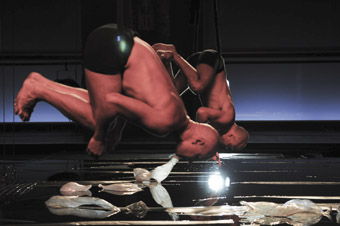
Dean Walsh, David Clarkson, MirrorMirror, Stalker, Parramatta Riverside Theatres
photo Heidrun Löhr
Dean Walsh, David Clarkson, MirrorMirror, Stalker, Parramatta Riverside Theatres
stalker: mirrormirror
Physical theatre company Stalker’s MIRRORMIRROR brings together artistic director David Clarkson and dancer-choreographer Dean Walsh with “their ghostly puppet counterparts” enacting life “from beginning to end—from the ground to the air—evok(ing) images of the spirits of our ancestors…” The pair share Irish Celtic and working class backgrounds. This exploration of “personal endings” is the third work in a Clarkson triptych: the first was Four Riders, drawing on the Book of Revelations; the second was Red, about scientific visions of the end of the world. Collaborators include set designer Joey Ruigrok, lighting designer Sydney Bouhaniche, puppet fabricator/sculptor Kassandra Boswell, composer Peter Kennard; Riverside Theatres, Parramatta, Oct 2-10; riversideparramatta.com.au.
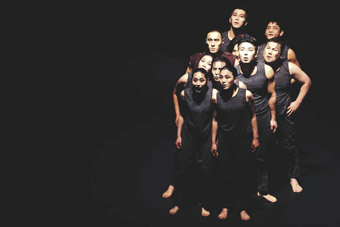
Woyzeck, Sadari Movement Laboratory, OzAsia Festival
photo Eun Sun
Woyzeck, Sadari Movement Laboratory, OzAsia Festival
2009 ozasia festival
The first announced events of the 2009 OzAsia Festival program are complementary, cross-cultural collaborations of a high order. Akram Khan will present bahok, originally a collaboration with the National Ballet of China, now performed by eight dancers—Chinese, Slovakian, Korean, Indian, South African and Spanish—with music by Nitin Sawhney. Into the Fire is a musical concert with dance: Paul Grabowsky and the Australian Art Orchestra will collaborate with South Indian Mridangam player Guru Kaaraikkudi Mani, members of the Sruthi Laya percussion ensemble and Bharatanatyam dancer Rajeskwari Sainat. Earlier versions of Into the Fire in concert and on CD have displayed a rivetting synthesis of traditional Indian music and adventurous western jazz with each maintaining their integrity. Khan’s bahok “aims to create a modern day utopian community. The performers meet in one of this globalised world’s transit zones and try to communicate, to share ‘the things they dream with’—their experiences, their memories of their original homes, the dreams and aspirations that made them move. They are carriers. They are bahok.”
Providing a welcome contemporary performance perspective are Melbourne-based dancer Yumi Umiumare in her new solo work, En Trance, and, from Korea, the only Australian season of the Sadari Movement Laboratory’s physical theatre interpretation of Buchner’s Woyzeck, performed with a set of dextrously deployed chairs—swung, danced, piled high—to the music of Astor Piazolla. OzAsia continues to be a rarity in Australia—a celebration of our relationship with our nearest neighbours and a sad reminder of the paucity of Asian programming in our major arts festivals. OzAsia Festival, Adelaide Festival Centre, Oct 3-17, www.adelaidefestivalcentre.com.au/ozasia
seam 2009: spatial phrases
The inaugural SEAM conference and workshops bring together architecture, film and dance to explore “ideas of movement across bodies and space.” Hosted by Critical Path and the University of Technology Sydney’s Centre for Contemporary Design Practice, the program includes a three-day Symposium with international speakers including architectural and cultural theorists Erin Manning, Brian Massumi, Andrew Benjamin and Pia Ednie-Brown. Commissioned installation projects and performances from local artists will be showcased and interdisciplinary workshops held at Critical Path. International artist talks will include choreographer UK-based Carol Brown, Marten Spangberg from Germany, UTS Design Head of School, Professor Lawrence Wallen and Dr Benedict Anderson, Course Director of Spatial Design at the University of Hertfordshire.
Works include Brisbane-based Jondi Keane and James Cunningham’s performance installation Tuning Fork (RT89, p32) and Sue Healey’s installation The Door, The Chair, The Bed and the Stair with architect Mark Healey, digital artist Adam Synnott and performer Nalina Wait. With four large screens, “the images [will] play with our perception of space, amplifying an emotional and physical response to specific architectural framing.” A video animation, Falling, by Nikki Heywood and Heidrun Lohr [see p20], comprises some 3.400 photographs and is based on the?experience of Heywood’s mother, who had several falls in her apartment. The artists write that “this gives us the possibility to explore, from a different and curious angle, the passing of time and the dynamics of a body literally collapsing inside and against an architectural space.” Richard James Allen and Karen Pearlman’s presentation, “Entanglement Theory”, will hypothesize “that a mash-up of Vedic spiritual philosophical ideas of multiple states of consciousness, multiple forms of body and multi-dimensional realities and the elemental beings that inhabit them, along with science fiction-like theories of quantum particle entanglement” can be explored through a mix of RealLife and Second Life. Critical Path director Margie Medlin’s Miss World installation (2002) also mixes the real and the virtual to “create new choreographies” using “the dancer’s movements to draw attention to the body in the changing face of cities and the culture of urban planning.” SEAM09: spatial phrases; Sydney, various venues, Sept 7-20, www.criticalpath.org.au/SEAM.html
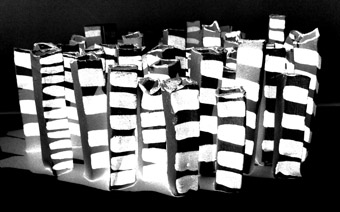
Triptych Primordial Landscape, painting by Jenny Mullet, Tandeera
courtesy the artist
Triptych Primordial Landscape, painting by Jenny Mullet, Tandeera
tandeera: indigenous projects
Three Gunnai/Kurnai artists from eastern Victoria have been working with leading Australian projection artist Ian de Gruchy to create the first indoor Koorie art projection exhibition, Tandeera (“place of rest”), in Melbourne. In a press release, de Gruchy explains that the installation “required the use of pre-digital technologies using orthographic film and programmed slide projectors to translate the artists’ work onto the black painted walls of the gallery.” The works meditate on “the themes of resting and healing post-apology…to soothe the soul.” Koorie Heritage Trust, 295 King St Melbourne to Aug 21.
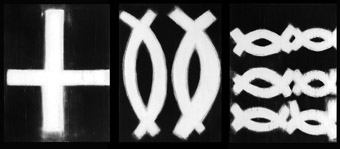
Landscape of Birds by Jenny Mullet from ceramic installation, Tandeera
courtesy the artist
Landscape of Birds by Jenny Mullet from ceramic installation, Tandeera
billy twinkle—requiem for a golden boy
Virtuosic Canadian puppeteer Ronnie Burkett returns to Australia, playing Melbourne’s Arts Centre (Aug 25-29), Geelong Performing Arts Centre (Sept 3-20) and Sydney Opera House (Oct 1-17). Meg Walker saw Burkett’s new show in Vancouver and wrote, “Compared with (his) last two works the tender and restrained Ten Days on Earth and the brutal, brooding Provenance the puppeteer and writer’s latest work is full of bustle and glitz. The plot demands it: Billy is a cruise ship entertainer who has just been fired for insulting passengers during his cabaret act puppet shows. Vain, middle-aged and full of self-loathing, the man in the dinner jacket needs a reason to carry on” (RT90, p5).
look out for…
For films with a difference, try the Melbourne Underground Film Festival (MUFF), August 22-30 or the Sydney Underground Film Festival, Sept 10-13. Sydney performance trio, post, will mount their wickedly funny and bizarrely intelligent new show, Shamelessly Glitzy Work, at Melbourne’s Arts House, August 13-15. Also at the Meat Market is live art duo Panther’s Playground, a New World Order where the audience get to be kids again if in some dark scenarios. Aptly for our self-conscious times, Adelaide’s Brink Theatre premieres The Hypochondriac (adapted from Moliere’s Le Malade imaginaire) August 5-22 at the Space Theatre. Under the banner Come Hither Noise, Fremantle Arts Centre is exhibiting works by artists from around Australia: Mark Brown, John Conomos, Richard Crow, Ross Manning,Thomas Meadowcraft, Elvis Richardson, Sam Smith and Sriwhana Spong; August 1-September 20.
RealTime issue #92 Aug-Sept 2009 pg. 55
© RealTime ; for permission to reproduce apply to realtime@realtimearts.net
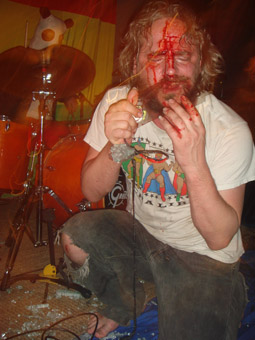
Lucas Abela, Yang Yang (in panda suit)
courtesy the artists
Lucas Abela, Yang Yang (in panda suit)
Lucas Abela, famed for his aural onslaughts on a miked and effected pane of glass, toured China at the end of 2008 teaming up with local musicians Yang Yang and Li Zenghui to form Rice屎Corpse. He also produced Mrs Rice a CD documenting this intriguing collaboration (see earbash review). Following is an edited interview with Abela about his experiences in China, how he developed his unique show, and life on the noise touring circuit.
Why China?
China. I guess was advantageous. I knew about Asialink, I didn’t think I’d get [a grant], but I figured I’d have a go. It was a toss-up between China and Japan.
I thought Japan would be good for you.
I’ve been to Japan 12 times as opposed to China three times, and have lots of good connections in Japan. Japan is not as expensive as it was…but when you’ve got 12 grand to spend and you want to get a lot out of that money China is a better go. And I was more interested in China as a place. Japan is sort of weird, but China is weirder—politically, socio-economically, ethnically. All sorts of strange things are going on there. So I picked China, and got Yan Jun from SubJam to host me.
The thing that I like about self-initiated residencies is that it shows I have initiative and drive, but also if I initiate one I’m the only person in competition…So I thought what’s a good reason to be in China? I have to work with the locals in some way, so I devised the idea of a band. It’s a band I’ve wanted to do for a while, but I’ve never got around to doing it. I’m trying to re-form it at the moment and we haven’t even got to rehearsals yet because when I’m here I’m just so cluttered and all over the place. But when I was in China I was doing nothing but the band.
And that’s the real beauty of residencies, you have to get away even to do something you could do in your own lounge room, so that no one bothers you.
It was easier to go Beijing, find these complete strangers and start a band. There was a beauty to that I thought, finding these complete and utter strangers. They were even strangers to each other. They knew each other from the scene but Li Zenghui is a saxophonist in the kind of Chinese NOW now world, while Yang Yang, the drummer, was more of a punk-ish drummer in the Boredoms tradition. The scenes cross like they do here, but they weren’t solid friends hanging out every day.
Jun [from Sub Jam] recommended Yang Yang to start with, but he said, “There’s no pianists. I can’t think of a single pianist in town that can do this job. Why do you want a pianist?” I had this thing in my head—pianist and drummer. When I first got there I went to this gig [at DosKolegas] which is a series of events Jun runs in Beijing. Li was playing saxophone there. I got to talking to another Yang, who runs Sugar Jar, the record store in the arts district, and he asked me if I was interested in doing an in-store gig. I found that there was piano in this shop. I said. “It would be great if someone played piano with me. Do you know any pianists?” And he told me that Li, before he took up the saxophone, used to play keyboards in bands as a teenager. And so I said I’ll take him.
Did you have a try with him playing the saxophone?
No, I hate the saxophone!
The timbre of your instrument and saxophone are kind of similar.
A sax would compete with me somewhat, and I also wanted rhythmic instruments. I wanted a piano played rhythmically which is how I instructed them. We sat down and they looked at me and I said you [stabbing gestures], you [drumming flailing gestures]. That’s how our communication was, besides a little calculator thing where I’d write in words like “staccato” or something like that and try to get some ideas across as to how I wanted the rhythms to flow. And then off they went.
I wanted to play glass lead and let them structure rhythm into my music that’s never been there before. Always when I play, I have this imaginary rhythm section in my head. I think I aurally hallucinate because I’m hearing all sorts of things. In this instance I got this band, and they’re outwardly influencing me as well and I’m hearing them and I’m following a rhythm or following a change of theirs. It added new elements to my playing. And I think it really shows on the album because it’s completely different to anything I’ve done before.
It’s amazingly cohesive. So in terms of making that material, are the pieces set now?
No, all the tracks are completely improvised. I had a three-month residency. I spent the first month touring towards China, then I had one month in Beijing and one month touring with the band. The first couple of weeks I was trying to get the band together and when we finally got together we only really did four rehearsals and, out of those, two were recorded and edited down to the album. Each rehearsal was about 70 minutes. The album became about 50 minutes. There are a couple of other tracks that I wanted to put on the album. I mixed and finished them but Yan Jun from SubJam, the co-label for the project, said “The album’s too long, you should make it tighter, it’ll have more impact.” I don’t usually think that way, but he was completely right and taking those tracks out made a much more cohesive record. Then we did a 10-city tour.
And the tour was all improvised?
The tour was all improvised.
Do you think that maybe the language barrier sutured the music more? Because the other avenues of communication were cut off, the playing was more intense?
I think we communicated better playing together than any conversation we had. Their English was very small, my Mandarin is dismal, so most conversation was “food, eat.” I’d just follow them around and we’d go to bizarre restaurants, and they’d just chat amongst themselves. I was more the isolated one.
So there’s a regular touring circuit in China?
The circuit is growing. There are lots of live houses but less for the kind of stuff we’re doing. There are so many cities there that you probably wouldn’t even look at on a map and are bigger than Sydney. If you splintered off even 1% of the population, there’s still a decent touring circuit for the bands in China. Especially for the punk bands.
So is Beijing the new Berlin, because of the underground scene.
There’s talk about that. There’s a whole scene wrapped around a place called D22, in the arts district in Beijing, which has been opened up by New Yorkers, in the university district. This is the venue famed for unlocking bands like Car Sick Cars and P.K.1.4. Sean Tenzenmen is licensing their work in Australia, and they’re doing good business. I guess they’d be considered the new Chinese underground. It was getting more focussed leading up to the Olympics with people looking for side stories and picking up on the underground Chinese rock scenes.
They were talking about it as the new Berlin or a hub, but I wouldn’t describe it that way. I think they do it a lot harder in Beijing than in Europe. There are Europeans who are famously well paid and make a living out of their music. [As for] my band members, Yang Yang has left the country once and gone to Nepal. Li has never left the country. Li got evicted during our tour and had nowhere to go at the end of the tour. They’ve got no money and music is definitely not their prospect. It could become a Berlin type scenario for foreigners. Foreigners could easily move in and live off nothing, but they probably won’t make money as musicians. Though there’s still probably more happening on a nightly basis than in Sydney, which is saying something.
So how did it open up your practice?
Doing the band really opened my ears to a different way of playing that I wasn’t getting in my solo shows. I definitely want to move forward with the idea of playing with bands, so I want to recreate that here. I found out about this thing called SoundClash which is an Australia Council initiative to put experimental musicians and popular musicians together. So I’ve got Stu Olsen [Rand & Holland, Garbage & The Flowers] and Peter Kostic [Regurgitator] on board. Peter is a fantastic drummer. I did a short tour with Regurgitator in 2005. I was doing the glass solo shows at the time. They were doing the Band in the Bubble where they were recording an album in Federation Square. And I was their weird segue.
So how long have you been playing the glass?
Since 2003. But in essence it’s an extension of what I was doing before—playing metal objects in my mouth. This stemmed from when I toured Japan in 1997. I had two motorised turntables and I couldn’t take the motors with me, so I bought motors over there. But because they were a lot weaker they stopped working. To make sound, and out of nervousness, I started putting things in my mouth. I’ve been working these mouth techniques ever since. I see it as a new instrument. I press it against my lips and hum and vibrate the sheet. I can’t think of another musical instrument that works in that way. It’s not wind, I’m not blowing through it; it’s not percussion, I’m not hitting it; it’s not strummed. I’m like vvvvhhhhh—just vibrating the sheet. I think it’s got lots of potential as a musical instrument in its own right. One of the reasons I wanted to move into a band context was to show off its musicality, which no one really sees when I play it because I’ve got very discordant tastes.
I’ve got this problem of no one taking me seriously because I smash the glass on my head and I bleed and I add showmanship. I think if you’re going to do a show you should do a show. You should make it fun, make it interesting. I’m interested in the element of danger. It brings to the audience this anxiety that no other musician I know of can induce. To harness that kind of emotional ride for the audience is very interesting to me. My entire history of music has [incorporated danger into] my instruments. Spinning motors that cut through my wrists to bouncing on trampolines, to having amplified sword fights. I think it’s appealing to my audience as well. The way they react to my shows—I’ve had a people in hysterics, crying. I’ve had six-foot men faint in Scotland. It’s a big note, but I’ve had so many people tell me it’s the best thing they’ve seen in their lives.
You always play quite short sets.
Yeah, I don’t like to bore. I don’t ever want the audience to think like I do when I see a show, “Ah yeah, I get it.” I want to finish before that starts.
So playing with a group spreads out the intensity of the ride for the audience?
It gave me room to breath.
Literally.
Yeah, literally. All of a sudden I didn’t have to fill up the whole aural spectrum myself, I could sit back and interject with the instrument… there would be ebbs and tides in what I was bringing in and taking out instead of trying to just fill up the whole room with noise and running out of breath.
Did you smash the glass when you played with the band in China?
I wasn’t going to, but I did. Force of habit. Part of me wanted to say this is a band, this is me doing something different musically and I don’t have to smash sheets of glass over my head to get a round of applause. But I still want to smash it. There’s something I really enjoy about it. It’s the rush at the end of the show. It’s not just for the shock of it; it just seems the right way to finish a show. It’s the heightened point when I’m feeling good and I get a rush and bang… and there’s the trickle of blood across the face [he giggles] I love that.
It’s interesting how this crosses you over into the live art arena.
I did a performance art festival in Korea. I was going through Korea anyway and I was already booked at a noise fest and someone said that there was a performance art festival that was interested. It was at the same venue. So they booked me for two shows over two weekends, and I spent a week in Korea. I did the noise festival then the performance art festival
And how were they different?
I guess the audience was smaller for the performance art festival which I was surprised by. I don’t know how developed that scene is in South Korea. I think there’s a lot of performance art throughout Asia. I’m getting booked in Jogjakarta at a performance club run by [Australian artist Timothy O’Donoghue]. He’s running a performance art venue there, so there’ll be that context.
Most of my engagements are within the noise music ghetto, as I like to call it. I think of what I do as noise music, but I like to think of it as more than just a guy with a bunch of pedals on tables doing noise music. My basic circuit is that and above that I get festivals which are crossed with all sorts of acts. I’m getting known outside of the noise music world now. Once you get into that loop it’s really great. The good thing about Europe is that cultural centres are funded to the teeth, and within them are people programming music. There was a festival in Valencia, Spain. There were two different stages. John Cale was on one stage and I was on another in another part of the city. John Cale’s stage is obviously packed, I’m playing in a cockfighting ring with six people in the audience, but I get paid 600 Euro, and those people didn’t pay 100 Euro each to get in.
Do you think that once you become better known genre becomes less important? When you think about major music festivals they are about people playing different genres, but the artists are all of a particular standing.
Well I’ve gone on before Patrick Wolf—a teenage pop star—at the Donau festival [in Germany]. That festival really mixes things up. It had the Boredoms, Throbbing Gristle. The night I played was The Vivian Girls, Deerhoof, Patrick Wolf and myself. To be on a line-up like that, with a bunch of teenage girls and an independent pretty boy, was quite strange. There are a lot of things like that.
And how does the audience respond to that kind of diversity—a European audience?
I think they love diversity. It’s quite easy to bring people into my show even if they are not au fait perhaps with noise music. The performance element can hook them in and more often than not I can make any crowd clap. Whether it’s polite applause or not is hard to tell but it usually seems enthusiastic to me. It depends on the crowd. Some people would just clap anything!
Rice屎Corpse, tour November 2008; Mrs Rice CD, Dual Plover/Kwanyin-Subjam 029, 2009
See also That was shit! on the making of Mrs Rice including responses from Yang Yang and Li Zenghui
RealTime issue #92 Aug-Sept 2009 pg. web
© Gail Priest; for permission to reproduce apply to realtime@realtimearts.net
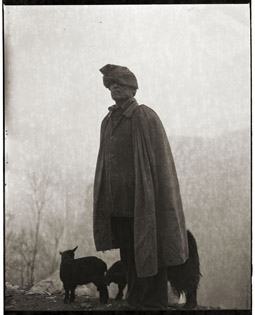
Man with Sheep, 2006, Adou
photo courtesy the artist
Man with Sheep, 2006, Adou
RONG RONG HAS BEEN A KEY FIGURE IN THE DEVELOPMENT OF CONTEMPORARY CHINESE PHOTOGRAPHY SINCE HIS PIONEERING WORK IN BEIJING’S ‘EAST VILLAGE’ IN THE EARLY 1990S.
Since meeting his Japanese wife Inri at the turn of the decade, the pair have collaborated on a string of intensely autobiographical photographic series documenting their lives together and the changing nature of their surrounds. In June 2007 they opened the Three Shadows Photography Art Centre in Caochangdi, on the north-eastern outskirts of Beijing. As well as holding a darkroom, digital studio and library, the centre has hosted artists’ residencies and staged a series of innovative group and solo exhibitions highlighting current trends and talent in China’s emerging photographic art scene.
Dan Edwards spoke to Rong Rong about the centre and the inaugural Three Shadows Photography Award. Dan’s article about Three Shadows can be accessed here.
When did you and Inri first conceive of the Three Shadows Photography Art Centre?
In 2005. Initially it was just a dream for Inri and me. In 2001 I visited many artistic communities across Europe and saw a lot of spaces dedicated to photography. As a photographer I felt they were so lucky to have such places, where you could see work, exchange ideas and find a lot of research material. China is such a big country, but it didn’t have these things—in this respect China was a blank. I didn’t go to a real college to study photography, but experienced a long self-taught process. China doesn’t have a photographic museum or archive, so at least we wanted to establish a library for everyone to use as a basis of communication. Slowly the idea of the centre became bigger and bigger.
Why did you choose this site rather than 798 [Beijing’s most famous art zone, in Dashanzi]?
In 2005 I started looking for a place and in 2006 we started to plan. We went to 798 but finally we chose this site because it is very quiet. Also my company is located near here. Originally this site held a very old building. At first we wanted to renovate the old structure but later we decided to demolish it, and talk to a designer about building a library, café and so on.
Although Three Shadows is an exhibition space, we also have other functions. For example we hold forums and artist residencies. If the artists lived at 798 it might be too noisy. These factors indicated we needed a quiet neighbourhood. So I had a very clear aim, and looked for a site based on that. 798 is currently undergoing very rapid development, and I can see the speed and direction it’s headed in—it’s like a big supermarket. They want to have everything there. So I didn’t think the environment suited our independent gallery.
What were your aims in creating the centre?
The most important question for me was, where is China’s photographic history? On the surface in recent years China seems to have an abundance of photographic history, but in fact it doesn’t have its own foundation or system—there are no photographic museums, archives or collections. The country lacks these things so we wanted to start and slowly build them up, because Inri and I met through photography. In 1999 I had an exhibition in Tokyo, and she came to see it. We wanted to set up a platform to introduce photography to a broader audience and show the beauty and joy of the form. We now have a small permanent collection that is slowly growing.
Do you act as an agent for other artists as well?
Yes, we have some of the functions of a commercial gallery, but we also have many functions a commercial gallery doesn’t have, such as providing residencies, hosting forums, publishing and providing library and darkrooms facilities. We don’t have any financial support from the government—we depend on ourselves. Every penny for running the centre comes from selling our work. Inri and I put all our money back into the centre. We hope the money can eventually go into a public foundation so Three Shadows can become a fully independent institution.
Can anyone apply for Three Shadows residencies, or are they for Chinese photographers?
They are mainly for international artists, as it’s easier for most local artists to come here—although if you are from somewhere far away like Sichuan or Tibet you can also get a residency. We mainly want to provide a bridge for communication between Chinese and international artists. We have already had six or seven foreign artists come through here: American, Spanish, Finnish. When they come here they can produce work and use the library and darkroom. But the most important thing is to communicate with local artists.
When did you and Inri come up with the idea of the annual Three Shadows Photography Award? Was it part of the original idea of the Centre?
Yes, because finding emerging artists with potential is very important. My own experience tells me that in a certain period of your career being encouraged or complimented by others, and having the chance to communicate with other artists, is very important. Of course China has other kinds of photographic awards—official government or commercial awards given by companies. But I think the Three Shadows award is completely different. We have our own conception of the development and language of contemporary Chinese photography.
The press release says you received nearly 300 submissions. Were you surprised by the size of the response?
Not very surprised, because China has such a large population. At the same time, this was the first time we had run the award, so 300 entrants was pretty good. It was hard to narrow the entrants down, but the finalists we selected already know their direction. My original idea was to select eight to ten finalists, but when we saw how many good works there were, we eventually settled on 31. Then we had the exhibition and the international judges arrived to give the award on the basis of the finalists.
Was there a lot of new talent you hadn’t seen before?
I hadn’t seen much of the work before—most of the artists were very new and very young.
The award is open to any Chinese citizen or anyone of Chinese descent, so were there many submissions from outside the mainland?
This year there were not many non-mainland people. Among the finalists there were four—one each from Hong Kong, Taiwan, New York and Germany.
Based on the award submissions and your work here at the centre, do you see any particular trends in Chinese photography at the moment?
Digital techniques are being very widely used. Hand processing is becoming very rare and is slowly disappearing, which I think is a pity. Of course I don’t reject the new techniques, but I think hand processing is very important. Many young people have already abandoned these techniques.
What about at the level of subject matter?
One thing I noticed is that everyone wanted to express their private selves. Unlike older photographic trends that were focussed on society or big topics, younger artists are focussed on their inner world.
When did you first encounter the work of the winning photographer Adou?
In 2008 we started thinking about an award for young artists. The Three Shadows curator Zhang Li went to various places to scout for new talent. He went to many places like Guangzhou and Lianzhou and collected a lot of material. Adou wasn’t part of any formal art festival or exhibition—he had just printed his work and was selling it on the roadside. Our staff saw it and brought it back. He was a designer for ten years, then he quit and became a photographer. When I saw his pictures I found them very attractive—I feel Adou’s photography has the weight of time and history in it. So we found him and said we wanted to hold an exhibition of his work. Originally he just printed his work using a computer, but when I talked to him he agreed to use traditional hand processing techniques to reproduce his pictures. It really suits his work.
So was the Outward Expressions exhibition [at Three Shadows in March-April 2008] the first time Adou had exhibited in a gallery?
The first time. Also the first time he had hand processed his photographs.
In terms of Chinese contemporary art, the focus of the international market in recent years has very much been on painting. Do you think this a reflection of what has been happening at the level of practice in China?
Yes, this is a big problem. Chinese photography is 30 or 40 years, or even more, behind Chinese painting. Photography became an independent artform very late in China. Maybe this has something to do with the Chinese system, because photography has always served the government—photographic themes have always been focussed on the government. In recent years it’s become a bit better, but previous work had no artistic value.
Do you think this is changing? Is Chinese photography developing its own traditions?
On the surface it seems so, but in fact I think it’s not enough, because China doesn’t have good photographic institutions, critics or publications that give people the chance to see original works. There is also a lack of communication—the world’s top photographers don’t have much opportunity to come to China.
Is photography taught in Chinese art schools as an artform?
There are a few courses but not many. I think it’s really important to have an independent college of photography, but China doesn’t have one at present. All the courses are taught by departments within broader art colleges. For example, the Chinese Academy of Fine Arts [in Beijing] has a course in photographic history and the students sometimes have classes in the Three Shadows library. Also Qinghua University [one of China’s top universities situated in Beijing] has had classes here. Something really funny—when the students visited the darkroom, they had never seen an enlarger before. Even more amazing, they had never seen 35mm film before. Most of the students were young girls in their 20s, and they used their digital cameras to take pictures of the 35mm film. I thought it was really funny.
Did you feel the award entrants were very aware of the history and traditions of photography in and outside China? For example were they aware of your work in the East Village back in the early-1990s?
I think they know something, but it comes from the web. They lack contact with original works and other artists, which I think is very important. Looking at prints and original work is very different. Also a working environment where they can communicate with foreign artists is really lacking. Of course they can find a lot of information online, but they lack real experience. Three Shadows can provide this. Society is based more and more on the virtual, but I feel real experience is still very important.
Thanks to Wang Yi for her help translating the interview.
RealTime issue #92 Aug-Sept 2009 pg. web
© Dan Edwards; for permission to reproduce apply to realtime@realtimearts.net
The Federal Government’s Excellence in Research for Australia scheme, which will, for purposes of promotion and funding, credit artist-academics for their creations, and the ArtStart initiative, which will fund recent creative arts graduates towards realising their careers, are both still formative but will be quickly implemented. They have been welcomed with a mix of relief, optimism, scepticism and anxiety by academics and artists. As the writers for our 2009 arts education feature quickly discovered, it is going to be difficult to have ERA evenly applied, or for peer review criteria and methodologies and journal rankings to be uniformly agreed to. Then, for the performing arts there’s a need for ERA to recognise the importance of collaboration and interdisciplinary practices—some of our interviewees propose a science or social science team-based research model rather than a humanities-based one. Flinders University has been working on developing a collaborative postgraduate feature filmmaking model. Anxiety over ArtStart is focused on a national arts infrastructure inadequate to meet the long-term employment needs of ArtStart grant recipients, once over 30 years of age, and the thousands graduating annually in creative arts, let alone older artists working hard at survival. Meanwhile the issue of artists on welfare and their standing with the Australian Taxation Office will remain unaddressed, supplanted by yet another grant scheme. The creative arts seem set, at long last, to be formally recognised in the tertiary education sector, but is there an ‘arts industry’ and the arts infrastructure sufficient to support those it nurtures? On the other hand some of our respondents fear that ArtStart will too easily adopt identifiable goals around ‘business’ and ‘vocation’, neglecting, as one academic puts it, the requisite ‘meaninglessness’ of art. ERA and ArtStart represent very welcome, major changes in Federal Government attitudes to the arts but, as ever, the significance will reside in their implementation.
RealTime issue #92 Aug-Sept 2009 pg. 1
© Keith Gallasch; for permission to reproduce apply to realtime@realtimearts.net
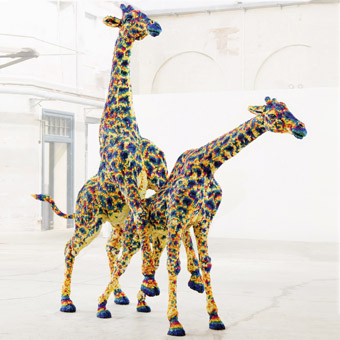
Belle Brooks, University of Sydney, Typing “Giraffe Sex” into Google Yields Ungodly Results 2008
Hatched 2009 National Graduate Show
Belle Brooks, University of Sydney, Typing “Giraffe Sex” into Google Yields Ungodly Results 2008
FOR MANY YEARS THE AUSTRALIA COUNCIL’S GRANT GUIDELINES INCLUDED A LONG LIST OF THINGS THAT THEY WOULD NOT FUND. THEY STILL DO, BUT NOW THE LIST IS A LITTLE SHORTER. WHILE FUNDING IS STILL NOT GENERALLY AVAILABLE FOR THE ACADEMIC ACTIVITIES OF UNDERGRADUATE AND POST-GRADUATE STUDENTS, ONE OF THE THINGS THAT HAS DROPPED OFF THE LIST IS THE EXPLICIT EXCLUSION OF ‘ACADEMIC RESEARCH.’ THIS IS, PERHAPS, A RECOGNITION THAT A GOOD DEAL OF ART PRACTICE THESE DAYS FUNCTIONS WITHIN A RESEARCH PARADIGM, WITH QUITE A LOT OF IT GOING ON IN AND AROUND ART SCHOOLS THAT ARE NOW EMBEDDED WITHIN THE UNIVERSITY SECTOR.
It’s part of a shift that has been going on for a couple of decades, along with the gradual expansion of research based higher degrees in the visual arts. Accompanying this has been the long on-going debate around the treatment of art practice as a form of academic research, which has entered a new stage with the initial trials of the new Excellence in Research for Australia (ERA) framework.
But something else has also happened over the last decade, perhaps producing a quite different practice paradigm. Since the introduction of the GST and related tax reforms, artists have been increasingly obliged to function explicitly as small businesses. In this context, art has to pay its way: it’s a business activity as much as a purely creative, critical or research activity. And while bodies like the Australia Council used to expect artists to have a few years practice under their belts before they applied for funding, support is now increasingly being directed at the emerging artist immediately following the completion of an undergraduate degree.
artstart
The recently announced ArtStart program falls broadly within this model, adding a further $9.6 million over four years to the more than $6 million allocated last year for emerging artist programs. As the Arts Minister’s press release of May 12 2009 put it, ArtStart “offers one-off grants to help graduates start a business as professional artists.” At the time of writing the detail of the grant conditions remains unresolved, but the program—to be administered by the Australia Council—will be offering grants of up to $10,000 to emerging artists under 30. While the ArtStart policy had originally been linked to the issue of artists on welfare, the announcement of the program focussed attention on the fact that “many emerging artists are forced to rely on their own resources and part-time jobs to subsidise their careers.”
ArtStart has generally been welcomed within the visual arts community, but there are concerns about its capacity to deliver. As the Chair of ACUADS and Head of the University of Tasmania’s School of Art, Professor Noel Frankham, puts it, “I doubt very much that $10,000, useful as it would be, is going to achieve the goals articulated for the program—assuming tax exemption, I estimate that it would buy rental of studio space for a year, but an artist still has to pay home rental, buy food, and art materials.” In this respect, it is worth noting that the cross-subsidisation of artists’ practices is not restricted to emerging artists, with the 2003 report on artists’ working lives, “Don’t Give Up Your Day Job”, indicating that over 60% of professional practicing artists work additional jobs, many of them in teaching.
a career: when?
In the light of this, Associate Professor Donal Fitzpatrick Head of Art & Design at Curtin University in Western Australia notes that while “any financial support would be welcome, it has to be thought through in relation to needs.” How, for example, does ArtStart compare to venture capital models that operate in other areas of the creative industries? And what about the increasing numbers of artists with higher degrees, how do they fit the policy framework? As Fitzpatrick sees it, with the increasing focus on practice based research degrees “there needs to be more consideration of the development of career paths in the pivotal couple of years after art college.”
This is an issue that also concerns Noel Frankham. “A program that focuses on graduating students under 30 is likely to miss many of the most serious, talented and worthy new graduates”, he says. “Increasingly, those with a serious commitment to establishing a viable professional art practice are undertaking research masters and doctoral programs (often both), meaning that they are highly likely to be over 30 when they embark on exhibition careers.” This introduces a further, and perhaps less palatable problem, which relates to the issue of career outcomes for undergraduates. As Frankham notes, “whilst investment in bachelor degree graduates is likely to be useful, it is less likely to be an investment in long term practice as artists, as most bachelor degree graduates from art schools do not apply their qualifications and skills to earning their income from creative arts practice; they use their degrees well, but not as artists.”
era: creativity as research
With regard to ArtStart and the Excellence in Research for Australia (ERA) project, Noel Frankham cautions against “making too direct links between programs for measuring the quality of academic research in the creative arts (ERA), and those aimed at supporting professional practice (ArtStart).” They are, he says, “complementary but un-related.” However, a tension remains, not least because of the lack of distinction between academic and professional arts activities, with ERA now counting artists’ exhibitions, curated projects and exhibition catalogues as valid research outcomes within the university system.
This is a very significant development for those artists who work in academic institutions, as well as for the schools and departments in which they are employed. As Donal Fitzpatrick puts it, the creative arts were previously “viewed as an afterthought, something that you add on to the broader sweep of academic work and research which was done elsewhere in the university.” But the new framework of ERA changes this, treating creative work as part of the research output of art schools, having an impact on funding, and “our status within the university”, says Fitzpatrick. “From my perspective there is much to be gained from normalising creative outputs as research within universities and the culture more broadly”, he says.
One strand of this new development is the increasing significance of the ‘practice based’ research higher degree, the impact it might have on how art practice is understood and the role it might play in artists’ career development. Another is the significant shift in how the new research framework treats issues such as peer review and ‘publication.’
peer review before or after the event?
How will the existing visual arts infrastructure play a role—from art magazines to art galleries, not to mention existing funding agencies (like the Australia Council)? As Su Baker of the Victorian College of the Arts notes, “we see peer review at many levels within the artworld, but this hasn’t been well understood at ARC (Australian Research Council) level.” At the same time, “there have been mixed messages regarding the issue of counting Australia Council grants as research outputs.” Similar issues may also emerge around how exhibitions in different gallery contexts are treated, or more particularly how decisions are made regarding the selection of work for exhibition. As Donal Fitzpatrick notes, one key issue is ERA’s shift in focus “from peer esteem to quality assurance.” “In the case of the visual arts this means that what comes prior to the ‘event’ (exhibition for example) becomes of paramount importance and what comes after is much less so…This is a massive shift for creatives to get their heads around”, he says. “All of their career paths till now have been driven by a review culture of endorsement that comes after the event, not the (peer review or selection) processes before the event.”
What this difference highlights is the structural change that a research based visual art practice may generate, with academic artistic advancement being based on peer decision making within the academy, irrespective of the response of critics, curators, or the market. While the implementation of ERA is seen primarily as an issue for artists working in academic institutions, it does have potential implications for the sector as a whole. While it is important for artists working as academics to have their work properly valued within the university context, we also need to carefully examine how this might impact on other aspects of the artworld. As we already know, there is no neat and easily identifiable relationship between critical and commercial success. In light of this we might also consider the possibility that significant academic achievement may not provide a ready framework for the establishment of the sort of viable arts business that programs like ArtStart aim to support.
RealTime issue #92 Aug-Sept 2009 pg. 4
© Peter Anderson; for permission to reproduce apply to realtime@realtimearts.net
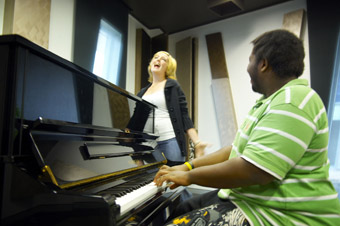
Amy Rodd, Jeremiah Mutagubya, James Cook University
photo Rob Parsons
Amy Rodd, Jeremiah Mutagubya, James Cook University
AUSTRALIA IS ALLEGED TO BE IN THE MIDST OF AN ‘EDUCATION REVOLUTION.’ BUT HOW DO HIGHER EDUCATION TEACHERS AND RESEARCHERS IN MUSIC SEE THEMSELVES AND THEIR INSTITUTIONS ADAPTING TO AND BENEFITING FROM THIS CHANGING EDUCATION LANDSCAPE? BECAUSE OF THE CONTROVERSY SURROUNDING VARIOUS ASPECTS OF THE EXCELLENCE IN RESEARCH FOR AUSTRALIA (ERA) SCHEME AND ITS IMPLEMENTATION, I OFFERED ANONYMITY TO CONTRIBUTORS TO THIS ARTICLE. RESPONSES COME FROM 12 ACADEMICS IN FIVE STATES: SEVEN WORK AT UNIVERSITIES, THREE AT CONSERVATORIUMS AND TWO ACROSS BOTH. THEY REPRESENT POPULAR, CLASSICAL, WORLD AND NEW MUSICS AND MUSIC EDUCATION.
At one stage the Australian Federal Government funded 20 categories of research output, including creative research. This ended when an independent audit identified inconsistencies in 45% of claims. The result was a decade during which just four categories of research were recognised: authored books, peer reviewed journal articles, fully refereed conference papers and book chapters. In February 2008, the Federal Labor Government announced ERA, a new research framework with a 2009-10 budget of AUD$35.8 million. Full implementation of ERA is scheduled for 2010.
In 2008, Julia Gillard said of the Education Revolution: “For the first time in many years, Australian Universities will have a Federal Government that trusts and respects them. A government which understands the formation of knowledge and skills through teaching and research is the indispensable—absolutely indispensable—precondition for the creation of a stronger economy and a more confident and equitable society.”
While the reaction from contributors was generally positive, there is a perception that the government lacks understanding about education and research. Aligned with this is scepticism. One music educator, only too aware that the recommendations of the 2004 National Review of School Music Education have still to be implemented, added, “rhetoric does not always meet reality so I look forward to finding out how this position will be enacted…” The timing of the proposed initiatives was also cause for concern: “most of it is to come closer to the next election.”
Theoretically, the creative arts will benefit enormously from ERA’s recognition of creative works in four categories: Original (creative) works in the public domain; Live performance works in the public domain; Recorded (performance) public works; and Curated or produced substantial public exhibitions, events or renderings. In line with this, contributors commented on changes to the ways in which music academics and faculties are thinking about creative practice and research. As one Head of School explained, “The inclusion of the creative arts in the data collection of research outputs is critical for the arts sector of higher education to feel fully franchised and not always having to argue the case”. However, she went on to warn:
“This ERA trial will test the Australian Research Council (ARC) and the government’s commitment to the inclusion of creative arts in the higher education system, and it will test the creative arts academics in their capacity to step up and make a sound and rigorous system for evaluating quality. Having said that, this mania for auditing is putting huge imposts on universities and individual researchers, and if the government really trusted us they would not put us through so much of this micromanagement.”
In terms of ERA’s immediate impact, two distinct pictures emerge. The first includes the institutions that have not previously recognised creative research. Many of these institutions have “no systematic approach to the collection of this material.” In these, artist academics “have been completely demoralised by the many years of non-recognition of creative outputs.” This has often resulted in a creative practice separate from academic life, or the abandonment of creative practice altogether in favour of traditionally notated research: “I have neglected my arts practice in favour of written research because I never thought anything would change.”
In contrast, institutions that have recognised creative research despite its exclusion from the national research agenda are ideally positioned to engage with ERA. First, much of the required evidence has been collected. Second and perhaps most importantly, internal recognition has enabled academics to integrate their creative practice into their academic profiles, prioritising it as one might any other form of research.
There is a need to ask why creative practice has to be justified as equivalent to traditional scientific research rather than being recognised in its own right. Aside from the fact that writing about one’s creative practice can contribute positively to that practice, “not all creative artists want to view their practice as research.” There is also scepticism as to how ERA will evaluate creative practice and how it will compare with traditional research such as journal articles: “Without knowing what kind of recognition will be given to creative practice outputs it is difficult to get over-excited about the re-inclusion of creative output”. Many academics will find their creative practice attracting attention for the first time: “People who haven’t submitted their creative works over the years are [being] encouraged to do so.” Some faculties are mindful that creative practice has yet to be accepted or understood within their own institutions, adding an internal battle to the national one: “the university has to modify its systems and attitude.”
The process of making creative work eligible for funding under ERA is far from simple, requiring a range of evidence in a format that can be stored digitally. Academics are facing not only the collection of evidence relating to each work, but the challenge of collecting data “when the rules change after the period that is being assessed.” For the 20% of outputs subject to peer review within a research code, each must provide a 250-word statement that describes the research background and questions, contribution to new knowledge, and significance of the research. The complexities of this were brought home to me as I attempted to write a background statement on the originality and research behind the performance of a 19th century viola concerto!
journal ranking
The ranking of journals is contentious across almost all disciplines and is not restricted to Australia. With news of the European equivalent ERIH (European Reference Index for the Humanities), the editors of 55 European journals published a joint editorial in which they described the scheme as “putatively precise accountancy…entirely defective in conception and execution”. “Great research”, they argued, “may be published anywhere and in any language. Truly ground-breaking work may be more likely to appear from marginal, dissident or unexpected sources.” The editors predicted that ERIH will lead to “fewer journals, much less diversity and [will] impoverish our discipline.” They have asked the compilers of ERIH to remove their journals from the list, concluding: “we want no part of this dangerous and misguided exercise.”
Many of the same concerns were expressed by academics here, who feel that “the consultation was too short and not wide enough”, leading to “reputable journals missing from the list entirely” and bias towards traditional areas of research. One academic described the rankings as a “seriously vexed problem and one that needs solving to have any credibility.” Moreover, she questioned “the enormous waste of effort that these processes have to exert”. Given that we are in the ERA data collection period, I asked whether the rankings are already influencing academics’ choice of journals. One contributor said, “I am largely defiant… and publish where I think what I have to say will best reach its intended audiences, which ranges from top-ranking to non-peer-reviewed outlets.” For others, however, rankings are certainly influencing journal choice: “I have modified the fora in which I publish to those that are more highly regarded.”
Direct pressure from universities is a key factor in these decisions; some universities will only reward articles ranked B or higher, and there are obvious implications for promotions. One contributor commented, “I have applied for study leave next year and have been advised that if I don’t say that the work I produce will be submitted to A or A* journals then my chance of getting study leave will be greatly diminished.” In short, it is likely that “the journal ranking will see some journals disappear and others have an even longer response time to article submission.” With the almost certain demise of many unranked or lower ranked journals, including many ‘regional’ journals, publishing will be much more difficult for those new to traditional research, and those publishing in new, interdisciplinary or emerging research areas.
legitimised creativity
On a more positive note, ERA will potentially give artist academics “more confidence to consider their work as a legitimate part of their academic jobs.” It will promote “stronger links between practice and reflection” and will encourage “more activities that combine research and music-making.” The fluidity of approaches engaged by creative researchers is potentially of great benefit to the academy, whether or not the outcomes are documented in traditional narrative form. Thus, ERA also has the potential to “educate others in the academy about the innovative and expansive field of art.”
artstart
The ArtStart initiative will be delivered by the 2009-10 Federal Goverment Budget. The scheme is designed to assist graduate artists up to the age of 30 make the transition from study to career. With an allocated budget of $9.6 million, the program will run for four years and will be administered by the Australia Council. 200 grants of up to $10,000 will be awarded each year, with the first round to be advertised soon. According to the Australia Council, general information, draft guidelines and funding categories are “not yet available.” The only contributor to have heard about ArtStart was a Head of School with a visual arts background.
Not surprisingly, contributors are positive about the scheme “even if it provides one more opportunity before a tougher life begins.” However, eligibility is an issue: “it would be good to have some specific information about the eligibility of performing arts in this scheme. It currently reads as having a creative rather than a performing arts focus.” Without more information, the rest is merely speculative: for example, how will new graduates compete with 29-year-old artists with established track records? Will some genres be disadvantaged in favour of postmodern or ‘high’ arts? Are the performing arts with their collaborative and ensemble structures eligible for funding? ArtStart and ERA have much in common in terms of uncertainly, and only time will tell whether their impact is negative, positive or indifferent.
See Editorial—Journals under Threat: A Joint Response from History of Science, Technology and Medicine Editors. Reproduced in Historical Records of Australian Science, 2008, 19, ii-iv. www.pubmedcentral.nih.gov/articlerender.fcgi?artid=2629173
Heartfelt thanks to the twelve academics who contributed such frank accounts of academic and creative life, and to other colleagues across the arts who offered their insights and wisdom.
RealTime issue #92 Aug-Sept 2009 pg. 6
© Dawn Bennett; for permission to reproduce apply to realtime@realtimearts.net
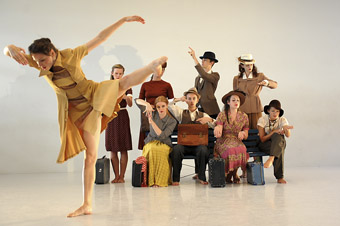
dancers from Link Dance Co,
WAAPA, performing Chrissie Parrott’s new work Reaching Veldrada, 2009
photo Christophe Cantano
dancers from Link Dance Co,
WAAPA, performing Chrissie Parrott’s new work Reaching Veldrada, 2009
TWO INITIATIVES THAT WILL DETERMINE SOME OF THE SUCCESS OF THE RUDD GOVERNMENT’S COMMITMENT TO AN ‘EDUCATION REVOLUTION’ AS FAR AS PERFORMING ARTS GRADUATES, ACADEMIC ARTISTS AND THEIR INSTITUTIONS ARE CONCERNED, ARE THE EXCELLENCE IN RESEARCH FOR AUSTRALIA (ERA) INITIATIVE AND ARTSTART.
An aspect of ERA (which will assess research quality within Australia’s higher education institutions) that met with approval from all interviewees for this article was the explicit inclusion of practice-led research in the submission guidelines. As Maggi Phillips, Coordinator of Research and Creative Practice at Western Australian Academy of Performing Arts (WAAPA) says, ‘it’s the first time they’re envisaging artistic practice being accepted as research, so fundamentally, the concept is right.”
Clare Grant is Lecturer in Performance in the School of English, Media and the Performing Arts at the University of New South Wales (UNSW}. Questions are still to be answered regarding how the new ERA system will pan out, she feels, but she is optimistic about its implementation. “As a practitioner, my main goal is to try and get new performance makers out there into the world. It means a lot of keeping up with what’s happening, and occasionally giving dramaturgical support to young people on various kinds of projects.” In the past, Grant says, this had to be done in addition to other commitments demanded of her position. Under the new guidelines, the way UNSW views her work obligations is now more in accord with how she has always understood her role, she says. Her mentoring and dramaturgical work will be recognised, reducing the stress of having to justify time spent in this way.
Jonathan Bollen, Senior Lecturer in Drama and Honours and Postgraduate Co-ordinator, Drama at Flinders, is unsure whether ERA will bring improvements for the artist-academic. Because, he says, ERA is simply a mechanism to allocate resources to universities. Whether there is a positive impact will depend on how universities do their reporting. “ERA may provide a box you can tick for performing arts, but whether it will change how the work is valued in institutions and the ease with which it is undertaken is still unclear.”
peer review complications
Maggi Phillips believes that, on balance, ERA is a positive development. The problem, she says, is in the evaluation method. Peer review is “a very complicated and expensive exercise when looking at everything throughout Australia and all universities.” Research output will be also assessed under the more traditional system, including journal citations, in which practices as diverse as performance, poetry and lighting design will come under the same code. How successfully these methods will evaluate research output, she believes, is yet to be seen.
Peter Hammond, Head of Performing Arts and Lecturer in Theatre at the University of Tasmania (UTAS), is enthusiastic about ERA, believing the changes will “put creative arts on the table and upfront” and he is hopeful that the new system will mean more money filtering into performing arts education. He anticipates problems with the peer review aspect of the assessment, however, particularly for performing artists in remote areas. “What constitutes peer review if those artists are in isolation?” He also found a significant drawback in the initial ERA trial for the humanities and creative arts cluster” “It has been very limiting for us …we have to decide which 20% of outputs are a genuine representation of our creative and research work. I have found that quite difficult, to leave certain artists out and to justify the inclusion of others.”
Will Peterson, Head of Drama and Theatre Studies, Monash University, while concurring with the inclusion of practice-base research, sees potential problems with the peer review aspect of evaluation. Because of the relatively small pool of viable performing arts courses, there exists a high degree of familiarity between practitioners, making anonymous, objective assessment difficult. He also believes that the discipline code system discourages interdisciplinary research and scholarship. His research, for example, might be published in Asian studies, cultural studies or anthropology journals, all of which fall into another discipline code. Under ERA, he says, performing arts academics will be rewarded “for staying in our own little field.”
artstart
Graduate artists are the focus of ArtStart, which aims to assist them establish their practice and support their transition from study to career. The Australia Council will administer the program, with 200 successful applicants per year over four years receiving up to $10,000 each. Are grants of this type the best way to help graduating artists and how are performing arts institutions already supporting students with the transition to the industry?
National Institute of Dramatic Art Director and CEO Lynne Williams hopes to further expand what she calls “the pathways into industry” already offered by NIDA. A new initiative was launched this year called Springboard, where recent graduates can collaboratively apply for an opportunity to develop a performance project. The successful groups have access to NIDA’s rehearsal and performance spaces, assistance in technical and marketing areas and a small amount of funding. There are also plans for a mentoring program where graduates are linked up with alumni in their field. Recently, NIDA has attracted Federal Government funds to support a feasibility study into an enhanced program of postgraduate courses and other continuing professional development opportunities for the arts and entertainment industry to further ensure successful and sustainable careers.
Will Peterson remembers how crucial it was for his development as an artist to have the opportunity to develop a work in his early years and would welcome a grant that would facilitate a similar experience for today’s graduates. “You get really hungry when you’ve had that experience once. You will do almost anything to ensure it continues.” He does, however, have concerns for mid-career artists, no longer “flavour of the week”, who also struggle to secure ongoing funding for their work.
Jonathan Bollen, too, welcomes the $9.6 million earmarked for emerging artists and wouldn’t like to see any of this money siphoned off for older artists, because “I teach young people, and I’m interested in the work they do, that’s where my investment is.” In general, he says, ArtStart looks good, particularly if it supports young artists working with each other rather than seeing their skills and ideas incorporated into established companies.
While Peter Hammond supports grants for graduate artists he would like to see the money tied to an educational purpose or a marketing outcome. UTAS’s company, CentrStage, utilises staff from the school of visual and performing arts, professional performers and graduates. Current students also gain valuable experience and training by crewing CentrStage shows. Hammond would like to see CentrStage in a position to expand their one-year salaried apprenticeship program for a selected graduate.
The Monash University Academy of Performing Arts Graduate Theatre Ensemble, under artistic director Peter Oyston, likewise gives students, who are admitted annually by audition and interview, “experience in creating professional theatre and learning industry practices to provide them with a realistic threshold into the performing arts industry as directors, dramaturgs, producers and performers.”
Maggi Phillips believes the transition from education to industry is very difficult “especially for dance and theatre.” However, she’s concerned that the money to finance grants such as those proposed may mean funding falls away in other areas. “For example, if that means that companies and the arts infrastructure are not supported properly… you might have young artists ready for transition but there’s no work to go to.” Rather than offering individual ArtStart grants, a case could be argued, she says, to instead fund programs like WAAPA’s graduate dance company, Link, which BA students can apply to join in their honours year and which Advanced Diploma students can use to convert to a BA.
Clare Grant broadly supports grants to help emerging and graduate artists, but also points to the success of companies like PACT Theatre in developing the practice and skills of young artists and is keen to see the support and funding it gets continue. However, she says, each year several young artists graduate from UNSW without developing links with projects such as PACT’s and they, especially, may well benefit from a grant that provides them with the space and time to consolidate their work.
Clearly, there’s enthusiasm among academic-artists about ERA but much has yet to be resolved about peer review procedures and the scheme’s artform categories—where, for example, does interdisciplinary work, so central to the arts these days, fit? It seems unwise to place limits on creativity at the very moment you acknowledge it as research. ArtStart has also had a broadly positive response, but given the collaborative nature of much theatre and dance, and various schools’ establishment of graduate companies, the value of implementing small, individual ArtStart grants will need serious consideration.
RealTime issue #92 Aug-Sept 2009 pg. 8
© Maryrose Cuskelly; for permission to reproduce apply to realtime@realtimearts.net
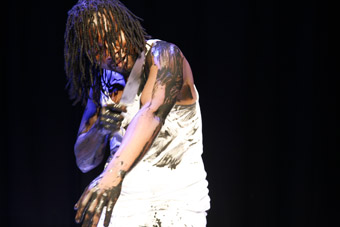
Alexander C Bede, SCRUB
photo Christa Holka
Alexander C Bede, SCRUB
EAST END COLLABORATIONS—A PARTNERSHIP BETWEEN QUEEN MARY, UNIVERSITY OF LONDON AND THE LIVE ART DEVELOPMENT AGENCY—CELEBRATES ITS 10TH ANNIVERSARY THIS YEAR. THE OCCASION WAS MARKED BY A LIVE ART WEEKEND AT QMUL INTRODUCED BY SUSANNAH HEWLETT’S ‘JINGLE’, “PROUD TO BE PRESENTING”, AND HOSTED BY THE INDEFATIGABLE TAMMY WHYNOT (LOIS WEAVER) IN FEATHER BOA AND PLATINUM WIG.
Day one features artists who performed at previous EEC platforms and is their opportunity to reflect on subsequent development. A common refrain is how making work is contingent on myriad factors—money, space, mood, context, opportunity…I like the simplicity and honesty of Sheila Ghelani’s video Grafting and Budding…still, about the process of revising a piece for different contexts. Composed of close-up shots of a hand resting on a diary page, interspersed with stills, it trips along to Colin James’ catchy “Five Long Years”, also acting as effective documentation of the original performance—apple halves skewered and clipped together, placed in Barnett Newman-like zip markings of blood and spice.
Conversely Emma Wolukau-Wanambwa’s Documentation of Cooper House—no doubt a beautiful work as a mixed-media installation—suffers from the absence of the artist and/or lack of contextualisation. Richard DeDominici contributes Plagiarismo! Redux, a comic, accessible slide-lecture on plagiarism (“Which came first: the swan or the police van?”). More conceptually sophisticated though are Angela Bartram’s Untitled, a lecture on her work (Spit and Lick; Licking Dogs) and Oreet Ashery’s video installation Back in Five Minutes. Bartram’s footage of herself and various dogs engaged in mouth-to-mouth licking is underpinned by a theoretical enquiry around notions of abjection and the anti-social mouth and succeeds in making viewers very uncomfortable; whilst Ashery explores disappearance and otherness.
The second day includes discussions, advice sessions (Everything You Wanted To Know About Live Art But Were Afraid To Ask) and this year’s platformers. The range is impressive: from work openly dealing with ‘issues’ to the sensory seduction of Poppy Jackson’s Untitled where, amid birdsong, smells of melting wax and poster paint, a woman with red bunting wrapped round her wrists balances on a birthday cake in the yellowy light of a summer’s day. Incarceration—Lisa Wright’s caged girl-as-mannequin lit by strobe lights—also stuns. Sian Robinson-Davies’ Disguised as Things is a witty, economical work about becoming inanimate in the context of liveness. At its start we’re handed plastic flowers to throw at the stage when performers take their bow. Format: a man reads the sign he holds (“the lamp”) and a woman becomes it (wearing a shade on her head, trailing a flex, reading a newspaper). This continues: “the jacket”; “birdie”; “the mirror”; “the apple tree”. The last is “the vase” in which both performers drink water then bow….Still life that won’t stay still or a lecture in semiotics?
In a Britain with newly-elected, neo-fascist Euro MPs, Alexander C Bede’s dissection of race, SCRUB, feels especially pertinent. There is a black coffin filled with what looks like white tissue and a table laid out with a selection of cleaning implements: sponges, towels, wire wool, a knife, bleach. Black and white grow more sinister: the white-suited, lone black performer, his bare arms coated in black paint, scrubs away to make himself lighter. When he asks us to pass him something, no-one wants to move, unwilling to be complicit in this bleaching game. The spoken text (about the need to be whiter for better prospects) is redundant: the smell of bleach suffusing the room and Bede’s reddening skin are powerful enough.
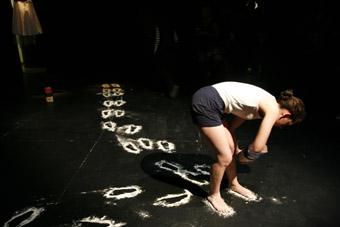
Rachel Mars, Unto Us A Child Is Born
photo Christa Holka
Rachel Mars, Unto Us A Child Is Born
Rachel Mars’ unashamedly feminist Unto Us A Child Is Born also impresses. Entering the space, I’m asked “Luke Skywalker or Princess Leia?” As Skywalker, I receive a packet of self-raising (rather than plain) flour labelled “Grip me.” Mars asks if anyone has ballet dancers in the family; muses on the difficulty of reconciling a desire for femininity with self-identification as a tomboy; longs for weightlessness without the need to be lifted. The text shifts: conversational, funny, confessional, statistical, self-deprecating, quasi-poetic (she calls Baby in Dirty Dancing a “befrocked snowstorm of soft focus”) till she is climbing a rope ladder in high heels and a netted white dress. “If you could just lift your own weight”, she says, hanging impressively from a bar in the rafters. “It’s very close to theatre”, someone mutters (an accusation levelled at Rose English years ago, so Mars is in good company).
Another performer to look out for is Martin O’Brien. Unlike Ben Connors & Holly Darton’s Couple or Jungmin Song’s A Reel to A Reel which test audience endurance, O’Brien’s durational work Repetitive Strain Syndrome is utterly compelling. Legs taped together, he stumbles on gold lamé heels across a floor littered with a plunger and bits of coal-like faeces whilst a zealous dominatrix in a gimp mask sets tasks and abuses him. When she hands me a wooden pole, I nudge his waist. Another viewer is more vigorous, appears to have discovered his sadistic streak. Occasionally, a musician twangs an electric guitar or O’Brien stops to describe a gruesome punishment—the scold’s bridle, the stocks. Sex game or act of torture, it’s a real tour de force.
In an inspired installation, Lindsey Price and Francesca Millican-Slater’s Ed Venture’s Quintessentially English Tea Room honours the nation’s legendary attachment to tea. I am seated with strangers, my order taken by a uniformed waitress. Place mats encourage writing on the tablecloths, suggesting “the weather” and “tea stories” as suitable topics of conversation; I unwrap a personal message: “first love.” Sipping loose-leaf Earl Grey from patterned china and indulging in cup cakes, we talk about the performances we’ve seen so far. An opportunity to network in a relaxed way, the tearoom is a joyous antidote to the homogenous chain café. One of my tea companions wonders whether this piece is symptomatic of a recession-friendly genre of performance where the viewer-participant is treated more gently. Quite possibly. For me it sums up East End Collaborations: a site of nurture and debate from which I, like live art, emerge re-energised.
Queen Mary University of London and the Live Art Development Agency, East End Collaborations 2009—Tenth Anniversary Platform; Queen Mary University of London June 5, 6, www.thisisliveart.co.uk
RealTime issue #92 Aug-Sept 2009 pg. 10
© Marie-Anne Mancio; for permission to reproduce apply to realtime@realtimearts.net
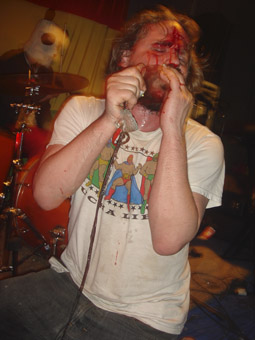
Lucas Abela, Yang Yang (in panda suit), Rice屎Corpse
photo courtesy the artists
Lucas Abela, Yang Yang (in panda suit), Rice屎Corpse
TONGZHOU IN BEIJING’S FAR SOUTHEAST HAS BECOME SOMETHING OF A HAVEN FOR MUSICIANS GRAVITATING TO THE CAPITAL FROM ALL OVER THE COUNTRY. THEY ARE ATTRACTED BY TONGZHOU’S CHEAP RENTS AND BEIJING’S THRIVING ROCK SCENE, CENTRED ON A HANDFUL OF CLUBS LIKE MAO LIVE, DOS KOLEGAS, D-22 AND YUGONG YISHAN.
Punk-influenced rock is Beijing’s staple musical diet, but local venues host an eclectic range of events, including talks, films and avant-garde music performances. It was this burgeoning scene that prompted Sydney-based noise musician Lucas Abela, famed for his aural onslaughts on a miked and effected pane of glass, to apply for an AsiaLink residency. The result was Rice屎Corpse–an improvising band with Abela on glass, Yang Yang on drums and Li Zenghui on piano. (‘Rice corpse’ is the literal translation of the Chinese character for ‘shit’). They had four rehearsals, two of which were recorded providing the material for Mrs Rice, a CD co-released by Abela’s own Dual Plover label and Subjam through its experimental wing Kwanyin, run by Yan Jun, a dynamic force in the Beijing experimental scene. The trio then proceeded on a 10-city tour of China: Beijing, Tianjin, Yinchuan, Lanzhou, Xi’an, Chengdu, Guangzhou, Changsha, Wuhan and Shanghai.
Abela was very strategic in his approach to the project. He chose China for his residency because “when you’ve got 12 grand to spend and you want to get a lot out of that money I thought China would be the go. But I was interested in China as a place—politically, socio-economically, ethnically—all sorts of strange things are going on there. So I got Yan Jun from Subjam to host me. The thing that I like about self-initiated residencies is that it shows that I have initiative and drive, but also, I’m the only person in competition for it!”
Abela had a clear vision that he needed a drummer and a pianist. With Yan Jun’s help he teamed up with drummer Yang Yang, a well-known figure in the scene recently described by Time Out Beijing as the “spiritual leader” of the Tongzhou community. He presides over the noise band Mafeisan, often performing with a bag over his head (and for this tour in a panda suit). Finding a pianist proved more difficult, however owner of Sugar Jar records Lao Yang recommended Li Zenghui, currently a solo saxophonist and part of the duo Hetao shi (Walnut Room). Li had played keyboards in bands when he was living in Qingdao, a resort town on China’s east coast, where coincidentally Yang had also spent some formative years playing in experimental rock bands before gravitating to Beijing.
Abela was interested in the piano and drums forming a rhythm section. “I think I aurally hallucinate when I play, because I’m hearing all sorts of things. I’m always playing along with this imaginary band in my head. In this instance I’ve got this real band, and they’re outwardly influencing me. I’m hearing them and I’m following a rhythm or following a change of theirs. It added new elements—made me play in different ways.”
The tracks on the CD Mrs Rice were recorded at the very nascence of the group, during their first rehearsals. “All the tracks are completely improvised. I was only there for a month and in the first couple of weeks I was trying to get the band together. When we finally got together we only really did four rehearsals [of which] two were recorded and edited down to the album. There are a couple of other tracks that I wanted to put on the album. I mixed them and finished them but Yan Jun from Subjam said ‘the album’s too long, you should just make it tighter, it’ll have more impact.’ I don’t usually think that way, but he was completely right and taking those tracks out made a much more cohesive record.”
Jun offered good advice—Mrs Rice is a concise, punchy album. While Abela was looking for a format that would let him ‘play lead’, the piano and drums are far from just backup. There is a real sense of shared exploration across the tracks, and more dynamic range than the all out splatter mayhem that one usually expects from Abela. As they shared little to no spoken language, the sense of the artists getting to know each other musically is particularly strong and engaging. Yang Yang says “If you ask me whether language itself is a hindrance or a barrier, of course language would help. But every musician uses music to communicate.”
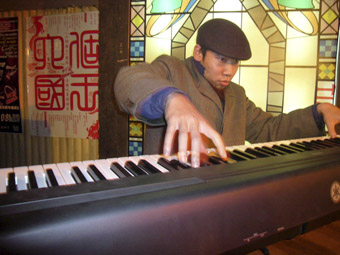
Li Zenghui, Rice屎Corpse
photos courtesy the artist
Li Zenghui, Rice屎Corpse
Abela had toured to four cities in previous visits, but the Rice屎Corpse tour extended further into northern and western China, thanks to the band’s personal networks. Abela says “the circuit is growing, there are lots of live houses. There’s less for the kind of stuff we’re doing, but there’s just so many cities there. Things that you wouldn’t even look at on a map and are probably bigger than Sydney. If you splintered even 1% of the population, there’s still a decent touring circuit for the bands in China—especially for the punk bands.” However for experimental musicians, it’s still hard to make a living, and audiences are only just developing. Yang describes reactions: “It was more or less the same, but the audience was divided into three categories. First were those who left as soon as we started playing. The second stayed to the end and then said, “That was dog shit!” The third got excited. But the number who got excited was very few…because experimental music has only just started in China, so most people don’t know about it.”
With increased attention on the underground music scenes, I asked Abela if there was any truth in the press predictions around the time of the Olympics, that Beijing is becoming the new Berlin? Abela says: “It could become a Berlin type scenario for foreigners who could easily move in and live off nothing, but they probably won’t make money as musicians. There’s more happening on a nightly basis than in Sydney, which is saying something…But I think they do it a lot harder in Beijing than the Europeans.” An important distinction is that while the Chinese government tolerates experimental music, there is no institutional support in terms of arts grants or even community radio. In fact the national media still doesn’t support rock music, let alone experimental acts, with only traditional folk and Mandarin pop music permitted. Yang says pragmatically: “Experimental music has nothing to do with Beijing. It has something to do with the universe. It is immortal. I do the music here because I live here. The Beijing audience is more or less the same as in other cities, [but] Beijing provides many chances to perform. In other cities there is no chance. Here you can get information and opportunities.” Li offers a more poetic view of the potential: “Beijing has fresh air for music. In other cities there is no fresh air.”
For Abela, the band experience was particularly important for developing the perception of his glass playing as not merely a freak show but a serious musical pursuit. “I’ve been playing glass since 2003, but from a technique I’ve been developing since the late 90s. I see it as a new instrument. I vibrate the glass, press it against my lips and hum and vibrate this sheet, I can’t think of another musical instrument that works in that way. It’s not wind, I’m not blowing through it; it’s not percussion, I’m not hitting it; it’s not strummed; I’m like vvvvhhhhh—just vibrating the sheet. One of the reasons why I wanted to move into a band context was to show off its musicality, which no one really sees when I play it because I’ve got very discordant taste.” However, after initially deciding to not complete each show with his signature glass smashing and face gashing, he couldn’t help himself. “It’s not just for the shock of it. It just seems the right way to finish a show. It’s at the heightened point when I’m feeling good and I get a rush and bang… and there’s the trickle of blood across my face [he giggles]. I love that.”
Because of the language barrier, Abela was unsure as to how the band experience was for Li and Yang. Both admit that musically they are fixed on their own trajectories, so while the collaboration was interesting, it did not so much affect their personal music making. But like all good exchanges, the effect is more far reaching than just the art. Yang says: “In terms of my music there’s been no influence, but in terms of life there’s been an unpredictable effect…” Li, a man of few words, sums it up best: “We miss Lucas.”
See also a full interview with Lucas Abela; and a review of Mrs Rice
Rice屎Corpse, tour November 2008; Mrs Rice CD, Dual Plover/Kwanyin-Subjam 029, 2009
Thanks to Wang Yi for her assistance in translating Dan Edwards’ interview with Yang Yang and Li Zenghui
RealTime issue #92 Aug-Sept 2009 pg. 12
© Gail Priest & Dan Edwards; for permission to reproduce apply to realtime@realtimearts.net
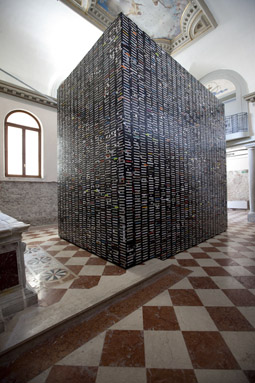
Claire Healy, Sean Cordeiro, Life Span
photo Alex Davies
Claire Healy, Sean Cordeiro, Life Span
THE VENICE BIENNALE IS THE MOST PROMINENT INTERNATIONAL SURVEY OF NEW ART. UNLIKE OTHER BIENNALES, HOWEVER, THE RATHER OUT-DATED IDEA OF THE NATION IS THE FOUNDATION OF ITS ORGANISATIONAL STRUCTURE. PAVILIONS THAT STILL REPRESENT THE POLITICS OF NATIONALITY OF THE 20TH CENTURY ARE CLEARLY A BURDEN FOR MANY CONSCIENTIOUS ARTISTS RAISING QUESTIONS ABOUT DISPLACEMENT, BORDERS AND THE IMPACT OF HISTORY ON THE FUTURE OF THE WORLD. NOT SURPRISINGLY THEN, THE MOST INTERESTING WORK AT THIS YEAR’S BIENNALE IS FOUND WELL OUTSIDE THE NATIONAL PAVILIONS OF THE GIARDINI.
off-site projects
Except for Ken Yonetani’s Sweet Barrier Reef, a rather dull comment on the effects of consumerism on nature, the Australian off-site project Once Removed curated by Felicity Fenner offers a refreshing insight into the predicament of displacement. Undoubtedly part of the show’s appeal is the extraordinary location, the Ludoteca, formerly a convent in a prime position between the Giardini and the Arsenale. At the entrance is a chapel, where Claire Healy and Sean Cordeiro present their impressive new work Life Span. 195,774 VHS tapes are stacked into a neatly arranged plinth, responding boldly to the religious architecture of the space. What is immediately striking is the weight and solidity of this monument, an exaggerated reminder of the obsolete material packaging of globally circulated screen fantasies. But the artists also reflect on the passing of time and its multiple scales; neither the crumbling walls of the old church nor the black plastic surfaces of the tapes can speak of eternity. The combined running time of these tapes is the average human’s life span when VHS was released, 66.1 years. Thinking of how many hours of pornography fill the monolith, the idea of this content flashing before one’s eyes at death is also staggering. The rumours around Venice before the opening were that the Australians had ‘video porn’ on show. Needless to say, Once Removed has been well attended.
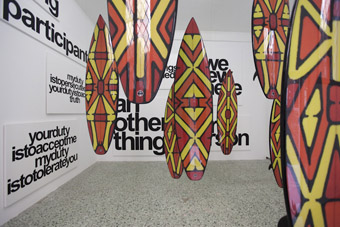
Vernon Ah Kee
photo Alex Davies
Vernon Ah Kee
Also at the Ludoteca, Vernon Ah Kee works with several dialogues between iconic Australian cultural references and their dark histories. In his video work, Cant Chant, he tells a fairytale of Aboriginal surfers reclaiming a break, juxtaposed with allusions to racial alienation and the violence of Australia’s Indigenous history. In the next room, the beautifully painted surfboards that appear in the video are hung from the ceiling as if lynched, conversing with provocative black and white wall texts such as “first person” and ‘“hang ten.”
Other standout off-site events include Unconditional Love at the Arsenale Novissimo, organised by the Moscow Museum of Modern Art. On display at this wharf venue is the extraordinary video panorama by AES+F, The Feast of Trimalchio, as well as a handful of other Russian up and comers all grappling with the future of affection in a hypersexual world.
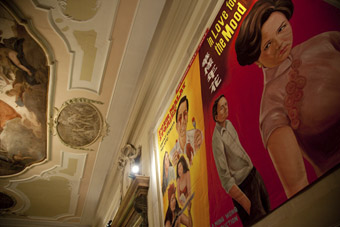
Ming Wong, Life of Imitation
photo Alex Davies
Ming Wong, Life of Imitation
Ming Wong’s solo show, Life of Imitation at the Singapore Pavilion, transforms an old Venetian palace, Palazzo Michiel Brusa, into the artist’s own quirky vision of the defining moments of Singaporean cinema with new work as well as archival materials. Often performing himself, Wong reconstructs the plural veneers of Asian language and identity in a series of re-invented multi-channel video installations, such as In Love for the Mood. Promotions painted by Singapore’s last surviving movie billboard painter, Neo Chon Teck, renegotiate the appropriated video content and the artist’s seemingly inexhaustible interpretations of the history of human melodrama.
These off-site pavilions and collateral exhibitions can be difficult to find in the labyrinthine alleyways of Venice, but away from the hype of the Arsenale and Giardini, they are truly highlights of the biennale.
giardini pavilions
For most exhibitors in the main pavilions, grappling with national identity is part of the brief. Shaun Gladwell’s slickly presented MADDESTMAXIMVS is no exception. Gladwell’s rapid ascent to international success has not been without criticism, but his solo exhibition at the Australian Pavilion does rise to the challenge of the biennale, transporting visitors to a particularly Australian time and space. Before they even get there, Biennale-goers are hooked, pausing at the promotional posters lining Venice’s canals of a leather-clad and helmeted Gladwell cradling roadkill in the searing Australian desert; “Is that a real kangaroo?”
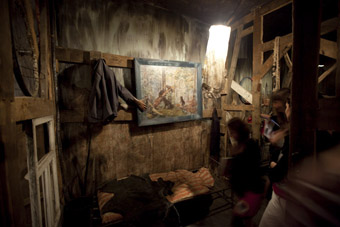
Gosha Ostretsov, Art Life or the Torments of Creation
photo Alex Davies
Gosha Ostretsov, Art Life or the Torments of Creation
For taking viewers on a journey to the unfamiliar and ridiculous, the best pavilion is the stylised Victory over the future. In reference to the Futurist opera Victory Over the Sun, Russian curator Olga Sviblova has chosen ironic artists who deal with the way representations of the past can reveal the future. The first room is filled with the utopian drawings and poetic texts of Pavel Pepperstein. Dated earnestly into the next few thousand years, the work appears like a set of souvenirs from somewhere we can never visit. In the basement is the biennale’s only haunted house, Gosha Ostretsov’s Art Life or the Torments of Creation. Hands emerge from otherwise empty coats and rhythmically rock creepy scenes of rural life. A phone rings, but the voice on the other end quickly hangs up in a panic. A mechanical mannequin (presumably representing the artist) sits at a wooden desk, inexhaustibly sketching in dim lamplight. No doubt about it: the Russians know how to make the future seem spooky, yet oddly hilarious.
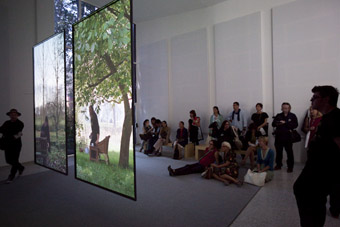
Fiona Tan, Disorient
photo Alex Davies
Fiona Tan, Disorient
The othr pavilion not to be missed is The Netherlands, dedicated entirely to the work of Indonesian-born Fiona Tan. All three of her video works are outstanding, but it is Disorient, a two-channel projection that draws the crowds. The work takes as its departure point the original texts from the 13th century voyages of Marco Polo. These point to video montages of contemporary daily life across Asia and the Middle East, covering the same territories as Venice’s most famous merchant, but representing a more complex reality with which the European empire, even with all its trade and adventure, has never come to terms. Marco Polo’s symbolic commodities still exist—indigo, spices, oil, silk—but Tan places them in the context of contemporary violence, poverty and exploitation, documenting ragpickers sorting through the waste piles of India and American soldiers intimidating Iraqi civilians. This is more than a nod to the colonial history of Europe. Tan’s work also shows that, if we really look, within the subject-artist relationship are all the ugly and intimate contradictions of continuity and change.
making worlds
Daniel Birnbaum, the Biennale’s 2009 director, defines his curatorial concept with the title Making Worlds, attempting to credit the methods and strategies of artists everywhere. The massive group exhibition includes the work of over 90 artists. The theme may be vague (how could an all-encompassing global artistic vision be anything else?), but the selection of work is extraordinary. While there is dialogue between artists, it is refreshing to see that there is no universal language here.
Outdoors, in the beautiful Giardino delle Vergini (Garden of the Virgins), is a maze of site-specific interventions by younger artists such as Miranda July, who gently teases her audience with colourful invitations of poetic self-portraiture. Chinese artist Chu Yun’s Constellation No. 3 is just as whimsical; a glorious universe of flickering stars in a darkened room, revealing itself on closer inspection to be created by the familiar flashing indicator lights of fridges, kettles, microwaves and fax machines.
The overall impression of the biennale is predictably sensational and generalised. Such a quantity of art arranged under the clumsy classification of nations may be impossible to be otherwise. But within its component parts, scattered throughout Venice, appears a scale of specificities showing that artists of the world may, in fact, not have so much in common after all.
The 53rd Venice Biennale, June 7-Nov 22
RealTime issue #92 Aug-Sept 2009 pg. 14
© Alexandra Crosby; for permission to reproduce apply to realtime@realtimearts.net
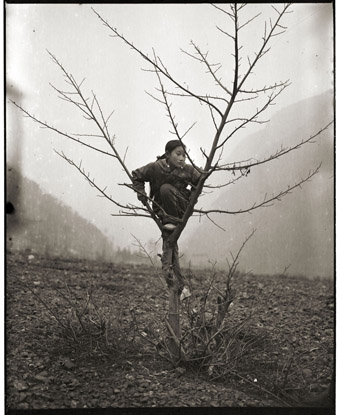
Girl and Tree, 2006, Adou
photo courtesy the artist
Girl and Tree, 2006, Adou
GIVEN THE ATTENTION AFFORDED CHINESE CONTEMPORARY ART OVER THE LAST DECADE, IT’S REMARKABLE HOW LACKING THE NATION IS IN PHOTOGRAPHIC INSTITUTIONS. “ON THE SURFACE CHINA SEEMS TO HAVE AN ABUNDANCE OF PHOTOGRAPHIC HISTORY. BUT IN FACT IT DOESN’T HAVE ITS OWN FOUNDATION OR SYSTEM—THERE ARE NO PHOTOGRAPHIC MUSEUMS, ARCHIVES, OR COLLECTIONS”, ASSERTS PROMINENT CHINESE PHOTOGRAPHER RONG RONG. “BECAUSE CHINA LACKS THESE THINGS WE WANTED TO START AND SLOWLY BUILD THEM UP, SETTING UP A PLATFORM TO INTRODUCE PHOTOGRAPHY TO A BROADER AUDIENCE.”
With this aim in mind, in June 2007 Rong Rong and his wife Inri created the Three Shadows Photography Art Centre on the north-eastern outskirts of Beijing. A custom-built complex designed by Chinese artist Ai Weiwei, the centre has staged a series of innovative group and solo exhibitions highlighting current trends and talent in China’s emerging photographic art scene. The centre is much more than just a gallery however. A darkroom, digital studio, library, café and living quarters for four visiting artists round out what Rong Rong hopes will become a focal point of dialogue between China and the international photographic community. “We have already had six or seven foreign artists come through here”, he says. “They can produce work and use the library and darkroom, but the most important thing is to communicate with local artists.”
laying foundations
When asked why Chinese photography lags behind other visual art forms, Rong Rong replies thoughtfully. “Photography became an independent artform very late in China. Maybe this has something to do with the Chinese system, because photography has always served the government. In recent years it’s become a bit better, but previous work had no artistic value.”
To the extent that Chinese photography has an artistic tradition, Rong Rong has been a key player since his pioneering work in Beijing’s ‘East Village’ in the early 1990s. An abandoned industrial area on what was then the fringes of the capital, the East Village was briefly home to an artistic community that created works now legendary in the annals of Chinese contemporary art. In 1993 Rong Rong set about documenting these activities with his camera. His images constitute the only record of performances such as 12 Square Metres (1994), which saw artist Zhang Huan sit naked in a squalid public toilet for an hour smeared in honey and fish oil, attracting an ever-growing swarm of flies.
After the East Village was broken up by police in mid-1994, Rong Rong moved to another Beijing fringe dwelling at Liulitun (Six Mile Village). He was eventually joined by Japanese photographer Inri, whom Rong Rong met while exhibiting in Tokyo in 1999. They commenced a fruitful, intensely autobiographical artistic partnership, their creations including a beautifully mournful series commemorating the demolition of their Liulitun home in 2003.
While Three Shadows has provided Rong Rong, Inri and other established local photographers with a more permanent artistic base, seeking out and encouraging younger artists is central to their aim of building a Chinese photographic tradition. “My own experience tells me that in a certain period of your career, being encouraged or complimented by others is very important, as is the chance to communicate with other artists”, comments Rong Rong. To further this goal, the annual Three Shadows Photography Award was launched last year with a call for entries that attracted nearly 300 submissions. Judged by an international panel of curators and critics, first prize comprised a cash endowment of RMB 80,000 (around AUD$14,500).
The centre’s curatorial team initially planned to select eight to ten finalists, but narrowing the field proved difficult. “When we saw how many good works there were, we eventually settled on 31,” says Rong Rong. The finalists’ work was unveiled at an award ceremony and exhibition entitled Points of Impact: China Through the Eyes of Young Photographers on April 25 this year.
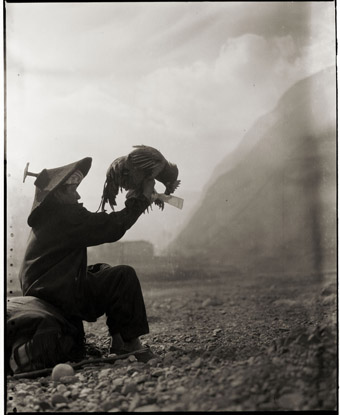
Witch and chicken, 2006, Adou
photo courtesy the artist
Witch and chicken, 2006, Adou
inner worlds
Like Rong Rong and other photographers of the 90s generation, the young artists on display in Points of Impact eschew broad social or political concerns, instead focussing on what Rong Rong describes as “their inner world.” In this sense the work of the Three Shadows Award winner is typical.
Ostensibly Adou’s winning series focuses on the Yi ethnic minority living around Da Liang Mountain in Sichuan. It’s difficult to convey the atmosphere of the large, highly textured black and white prints, and unfortunately reproductions do not adequately capture the nuances of Adou’s style. Unlike many earlier Han photographers, he does not attempt to romanticise a ‘primitive’ minority culture, nor is his work in any way an ‘objective’ ethnographic study. Rather, his images appear as fragments from a traveller’s dream. Faces emerge with sudden clarity while others remain hazy and indistinct, lingering on the edge of memory. The inclusion of photographic ‘faults,’ such as bubbles, flares, scratches and smudges—products of Adou’s habit of using expired stock—furthers the impression of an intermediate zone between past and present, reality and the imagination.
While talent scouting in southern China, Three Shadows curator Zhang Li discovered Adou selling his prints on the roadside. Back in Beijing, Rong Rong was immediately struck by the images. “I feel Adou’s work has the weight of time and history in it”, he enthuses. Rong Rong persuaded the unknown artist to reprint his photographs using hand-processing techniques, accentuating their foggy, textured quality. Adou’s appearance in Three Shadows’ Outward Expressions, Inward Reflections exhibition in 2008 marked his gallery debut.
In addition to the main Three Shadows Award, the Japanese Shiseido Foundation provided a RMB 20,000 (around AUD$3,600) prize to an emerging Chinese female photographer, which went to Beijing-based artist Zhu Hongling. Her set of eight slightly grainy black and white images of scenes around China were by turns amusing, grotesque and horrific.
Horse Head, Hebei Province, depicts an animal’s severed head lying on an empty patch of ground, its frozen lips stretched back in anguish. The sense of life’s frail impermanence forms a moving contrast to the blank, timeless observance of the surrounding hills. In opposition to this austere vision, Fat Woman on a Beach, Qingdao depicts an overweight lady facing a shoreline packed with bathers—an immodest picture of over consumption in a severely crowded land.
The most effective of Zhu’s images is Elephant Acrobat, Beijing, depicting a lone animal seen from afar, balancing on a stool in a sandy expanse below a hill. Apart from two small trainers looking on, the landscape appears devoid of human life, until tiny figures observing the scene from the hillside become gradually discernable. The photograph conveys a sense of loneliness as well as absurdity, like the forgotten remnant of a long departed circus.
Not all the works on display were of the same quality. A prize of US$5,000 and a fellowship provided by the USA’s Tierney Foundation went to Jiang Pengyi, whose colour photographs of abandoned objects on tabletops lacked the generative appeal of the other prize winners. Liu Yuan’s prosaic colour shots of buildings and nature strips were similarly uninspiring.
Despite the varying quality of the finalists’ work, many have attained a surprising maturity given their youth and China’s lack of support for the photographic arts. The talent unearthed by the award demonstrates the importance of an institution like Three Shadows in a nation where governmental controls and a newfound thirst for wealth leave little room for the idealistic pursuit of art over commerce. Crucially for the ongoing development of Chinese photography, Rong Rong and Inri have created a space where local and international photographers can exchange ideas and celebrate a plurality of styles free from obligations to state ideology.
Points of Impact: China Through the Eyes of Young Photographers, Three Shadows Photography Art Centre, Caochangdi, Beijing, People’s Republic of China, April 25–July 26
See a full interview with Rong Rong
RealTime issue #92 Aug-Sept 2009 pg. 16
© Dan Edwards; for permission to reproduce apply to realtime@realtimearts.net
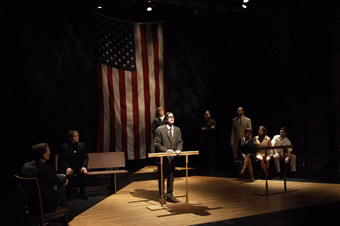
The Trial of the Catonsville Nine, The Actors’ Gang
photo Kim Zsebe
The Trial of the Catonsville Nine, The Actors’ Gang
LYNDON TERRACINI, SOON TO TAKE UP THE POSITION OF ARTISTIC DIRECTOR OF OPERA AUSTRALIA, HAS INVIGORATED QUEENSLAND’S ARTS FESTIVALS. HE QUICKLY REALISED THE DEMANDING VISION FOR A STATEWIDE, PARTICIPATORY EVENT, THE QUEENSLAND MUSIC FESTIVAL, IN 2001 AND RAPIDLY INCREASED THE NUMBER OF REGIONAL CITIES AND TOWNS PARTICIPATING IN 2003 AND 2005, ENTHUSING AND CAJOLLING MAYORS AND COMMUNITIES AND INTRODUCING THEM TO LEADING ARTISTS FROM ACROSS AUSTRALIA AS THEIR COLLABORATORS. THE LEGACY LIVES ON IN MANY OF THOSE TOWNS. TERRACINI ALSO GAVE THE CONSERVATIVE BRISBANE FESTIVAL A NEW LEASE OF LIFE, BROADENING ITS SCOPE TO INCLUDE MULTIMEDIA AND SITE WORKS, POLITICAL DISCUSSION, NEW MUSIC THEATRE AND A FRINGE SEASON, UNDER THE RADAR, REPRESENTATIVE OF A NEW WAVE OF YOUNG CONTEMPORARY PERFORMANCE MAKERS.
miracle in brisbane
A work central to Terracini’s 2009 Brisbane Festival program is Miracle in Brisbane, directed by Rhoda Roberts and featuring 25 Aboriginal, Torres Strait Islander and other artists, including Aaron Fa’Aoso, Deborah Mailman, Djakapurra Munyarrayan and Casey Donovan. The work, a largely wordless opera, “with music, dance and ceremony”, by Italian composer Giorgio Battistelli (of Experimentum Mundi fame), concerns homeless Indigenous people building a shantytown “on country” in Brisbane’s outskirts and at odds with developers. As you’d expect of Battistelli, the music of Miracle in Brisbane will in part come from the sounds of the performers constructing the shantytown to the accompaniment of The Queensland Orchestra and the Canticum Chamber Choir. Battistelli describes the opera as a “‘voiceless’ protest against inhumanity [that] highlights the incontrovertible rights of marginalised people to stake a claim in a world that ignores them.” His theme is hope.
Rhoda Roberts explained to me that Aboriginal people have long had a connection to the land on which Brisbane is built, and yet when they live on or visit it they’re seen as fringe dwellers or homeless— “We’re not, that land is our home.” When she visited Giorgio Battistelli in Milano she sensed a similar relationship between locals and the land and a “sense of purpose” that went with it. She saw the Milano performance of Miracle with its huge cast and was “struck by the expressiveness of the work, the way the music was embodied.” Roberts says that staging an opera will be a first time experience, for her and most of her talented cast, but clearly she looks forward to the creative opportunities it offers.
Battistelli’s open-ended approach to his opera has allowed Roberts to construct a local narrative for the work, a romance between an Italian cane-cutter immigrant (another marginalised figure, played here by a visiting Italian tenor) and an Aboriginal woman. The story unfolds against the construction of the shantytown with the “music of found objects and body percussion”, the voices of developers and the enforced silence of Aboriginal people.
On the festival’s ideas front, the hope theme is sustained in the person of this year’s guest Mary Robinson, former President of Ireland (1990-97) and United Nations High Commissioner for Human Rights (1997-2002). Her talk is titled: “Creating a World without Poverty: Social Business and the Future of Capitalism.” The hope inherent in fighting for one’s beliefs is portrayed in the Los Angeles-based Actors’ Gang performance of The Trial of the Catonsville Nine. It’s about the prosecution and trial of Catholic priests and activists in 1968 who burned draft cards with napalm in protest against the Vietnam War.
new circus
Innovative new circus in the program is represented by two works. Regarding the Joy of Others, is a premiere from Brisbane’s globe-trotting CIRCA, performed on the giant Brisbane gasometer at Newstead Riverpark by aerialist Chelsea McGuffin to a sound score by Lawrence English and direction by Yaron Lifschitz. L’Oratorio d’Aurélia, from French company L’Oratorio is a fantasy inspired by images from the Middle Ages with actress and acrobat Aurélia Thierrée: “Body parts disengage and even disappear, only to be knitted back together again, puppets attack their masters, while clothes, furniture and clattering toy trains come alive.”
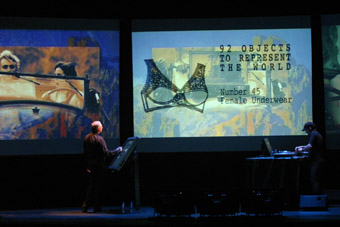
Peter Greenaway, Tulse Luper Suitcases
peter greenaway
With DJ Radar (Serge Dodwell) and electro-acoustical composer Huibert Boon, Peter Greenaway presents his major and much-travelled, large plasma touch screen work, Tulse Luper Suitcases. It’s a technical and aesthetic creation that allows the artists to VJ “the life of the Welsh writer and perennial prisoner Tulse Luper who archived his entire life in 92 suitcases.” There’ll also be a retrospective of Greenaway’s films and he’ll deliver a lecture on his documentary, Rembrandt’s J’Accuse.
total nowhere emotion expansion
In a 2009 festival innovation audiences will be able to view a media art exhibition, Total Nowhere Emotion Expansion, either online via the festival website or live at a mobile media art gallery, once a semi-trailer, travelling within Brisbane and South East Queensland locations. The eight international artists include Australians Darren Sylvester and Jemima Wyman (whose eerie video works featured recently at KickArts Gallery in Cairns) and the Philadelphia-based Ryan Trecartin, maker of a much praised feature-length video work I-Be Area, described by the New Museum, New York, as narratives that “ricochet between characters and actions, gleaning information and enacting existential dramas at hyper-speed. His characters, all constructed collaboratively with his actors, include independent avatars, people composites, culture collectors, and cyber queers—all twisted and true emblems of what the artist calls ‘a potential part-cyber today’” (www.newmuseum.org).
The full Under the Radar fringe program will be announced this month, but advance notice includes Sunny Drake’s Other-wise, Robert Millet’s Vodka & Truth, and Genevieve Trace’s misuse of a comma. Drake’s experiences as a queer/transgender individual, a traveller, a romantic, a teacher and a performer are central to his solo performance in a festival that argues for freedom, often from unexpected angles.
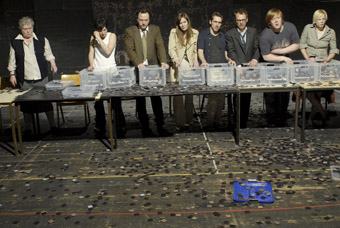
Pornography, Deutsches Schauspielhaus Hamburg
photo AT Schaefer
Pornography, Deutsches Schauspielhaus Hamburg
melbourne international arts festival 2009
Brett Sheehy’s first Melbourne Festival is strong on visiting contemporary performance, theatre and dance if low on Australian content relative to the Robyn Archer and Kristy Edmunds years. Berlin-based Sasha Waltz and Guests in their long-awaited first Australian visit will perform two works: the celebrated Körper (RT90, p10) and a dance-opera Medea with one singer, coloratura soprano Caroline Stein, text by Heiner Muller, music by Pascal Dusapin played by the Melbourne Symphony Orchestra and Vocalconsort Berlin, 17 dancers and video by Waltz. Deutsches Schauspielhaus Hamburg’s production of British playwright Simon Stephen’s Pornography comprises seven narratives about Britain under attack from both terrorism and “the pornography of the everyday.” Belgian company Le Salon’s much anticipated Peeping Tom fuses theatre, dance and song (from mezzo-soprano Eurudike De Beul). Like Stephens’ Pornography it portrays a culture in decline, here exemplified by a family falling apart and revealed in images alternatively melancholic, savage and surreal.
‘Surreal’ is always apt for most things written by Lally Katz. In Apocalypse Bear Trilogy (directed by two of its performers, Luke Mullins and Brian Lipson) for Stuck Pigs Squealing, the internet has absorbed all memory and conjured up a seemingly amiable bear to help you out in any difficult circumstance. Perhaps the bear is a metaphor for the net—wilder than we think or an accident just waiting to happen. Another lateral look at the everyday is stage designer and installation artist Anna Tregloan’s The Dictionary of Imaginary Places, for Store Room Theatre with sound composer and designer David Franzke. Tregloan and Franzke’s work together on the Bell Shakespeare Venus and Adonis and Ranter’s Holiday is evidence of a potent creative partnership. For the new work, the pair rode trains, recorded conversations and “shaped and edited them into poetically built theatre which complements them with startling visuals and extended physicality.” Real life gets another look-in in Vanessa Van Durme’s Look Mummy I’m Dancing, a frank personal account of gender change in 1970s Belgium.
Peter Greenaway will present his 20-minute multimedia installation Leonardo’s Last Supper replete with large screens, soundscape and a reconstruction of the table, from the painting, where Christ announced that one of his disciples would betray him. In Melbourne’s Planetarium, writer-performer Alicia Sometimes will bring together poets, sound and video artists (Ai Yamamoto, Lawrence English, Nat Bates, Mim Whiting, Rob Kennedy, Chris Nelms) and science writer John Gribbin for reflections on the cosmos. For a different look at light, our writers in Vancouver and Hobart recommend UK artist Ray Lee’s immersive and surprising installation, Siren (RT91; RT90)
The festival will premiere a new Black Arm Band work, dirtsong, that ambitiously sets texts by the Miles Franklin Award-winning Indigenous novelist Alexis Wright to music alongside traditional and popular songs from Ruby Hunter, Shellie Morris, Archie Roach, Dan Sultan, Kutcha Edwards and Lou Bennett.
Chunky Move once again reveals its openness to innovation, this time in Black Marrow by collaborating internationally with leading young choreographers Erna Omarsdottir (Iceland) and Damien Jalet (Belgium), Australian/Icelandic composer Ben Frost and lighting designer Nicholas Pajanti with set and costumes from Belgian visual artist Alexandra Mein. Set in “a place where civilisation has not quite arrived, or has ceased to exist long ago” Black Marrow focuses on extreme states and “undefined aspects of human identity.”?More on Black Marrow in RealTime 93.
The temporal displacements and projections of Black Marrow, Pornography, Elemental, Apocalypse Bear Trilogy and The Dictionary of Imaginary Places along with Black Arm Band’s meeting of past and present and the forensics of Korper, Medea and Leonardo’s Last Supper suggest, for festival-goers, a high likelihood of altered states of mind—about society now and the artforms with which we explore it.
Brisbane Festival 2009, Sept 12-Oct 3, www.brisbanefestival.com.au
Melbourne International Arts Festival, Oct 9-24; www.melbournefestival.com.au
RealTime issue #92 Aug-Sept 2009 pg. 18
© Keith Gallasch; for permission to reproduce apply to realtime@realtimearts.net
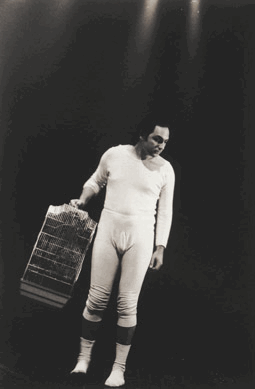
Jeff Stein, Cross Cuts, Performance Space, 2002
photos Heidrun Löhr
Jeff Stein, Cross Cuts, Performance Space, 2002
THE ATMOSPHERE AT HEIDRUN LÖHR’S SHOW AT CRITICAL PATH IS REVERENT, “ALMOST SPIRITUAL” SOMEONE SAYS. IT’S BEEN A WHILE SINCE I’VE ATTENDED AN EXHIBITION WHERE THE OPENING NIGHT AUDIENCE HAS TO BE PRISED AWAY FROM THE WORKS TO HELP THEMSELVES TO DRINKS.
Heidrun Löhr is acknowledged as the pre-eminent photographer to Sydney’s performance scene and tonight she invites us to see our shared history through her eyes. The vast expanses of the Drill Hall are moodily lit by projections. On hanging scrolls, 20 years of dance/performance history slips by in some 700 slides shown singly and in digital sequences. Her selection begins with Leisa Shelton’s The Girl Who Could See Air at the Toy Factory in Leichhardt (1989) and concludes with Running Behind Times (2009), a work she’s creating in collaboration with performer Rosie Dennis in the St James Railway tunnel. Four gently humming slide projectors are formally positioned on a line of plinths down the centre of the room. Composer Gail Priest’s delicate “Memory Machines” enhances the collective reverie.
In 2007 Heidrun Löhr received a two-year Australia Council for the Arts fellowship to catalogue and digitally transfer her photographic archive. Earlier this year, as the inaugural Artist in Residence at Critical Path she and director Margie Medlin hatched the idea of exhibiting an instalment from the archive representing an important part of the contemporary history of dance/performance in Sydney.
Equally surprised at the response to the installation Löhr modestly suggests, “A lot of the audience was also in the images so there were lots of personal memories and more collectively of the performance community…and the sound held it all together.” I ask how she decided on the installation format. “My archive is based on slides and negatives and film—analogue technology. Of course, I switched to digital some years ago, but it occurred to me it would be interesting to have both technologies together because the archive has changed enormously over the last few years as well. Also at that time Russell Emerson at the Department for Performance Studies told me he’d just got hold of 13 slide projectors that some other university department had thrown out. I thought, great, I’ll use those!”
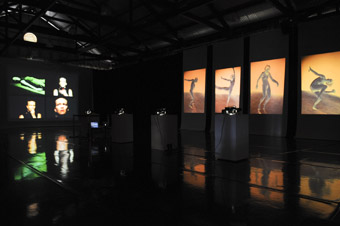
Fiona Malone, Ros Crisp in Projections, Heidrun Löhr
photo Heidrun Löhr
Fiona Malone, Ros Crisp in Projections, Heidrun Löhr
“I wanted to have the images not on the usual projection screens. The Drill Hall is so high and I thought it would be beautiful to have a scroll hanging down. Always the idea was to work with sequences and with single images. Gail came in and taped the sound of the projectors and we talked about nostalgia. The rhythm was important to me—the rhythm of the slide show and the rhythm of the sequences.”
Asked how she selected from so many possible images, Löhr replies, “I had a look at the Drill Hall and I thought I could do something incredibly small or very big. I decided on big. Big prints are expensive so I thought about projections, also because performance is a very ephemeral art. With projections you turn off the electricity and it’s all gone. So it somehow seemed appropriate. My choice was always based on movement. That was the focus that eventually held it together.
“For me it also has to do with performance photography. I don’t (simply) document so much as interpret a work. I decided to include a number of blurry images, the ones that aren’t usually printed or published, so a broader audience is not seeing them. As a photographer I’m working with light and the performers leave traces of light and the more they move the more traces there are. And, of course, I work with the lighting designer because I work with his or her light. Also I wanted to show more than one image of the work of one dancer or performer. For instance, you see Jeff Stein at Performance Space in Cleveland Street in 2002 and then again at Night Time in 2008 at CarriageWorks. In some of the sequences there’s just a small time lapse in between the development of a movement or gesture and sometimes the movement is quite ferocious.
“There’s a sequence of photographs from Force Majeure’s Already Elsewhere (2005) with the dancers on a roof. While I was photographing the dress run, I had the shutter open for quite a while. So you see the bodies travelling through space and time. They become quite abstract. There’s a certain beauty in it. Perhaps it’s also a desire on the part of the photographer to move away from reality. We always somehow need reality, not like a painter who can just make something up.”
Another spin-off from the Archive Project for Löhr is a developing interest in animation. “I’m working with Rosie Dennis and also with Nikki Heywood. Within 5 days, I took about 3000 images in the apartment where Nikki’s mother used to live until she had a number of falls and had to move into a nursing home” (see page 55).
We talk about the future of the Archive. “It was fantastic to have the fellowship. When I wrote the proposal, I was not aware how time consuming it would be. I’m working in collaboration with the Fisher Library and the Department for Performance Studies. Over those two years I have continuously gone through the proof sheets. I started with 2000 but then I went to 1990. Each year has five or six folders. In each folder there are approximately 100 films, 100 proof sheets, 35 images each. Between 1 and 6 will be good ones. I choose the images I think are interesting, ‘representing’ the work and then I write all the information. The problem has been finding someone to scan these images in because the archive will be digital. We’ve found someone in Adelaide who can do it but it’s quite expensive so the Fisher Library will need more funding. So I created this brochure on The Archive Project to go out to potential sponsors like Nikon—I’ve used a Nikon camera all my photographic life. I have about 500 images we will send to Adelaide and these 500 slides or digitalised negatives plus digital material will act as a trailer on the library’s website. All this will hopefully happen by the end of the year or early next year.” For the time being the archive is held at the Department for Performance Studies.
Heidrun Löhr’s archive is of great historical and educational importance, her striking images evidence of Löhr’s deep connection with the work she has lovingly photographed over the decades. Of course, she continues to do so as the pages of RealTime regularly attest. Its documentary function aside, the collection also represents a powerful body of work from a significant Australian artist.
Projections, The Archive Project Heidrun Löhr, Critical Path, The Drill Hall, Sydney, May 13-17
RealTime issue #92 Aug-Sept 2009 pg. 20
© Virginia Baxter; for permission to reproduce apply to realtime@realtimearts.net
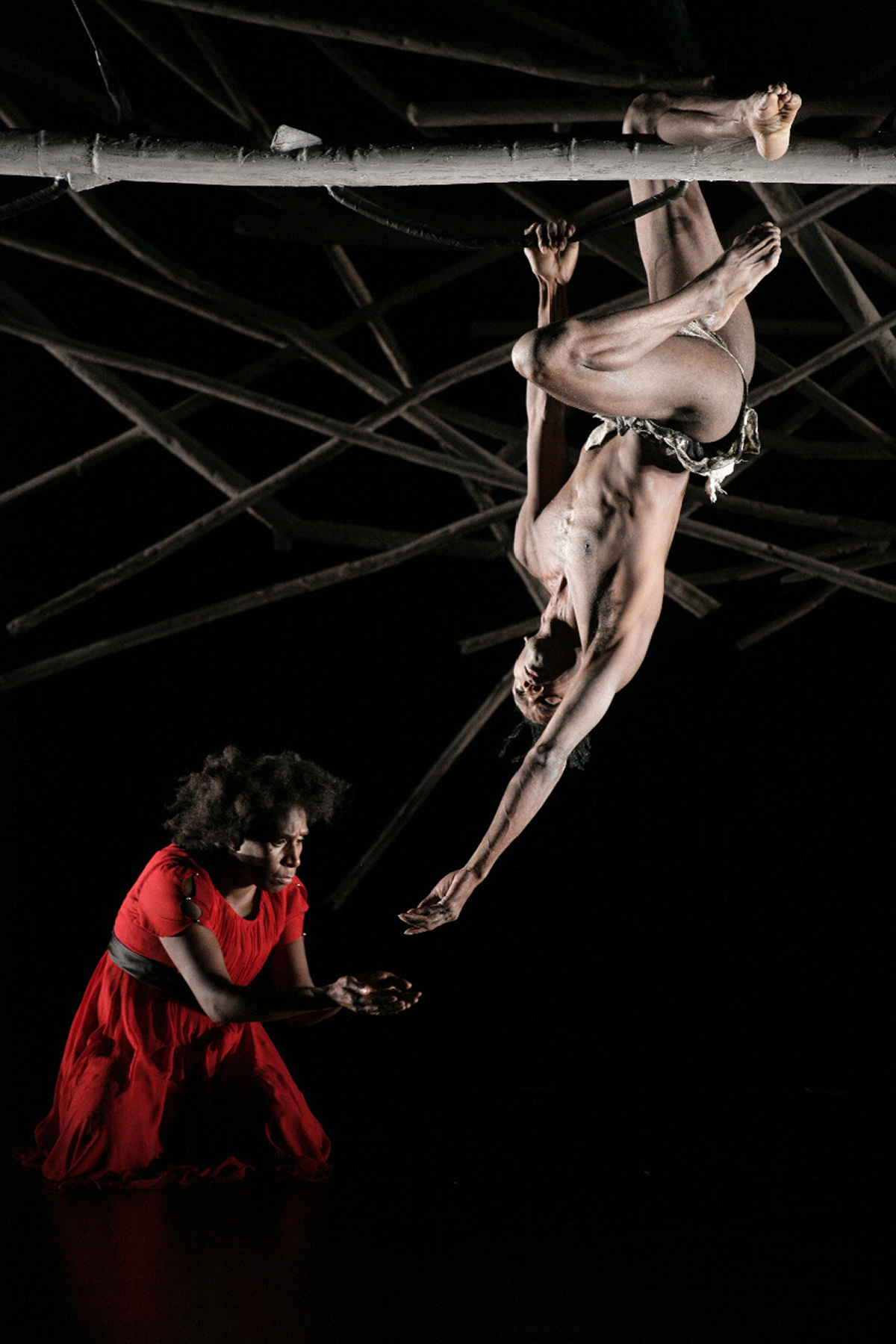
Elma Kris, Patrick Thaiday, Mathinna, Bangarra Dance Theatre
STEPHEN PAGE HAS BEEN ARTISTIC DIRECTOR OF THE 20-YEAR-OLD BANGARRA DANCE THEATRE SINCE HE WAS 25. “I CAN’T SAY IT’S BEEN A FLAWLESS 20 YEARS”, ADMITS A PHILOSOPHICAL PAGE. “BUT I THINK WE’VE PLAYED THE CARDS WE WERE DEALT PRETTY WELL. WE’VE BEEN HONEST PLAYERS; NEVER GOING INTO DEBT, FULFILLING OUR CORE FUNDING RESPONSIBILITY TO TAKE OUR DANCE INTO RURAL OR REMOTE COMMUNITIES AND OUR 20% FOR INTERNATIONAL TOURING.
“It’s overseas we regularly sell out 1,000 seat venues—and help to get the Australian Ballet into the Chatelet (in Paris)! But, back home, there’s no signage at The Wharf saying Bangarra Dance Theatre; it just says Sydney Theatre Company and Sydney Dance Company! Perhaps we’re a little too national for our cultural masters in NSW?”
The Stephen Page who’s just a little chunkier than he was as a kid from Brisbane, dancing with first the National Aboriginal and Islander Skills Development Association (NAISDA) then the SDC, may have “given up on his ego 10 years ago”, but he’s not given up on his feistiness.
Interestingly, 10 years ago Page was just about at the peak of his fame. He’d already done the Atlanta Olympics flag hand-over to Sydney with its memorably mad roos on bikes; he was poised to choreograph and co-direct the Awakening segment of the Sydney Olympics with “one thousand old myalls from the Desert” and Donny Woolagoodja’s amazing Wandjina rising from the earth; and he was about to be delivered the Artistic Directorship of the 2004 Adelaide Festival. And Bangarra was involved in all of them—you don’t get Stephen Page without his clan. It’s just a crying shame that we couldn’t have had that 2004 festival without the baggage left over from Peter Sellars’ chaotic 2002 festival. Page’s hands were tied. Which, in a sense they have been since birth. Page’s Aboriginality is both his total raison d’etre and a cross to bear. We talked far more about that than dance; dance is easy compared to “negotiating the cultural protocols between North and South—sharing all the mind-fuck stuff with the full-bloods and really digging into the wonderful complexity of Aboriginal culture. White people are always resisting that complexity—it’s so much easier to kill it off.”
“But it is an effort to maintain that complexity”, Page continued, “the protocols especially…things like whether Djakapurra (Munyarryun, the Yolgnu leader from Arnhemland who was cultural consultant to Bangarra for many years and went on to star in the Olympics Opening) could sing a healing song with no proper dance connection, with lights and with the wrong costumes. But working for the survival of our culture is what we have to do. And it’s worth it when a company like the Commonwealth Bank comes aboard as a sponsor of Bangarra to learn something about the protocols from us—dealing with cultural respect.”
Then came the old feist again: “I knew from Ochres I’d got it right.” Didn’t we all? I caught that breakthrough work during its initial five-day tryout showing in 1994 and raved: “(It) simply blew the socks off as it slipped so comfortably from the domestic to the mythic—and back again—making dancers invisible in the internalised intensity of their performance, then transforming Arnhemland’s chalky ochre shield against the evils of the night into ordinary urban make-up as they re-humanised” (Sydney Review, Nov, 1994).
Last year, Page must have continued to get it pretty right—his work, Mathinna about the young 19th Century Tasmanian Aboriginal girl, torn between two cultures as the Governor’s wife took her in, has just won Helpmann awards for Best Choreography, Best Dance Work as well as Best Original Dance Score.
How come Stephen Page himself isn’t just as torn between two cultures—torn and then spat out? It’s often reported that the “great robber in the making from the Bronx of South Brisbane” (his own words) turned his life around with a single visit to Yirrkala in Arnhemland—’discovering’ traditional Aboriginal culture in the hands of the Yunupingu, Marika and Munyarryun families. In fact, Page wants to make it clear that his full-blood father’s family from the Munaldjali clan of the Yugambeh tribe, once at Beaudesert—not to mention Nunukle cousins on his Mum’s side—often gathered for fishing, campfires and music, and, above all, stories. “They weren’t traditional myths”, admits Page, “but we found out where the landmarks were. They were rekindling what had been taken away—with nuances of the spiritual connections.”
“The politics came later.” Page was referring to his time at NAISDA, where the students all wore black, red and yellow headbands, went on many marches and pickets, and had lectures from Charlie Perkins, Gary Foley and the Bostocks. Even the dance was political in the hands of Black American modern dance-trained tutors like Carol Johnson and Cheryl Stone. “They were using art as a medicine, or an ingredient in their politics.”
But what Page calls his “solid roots” came from the North. “Philip Lanley from Mornington Island was the first Djakapurra—creating a melting pot out of an honest exchange of culture.” But the Yirrkala connection had started for Page even earlier, in 1984, and there’ve been four stays since. “We still send our young dancers to Dhalunbuy to knock some of the wonderful arrogance out of them. And we went to the Torres Strait recently—taking some of their stories back to them in dance. Afterwards, the old people cried, thanking us for hanging on to their stories so that their kids would want to inherit them.
“We’re a little satellite pod entrusted with their stories—taking them into the 21st century. That’s what matters—not the Kennedy Centre or the Chatelet. If we lose that circle of connection, we should close down and head for the sacred cave.”
The North/South connection doesn’t always work, of course. Several of the tutors simply “couldn’t hack” living in the city. And even such an assiduous worker on the protocols as Page finds himself “still discriminated against by the traditionals today—we’re not really Black enough for them. They see the stories being stolen from them. But I belong to the heritage of this land—it doesn’t matter that I’m not a full-blood. What matters is where I come down on the big debate today—is the Black perspective equally valid to the white one? Why was my old Dad—the best concreting man in South Brisbane—never given the chance or the money to develop his own business? He still thinks he has to work today to validate himself, and he’s 80.”
“And why is the Australia Council so hopeless with Indigenous art? It’s just a commodity for them—the Australian identity to wave like a flag overseas. But what is the essence of Oz without it? OK, membership of AMPAG (Australian Major Performing Art Group) has given us security and the potential to follow our own dreams. But it’s bloody challenging to make up all those business plans!”
Page would rather channel his energies into Fire, the retrospective work that tours the East coast August to November to celebrate the 20th anniversary of Bangarra (a word meaning “make fire”). “How do I pay homage to 100 dancers and more than 30 clan elders who’ve been our history?”, he wonders. None more so than his brother Russell—who, like David the composing brother actually preceded Stephen into Bangarra—but died at the height of his powers. “We can only show him on screen, sadly”, explained Page. “But we’ll have a Black Gala at the Opera House, and bring all the others back.”
“I need to use the celebrations to bring our people together”, he concluded. “Our politicians are just so exhausted living a schizophrenic life fighting white power. We need to get Black leaders together four times a year—we need to talk. Because Bangarra’s with AMPAG, for instance, I never talk to Lydia Miller (Director of Aboriginal & Torres Strait Islanders Board in the Australia Council). I don’t know why there are no sister dance companies for Bangarra across the country, no [sister theatre and music companies]?…Why doesn’t Aboriginal culture get more than multimedia? Why am I one of so few who are fortunate enough to be able to create in my own cave, with a stream of youngsters wanting to tell their own stories to me, now that I’m the elder?”
–
Bangarra Dance Theatre, Fire, Sydney Opera House, Aug 28-Sept 26; QPAC, Brisbane, Oct 7-10; Civic Theatre, Newcastle, Oct 30-31; Playhouse, Arts Centre, Melbourne, Nov 6-14; Canberra Theatre Centre, Nov 20-21
RealTime issue #92 Aug-Sept 2009 pg. 22
© Jeremy Eccles; for permission to reproduce apply to realtime@realtimearts.net
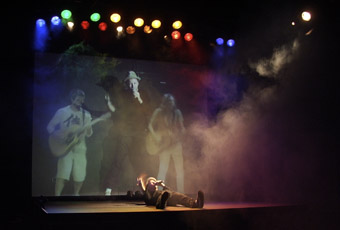
David Eastlake in Ben Knapton’s Gaijin
courtesy of the artist
David Eastlake in Ben Knapton’s Gaijin
NOW THAT I WORK IN A UNIVERSITY, I MIGHT BE TEMPTED TO DESCRIBE ARTIST-LECTURERS AS SOMETHING LIKE THE ANTS IN ESCHER’S MÖBIUS STRIP 11, MANY OF WHOM INDUSTRIOUSLY AND TENACIOUSLY FULFIL THEIR OBLIGATIONS TO BE OUTSTANDING PRACTITIONERS (IE RESEARCHERS), EXEMPLARY TEACHERS AND IMPECCABLE ADMINISTRATORS, WITH ANY SPARE TIME BEING FULLY INVESTED IN THE LIFE OF THE COMMUNITY.
In fact the relationship between the academy and the professional arts sector might well be understood in terms of overlapping spheres of influence and effect, a möbius strip or infinite surface without boundaries. Artists become lecturers and students become artists, who then become lecturers, not that that’s the only possibility of course, but it’s the one that I’m concerned with at present.
Of course artists who are lecturers are academics who get paid, and are therefore undeserving of sympathy. Students who are yet to be artists or lecturers have to pay, while artists who are neither students nor academics must find other means of survival. Either way, a lot of time goes into working in order to get the time—and the money—to work at either being an artist or becoming an artist, and if not an artist, a richly fulfilled contributing member of society with a deep appreciation for culture and the arts.
promise & reform
In education, as in the wider community, the election of the Labor Government has promised many, many things; not quite as much as promised by the election of Barack Obama—transfiguration is not on the agenda—but substantial change nonetheless. Key among the anticipated changes is the long anticipated ‘education revolution’, which according to the Minister for Education, Julia Gillard and Kim Carr, Minister for Innovation, Industry, Science and Research, promises “unprecedented reforms across the higher education and innovation sectors in response to the Bradley Review of Australian Higher Education and the Cutler Review of the National Innovation System.” While ‘reform’ may well be a word to strike terror into the hearts of those many academics who have spent the past decade or more engaged in apparently endless reform, restructure and reinvention, there seems no doubt that a revolution is underway, and as with all revolutions there will be winners and losers. Creative arts educators rarely expect to win (unless they work at NIDA), but with years of chronic advocacy and resource fatigue behind them, there is cautious optimism that gains may be made in this new era (sic).
the demand-driven model
If Group of Eight universities have slammed the Bradley Review as “a roadmap to mediocrity”, the view from other universities seems to be that the current government has indeed laid the foundation for a coherent education policy from early childhood onwards. UTS Sydney’s vice-chancellor Ross Milbourne was quoted as saying that the Bradley review was the best he had seen on the sector: “We need a great university system, not one or two great universities” (The Australian, Feb 18, 2009). What is truly unknown, however, is the impact and effect of the shift from a supply-driven model of education to one built on demand, meaning that from 2012 student enrolments will be uncapped, and students will have the right to vote with their feet. Esteem factors, proximity, flexibility, the calibre of course offerings and student experience will all play their part in this transformed educational landscape, as will the actual capacity (staffing, infrastructure, resources) of universities to respond to the potential enrolment explosion. The tension between quantity (numbers of student enrolments) and quality (the calibre of the teaching and learning experience) is unlikely to go away any time soon.
For practice-led creative arts courses, often precariously positioned within the university, it is difficult to imagine how this might play out. On the one hand, secondary students are typically conservative, with anxious parents understandably focused on vocational outcomes; but on the other hand, enrolments in university art schools across all disciplines have been steadily increasing in recent years, even if this does not match the exponential growth in media and communications areas. The shift to what’s described as a more “student centred system underpinned by a national regulatory and quality agency which will enable an extra 50,000 new students to commence a degree by 2013” (Senator, the Hon Kim Carr, Media Release, May 12, 2009) clearly indicates that the shift will be seismic. I would suggest, however, that for most artist-academics, the tension between teaching and learning on the one hand, and practice-led research on the other is likely to be exacerbated rather than eased. This may be less a matter of priorities within the universities themselves than the capacity of individuals to fulfil competing roles effectively, that is, without detriment to either their own research (art) practice and/or to those of their students. The quality question is indeed the elephant in the room, but that presumably is what the Excellence in Research for Australia (ERA) project is designed to address.
era challenges
The ERA scheme, initiated by the current Federal Government following on from the previous government’s Research Quality Framework (RQF), has foregrounded, yet again, key issues relating to the nature and calibre of research in the creative and performing arts within Australian universities. Concern around the status and recognition of the work of artist-academics as research has been fraught since the amalgamation of specialist arts training institutions into universities as part of the Dawkins Reforms of 1989. Ongoing and intense work by advocates within the creative arts higher education sector has seen that argument won—at least in rhetorical terms—within some but certainly not all universities and within the Australian Research Council (ARC). At a day-to-day level, however, as in the wider community, the research credentials of artist-academics may well be marginalised given competing priorities in areas such as medicine, the environment or technological innovation. And even now, it seems that art as the object of scholarly research, which is publication friendly in the traditional sense, is far better understood within the academy than research which is either ‘practice-based’ or ‘practice-led.’
So will ERA remedy these problems? The definition of research as used by the ARC, proposes research as “the creation of new knowledge and/or the use of existing knowledge in a new and creative way so as to generate new concepts, methodologies and understandings.” ERA indicator descriptors similarly state that, “This definition of research is consistent with the broad notion of research and experimental development (R&D) as comprising creative work undertaken on a systematic basis in order to increase the stock of knowledge, including knowledge of humanity, culture and society and the use of this stock of knowledge to devise applications.” For those artist-academics whose work reflects these research principles, this is no doubt welcome recognition, even if there is still a way to go before such understandings are implemented comprehensively throughout the university sector.
coded creativity
The ARC is currently conducting the first of the ERA trials with assessment of the Humanities and Creative Arts cluster being submitted in August with outcomes due in December. Universities everywhere are up to their eyeballs collating data in what one of my colleagues describes as the ‘Eternally Revolting Activity.’ As a consequence, all ‘research-active’ staff have been required to define their current areas of research using up to three Field of Research (FoR) Codes. For those of you unfamiliar with the fascinating details of this process, most creative arts activities come under FoR code 19. Within Division 19 there are six groups: 1901 Art Theory and Criticism; 1902 Film, Television and Digital Media; 1903 Journalism and Professional Writing; 1904 Performing Arts and Creative Writing; 1905 Visual Arts and Crafts; and then a big jump to 1999, which is “Other Studies in Creative Arts and Writing.”
In this context, it’s worth mentioning complementary initiatives undertaken from within the sector; in particular, an Australian Learning and Teaching Council (ALTC) funded initiative conducted in partnership between the Australian Council of University Art and Design Schools (ACUADS), the Victorian College of the Arts (VCA) and Sydney College of the Arts (SCA). “Future-proofing the creative arts in higher education: a scoping project for quality in creative arts research training” is headed up by Su Baker and Giselle Kett at VCA and Brad Buckley at Sydney College of the Arts. The project aims to survey the current state of doctoral programs in the creative arts in Australian universities and to investigate corresponding programs in a sample of overseas universities. Interestingly the study has already identified that models most compatible with the creative arts may in fact be more aligned to the experimental methods of the sciences than the interpretive and reflective approaches in the humanities.
So this tells us something of the brave new world that students who become artists who become lecturers have to look forward to. Conversely, those who choose to move away from the academy and support themselves as practitioners in the wider community may well be looking towards another new Federal Government initiative called ArtStart.
artstart
The new ArtStart—not to be confused with the NSW Government initiative of the same name for young people aged between 12 to 24 years—is designed to assist graduate artists including filmmakers up to 30 years of age make the transition from study to career. New funding of $9.6 million over four years suggests that this is a program the Government is taking very seriously indeed, particularly when you consider that it sits alongside another four year program also administered by the Australia Council called, “Opportunities for young and emerging artists” or OYEA—don’t you just love the acronyms?
OYEA is a government initiative that provides $6.6m over four years (2008-09 to 2010-11) to build the skills and experience of young and emerging artists through six pathways including creative residencies and commissions with major performing arts companies; artist-run initiatives; national mentoring programs, work placements for young producers; a bi-annual program of interdisciplinary mentored residencies in partnership with Byron Bay’s Splendour in the Grass Festival; and The Program, described as “an online, open arts community that provides a public-facing, social networking space for young audiences to engage with Australian arts.” A perhaps predictable add-on, given both the Australia Council Chairman and its CEO’s history with the organisation is a Young and Emerging Artist’s Award with the Australian Business and the Arts Foundation.
what kind of start?
You have to ask yourself how ArtStart will differentiate itself. It seems, talking to Australia Council staff, that the program is still very much a work in progress. It’s probably easiest to say what it’s not. It’s not another grant-giving scheme. It’s not about artists making new work. It’s not about subsidising their living costs. On the other hand it is about supporting them to buy the goods and services that they may need to establish their careers. It is about getting set up either to gain employment or to generate income. This could look something like the Run_Way scheme previously offered by the New Media Arts Board, which provided opportunities for artists and artsworkers to travel, learn and develop new skills, but it might equally support the hire of rehearsal and/or studio space, the purchase of essential equipment or allow someone to employ an accountant. One of the critical details yet to be nutted out is how to avoid ArtStart funding being counted as income and taxed accordingly. Neither funding nor industry bodies have had much success negotiating with the Australian Taxation Office over the years, so it will be interesting to see how that one pans out.
up to & after 30
It is extraordinary to think that amounts of $10,000 will be made available to around 200 artists a year, and while the question might reasonably be asked, is $10,000 sufficient to kickstart a career, anecdotally it does seem that graduating artists are more likely to continue as practitioners if they have the opportunity to make work during the first three years following their graduation. With around 16,000 creative arts students graduating annually, there is no doubt that mechanisms are needed if young and emerging artists and arts professionals are to go on to grow a robust and dynamic arts sector. It is fantastic that so many opportunities are being made available to young and emerging artists and it would be ungenerous to gripe. Nevertheless, you have to wonder what happens to artists when they turn 30, still a pretty young age for an artist. And what about all those hard working and tenacious mature to senior practitioners, whether working individually or collectively, who may have the time but not the money, or who have the money but not the time, and in what ways might our world be transformed if we were able to give more thought not simply to their financial survival but to their capacity to make art?
but is it a revolution?
There is no doubt that reform is essential. As the Bradley Review identifies: “Twenty years ago Australia was one of the first countries to restructure to enable wider participation in higher education. The results of those changes made it a leader internationally in the movement from elite to mass systems…There are now clear signs that the quality of the educational experience is declining; the established mechanisms for assuring quality nationally need updating; and student-to-staff ratios are unacceptably high.”
Australia is arguably not only reforming its higher education sector but reinventing itself through a welcome return to diversity and access for Indigenous people, people with low socio-economic status, and those from regional and remote areas. At the same time, initiatives such as ArtStart and OYEA are offering wonderful opportunities for young and emerging artists that should see many enabled to make the transition from university to professional practice.
What is not yet clear is whether Labor’s education revolution encompasses the creative arts in any meaningful way. We know that children who have access to arts education are uniquely advantaged, as a quick glance at any private school curriculum will tell you. A revolution would see all children and young people, no matter where they live, where they come from, and what school they attend, enabled to participate in an ongoing and systematic form of specialised arts training, understood as equally essential to their development as literacy, numeracy and sport. Should that prove to be the case, Australia might well achieve its education revolution, fulfill its social inclusion agenda, and change the world. Imagine that!
Image note: David Eastlake, Gaijin, photo courtesy of the artist. Writer QUT Creative Industries PhD student Ben Knapton, winner of the ADSA Philip Parsons Prize for outstanding Masters practice-led research, from which his performance work Gaijin emerged.
RealTime issue #92 Aug-Sept 2009 pg. 1
© Sarah Miller; for permission to reproduce apply to realtime@realtimearts.net
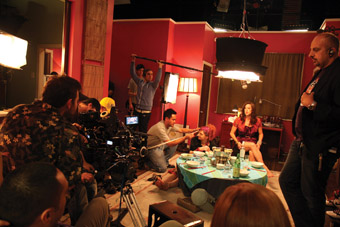
students from AFTRS and NIDA on the set of their co-production, One More Day
courtesy of Australian Film,TV and Radio School
students from AFTRS and NIDA on the set of their co-production, One More Day
IT’S WHAT COULD BE CALLED AN `INTERESTING’ TIME FOR THE LOCAL FILM INDUSTRY, WITH THE NEW PRODUCER OFFSET IN OPERATION AND SCREEN AUSTRALIA UP AND RUNNING. BUT HOW IT’S ALL GOING TO WORK AND WHAT IT’S GOING TO PRODUCE IS STILL TO BE REALISED. THIS PERIOD OF UNCERTAINTY IN THE LOCAL INDUSTRY IS REFLECTED IN THE FILM INDUSTRY AS A WHOLE, WHERE BIG CHANGES ARE BEING BROUGHT ABOUT BY TECHNOLOGY, THE GLOBAL FINANCIAL CRISIS, AND EVEN BY THE WAYS IN WHICH PEOPLE EXPERIENCE FILM.
It’s not surprising, then, that the screen production education sector is also experiencing a sense of change. At two conferences in July the topics centred on new methods of assessment, new terminologies, ways of using the new technologies and ways of working with the new ERA (Excellence in Research for Australia) regime for universities which credits academic staff for their creative output. The sector’s relationship with the industry, and the need to establish a better dialogue between the two, was also highlighted.
aspera: beyond the screen
Beyond the Screen, the 2009 conference of the Australian Screen Production Education and Research Association, held in Adelaide, is ASPERA’s annual forum for academics within the Australian screen production field to discuss shared issues and exchange ideas. As the outgoing president Leo Berkeley said, “since it began in 2004, the ASPERA Conference has had a major impact on the profile of screen production education…(bringing) into sharp focus the scale and significance of a discipline that had previously been receiving far too little attention.” With screen production programs now forming a major component of the tertiary creative arts sector, co-convenors Alison Wotherspoon and Jennifer Stokes talked about “the balance ASPERA strikes between industry, research, teaching and learning” and the opportunity it presents to look at the way “screen and media courses are multiplying and converging in many universities, the challenges we are facing as creative practice researchers, and the impact of the economic downturn on often fragile budgets.”
media arts congress
At the Media Arts Congress, held in Melbourne, a panel discussion was held to address the way in which practice-led researchers could have their creative works recognised under the new ERA regime. Senior Lecturer Alison Wotherspoon, from Flinders University, says that it seemed from the discussion that “finally everything was working towards an understanding of film as creative work, of practical outcome research.” However, she wonders whether such research “should be more aligned with the social sciences, where everyone is part of a team, and everyone’s name is on the project. Film, as a collaborative medium, would seem to fall more naturally into that alignment.”
assessing creativity
The problem of assessing image-based work, generally considered to be subjective and therefore difficult to measure and evaluate, is something that is being addressed by several projects, especially a large-scale one headed by Dr Josko Petkovic from Murdoch University, in which a team of researchers from five ASPERA institutions will test 45 short productions from 19 film schools. Currently, students in Australian film schools have a qualitative form of assessment; the aim is to “accumulate a body of evidence that will demonstrate in quantitative and qualitative terms that evaluation of creative works is as consistent as evaluation conducted in traditional discipline areas.”
Associate Professor Gill Leahy from UTS (University of Technology, Sydney), in her paper at the Media Arts Congress, argued that it’s possible to establish guidelines for assessing screen production works, group work, peer review standards, festival and publication standards, that equate with more conventional scholarly output. She compared and contrasted criteria used to assess creative work at four universities in a preliminary study, working towards a model for criteria for the assessment of screen-based work.
As Alison Wotherspoon says, “there is a need to establish criteria by which to evaluate film—it needs to have some sort of peer review process. Where written work has publication in peer-reviewed journals, film could use acceptance by festivals, events, awards. But such criteria need to be quantified, to establish the standard expected for an MA, or a PhD.”
The relationship between the screen production education sector and the industry is one that needs to improve. Wotherspoon, as newly elected president of ASPERA, argues that universities could play a larger role, especially in connection to research in an industry that is seen as statistics rich but research poor. She says that ASPERA believes there should be a role for universities in industry research; with18 universities teaching screen-related courses, they could identify issues relevant to the industry, and students could approach them as graduate projects.
As Wotherspoon says, “it’s interesting that research in the film industry into relevant areas seems to be lacking; TV has got its act much more together, especially about audience research and about what the audience wants.” (Screen Australia has just announced details of its marketing support to the industry, but there doesn’t seem to be any research planned into audience and, especially, into the disconnect between Australian audiences and Australian films.)
skills shortage
Gill Leahy comments that Richard Harris, CEO of the South Australian Film Corporation, said at the ASPERA conference that what the industry really needs is first assistant directors and continuity and make-up people, and that universities are not supplying them. She believes that what are really needed are mentorships and attachments to such specific areas. “They could work very well, as the students would be insured by their university while they are still students, which could allay some costs.”
Alison Wotherspoon agrees. As she says, “the industry wants people who’ve been trained, but there’s no money in training, and the organisations that used to train large numbers of young people—the ABC, Film Australia—don’t do so any more. But if universities and the industry developed a more integrated relationship, part of an honours year could be an internship, whereby the student could learn the craft, and the university would cover the insurance. We need to have conversations about these possibilities, get recognition from the industry that this would be a sensible and mutually rewarding development. It’s understandable that people are still threatened by the idea of free labour (although the industry has always operated with a system of attachments and learning-on-the-job placements), but the industry has an ageing workforce; this is an issue that has to be addressed.”
the phd feature film
While students in screen production courses have always made short films in various formats, the production of feature films is a new and emerging trend. Flinders University has a practice-led low budget feature being made by three PhD students. The project addresses a number of different research questions about writing, financing and how such a project would work in the university environment, and the making of the film will contribute towards the doctorates. The three main people involved are working as writer, director and producer, and each has a separate area of research, while a number of undergraduates who work on the project will also be credited. As Wotherspoon explains, “this model has the potential to develop into a PhD program, using different mixes of participants.” As she says,”universities provide great models for student creative collaboration; at university you can try something and fail, and what you learn from that is important, you learn to make something better. But that failure is not exposed to public scrutiny.”
new formats, new audiences
However, Wotherspoon doesn’t agree that emphasis should only be on feature films. She argues that, “there is a greater need for screen content than ever before, but it covers a wide range of content style, use and format. Theatrical release might still be the jewel in the crown, but there’s an ever-increasing, younger audience which has a very different relationship with the screen, and what they want is woefully under-researched and little known.”
Wotherspoon also argues for the importance of the craft of making educational and training documentaries, which are actually more in demand in the new world of online education. “If a short film on an issue fills a need, it can go on being used for a long time, and can eventually be seen by far more people than a feature film”, she says.
aftrs transformed
The Australian Film, TV and Radio School is well into the first year of the dramatically changed course structure that accompanied the school’s move to Fox Studios. AFTRS Director of Screen Content Graham Thorburn says that the changes have really transformed AFTRS, “the energy and activity is amazing.” He reports that students are currently making a feature film [pictured above]; “81 students volunteered, it was shot in their four-week break (on the RED camera) and is currently being edited, with an October 26 screening planned. All NIDA’s graduating students have a speaking part (and that was a challenge!), and it is made up of four stories with an overarching connection.”
AFTRS is including in production and small business courses its analysis of the producer offset and how it works. “We see the division in the industry becoming more pronounced, with high budget productions, often with some overseas money, using a Hollywood style production method, and a low budget, very local production style. So we’re trying to teach how to make compelling stuff for less money”, Graham Thorburn says, adding that AFTRS should exist alongside and complement industry experience.
“We’re concentrating on story, without ignoring AFTRS’ traditional contribution to technical excellence. Our focus is on finding and developing great screen storytellers. The writing course restructure (divided into intermediate level and advanced) has made it more accessible to people with life experience, and this year’s intake included a number of people with existing credits as novelists or journalists, who already could write.” That’s for the intermediate program, which is six-months part-time taking place in Sydney, Brisbane and Melbourne. “The idea is for them, when they’ve finished the intermediate level, to go off and do some work, and come back when they’re ready to enter the advanced level.”
AFTRS is about to appoint a national director for its Open Program. Graham Thorburn says, “we want the courses to satisfy the demands we know are out there, demands from both television and film, for the specific skills that are needed. We’re hoping that some courses will start later this year all around the country, but there will be a big summer school in Sydney.” AFTRS new foundation diploma is at more of an entry level, and has 52 students this year, probably 100 next year. “It’s constructed around intense two week workshops—before you’re ready to decide what specific role you want to follow— and it’s not discipline based but provides a focused look at specific aspects of filmmaking—things like story and audience, character, script and performance, juxtaposition and rhythm, distilling the essence of ideas.”
Thorburn adds, “We’ve been approached by some universities to discuss the possibilities of students doing the AFTRS foundation diploma and then going into the second year of a related university course. Otherwise, we anticipate our foundation diploma graduates will go off and work in the industry, and come back to AFTRS when they’re ready to specialise.”
the future: symbiosis
Clearly, with the impact of ERA, the growth of creative post-graduate and film school student feature filmmaking alongside work in new formats, there is potentially a richer interplay between the tertiary education sector and the film industry. It will require discussion, negotiation and, within universities, a realistic approach to the complexities of peer review of creative output.
RealTime issue #92 Aug-Sept 2009 pg. 23
© Tina Kaufman; for permission to reproduce apply to realtime@realtimearts.net
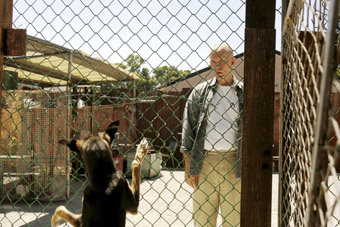
John Malkovich, Disgrace
JM COETZEE’S 1999 BOOKER-WINNING NOVEL DISGRACE HAS, LIKE MOST OF HIS WRITINGS AND LECTURES (READERS TEND TO HAVE A LOVE/HATE RELATIONSHIP WITH THE WRITER), DIVIDED AUDIENCES WITH ITS PORTRAYAL OF A BITTER, AGEING ACADEMIC, DAVID LURIE, FORCED TO RESIGN AFTER AN AFFAIR WITH A STUDENT. RUNNING FROM CAPE TOWN IN THE HOPE OF WRITING AN OPERA ON BYRON (RATHER THAN OUT OF ANY FEELING OF WRONG-DOING; THE DISGRACE COMES LATER), LURIE VISITS HIS DAUGHTER LUCY, LIVING ON AN ISOLATED FARM, AND EXPERIENCES THE DEVASTATING EFFECTS OF AN ATTACK BY THREE LOCAL MEN WHO RAPE HER, BEFORE SETTING HIM ALIGHT WITH METHYLATED SPIRITS. IT’S A WORLD WHERE WHITE SOUTH AFRICANS ARE THE OUTSIDERS LOOKING IN, DEPICTED AS ‘OTHER’, ALMOST A PLAGUE ON THE LANDSCAPE.
Director Steve Jacobs and writer-producer Anna Maria Monticelli acquired the book rights early on and the resulting film, shot on location in South Africa, is beautifully adapted and directed, restrained and subtle (after the same team’s vivacious La Spagnola) with Malkovich given the difficult task of bringing his masked character to cinematic life—without the help of a voiceover. From the opening scene I was worried about the casting. We always seemed to be approaching Malkovich from behind. As he peered out through vertical blinds in his bourgeois apartment or delivered lectures on Byron to zoned-out students, the camera was placed as if hiding from him, zooming in on the back of his head. All I could think about was Being John Malkovich, where the characters took the funpark ride of a lifetime into the portal of Malkovich’s brain. While Spike Jonze and Charlie Kaufman’s film remains a favourite, it has almost spoiled forever any power Malkovich had over me as an actor—that effete voice, the soft lisp, the limp walk. And here, Malkovich at first appears to be being-John-Malkovich-being-David-Lurie, but as we both warm up he inhabits Professor Lurie and almost makes him sympathetic—easier without the novel’s access to the inner-workings of Lurie’s bleak-mindedness (there’s a portal I wouldn’t want entry into).
He remembers Melanie, on the first evening of their closer acquaintance, sitting beside him on the sofa drinking the coffee with the shot-glass of whisky in it that was intended to—the word comes up reluctantly—lubricate her.
Lecherous academics have become clichés in literature and film. They usually have beards, wear tweed and read Wordsworth (cue opera music in background) and Coetzee pleads guilty in some aspects to the lecturer-as-pretentious-wanker label. Isabel Coixet’s Elegy (also based on a novel, by Philip Roth), released earlier this year and starring Ben Kingsley and Penélope Cruz, broke the mould, exploring the dynamics of such a relationship with finesse and empathy for both points of view. In Disgrace, things are more clumsy, both on the page and on screen. Lurie’s motivation for the affair with his student, Melanie, is unclear beyond the obvious; she’s young and beautiful. But as they make love she’s portrayed as unyielding, stiff; there’s no sense that she’s a willing participant. And perhaps, what Lurie doesn’t want to articulate, is that this conquest is the first step along the path to a self-destruction he craves anyway. The later scene where he meets Melanie’s younger sister (and we’re talking young here), Desiree, has an undercurrent of unease with his lascivious longings bordering on paedophilia. While he’s apparently visiting the family to apologise and gain some sort of redemption, in the book at least it’s clear that meeting this young girl carries for him a real erotic charge.
This recycling of power within relationships—given, taken away, renegotiated—is beautifully paralleled in Lucy’s story (a sharp performance by newcomer Jessica Haines who outmanoeuvres Malkovich in her film debut). While Lurie is misogynistic in tone when describing women in the book, his expression of love for his daughter is different. When she is raped (and, in the end, pregnant) by local men—one of whom Lurie soon discovers is a neighbour—he struggles to understand how she can remain working on her farm, alone, and bear a child springing from such deep hatred. It’s difficult for the audience to witness too, as it stems from a complex argument about race and responsibility in post-Apartheid South Africa. Perhaps you need to have lived there to fully comprehend it, but Haines’ performance has a robustness that suggests some hope for her and an acceptance of her plot (the one she tends in darkness so she can sell flowers at the market).
He would not mind hearing Petrus’ story one day. But preferably not reduced to English. More and more he is convinced that English is an unfit medium for the truth of South Africa. Stretches of English code whole sentences long have thickened, lost their articulations, their articulateness, their articulatedness. Like a dinosaur expiring and settling in the mud, the language has stiffened.
For Lurie, who specialises in language as a scholar of Romantic poetry, the prosaic words of Lucy and Petrus (Eriq Ebouaney) continue to evade him. Petrus is probably the novel’s most intriguing character; in the film he’s evened out by Ebouaney’s performance, a calm soul. A local who has helped build Lucy’s farm and tend her dogs, he’s now working on his own patch, but also claims one of the boys who raped her as family and refuses to turn him over to police or accept responsibility. Each conversation between Lurie and Petrus reveals a gulf of philosophy; there’s no bridge here. Petrus accepts absolutely what is; Lurie is always positioned in the future, wanting things to change and adapt. Lucy manages to straddle the distance between them but her position seems the most tenuous as we near the end: bitterly tragic in the book; with an uplifting edge in the film.
With Samson and Delilah, Last Ride, My Year Without Sex, Mary and Max, and now Disgrace, it’s been a strong year for Australian features. Coming up is another literary adaptation, Bruce Beresford’s, Mao’s Last Dancer along with Bob Connolly’s political thriller Balibo and Ana Kokkinos’ Blessed. It looks like the AFI Awards this year are hotting up to be a real competition, with more than one serious contender vying for the prizes.
Disgrace was one of three Australian films in competition at Sydney Film Festival and is screening nationally. The film won the US $200,000 Black Pearl prize for best narrative film at the 2008 Middle East International Film Festival (MEIFF) in Abu Dhabi, the US $18,000 New Talent Competition at the Taipei Film Festival and the Prize of the International Critics (FIPRESCI Prize) for Special Presentations at the 2008 Toronto International Film Festival.
Disgrace, adapted from the novel by JM Coetzee, director, producer Steve Jacobs, screenplay, producer Anna Maria Monticelli, producer Emile Sherman, cinematography Steve Arnold, editor Alexandre de Franceschi, original music Antony Partos
RealTime issue #92 Aug-Sept 2009 pg. 24
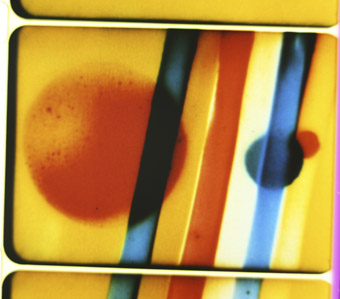
film still from Colour Flight, 1938, Len Lye
courtesy of the Len Lye Foundation, the Govett-Brewster Gallery and the New Zealand Film Archive
film still from Colour Flight, 1938, Len Lye
THE AUSTRALIAN CENTRE FOR THE MOVING IMAGE’S NEW LEN LYE SHOW IS FRAMED—IN MORE WAYS THAN ONE—BY AN INSTALLATION RADIATING COLOURED LIGHT OVER THE ENTRANCE TO GALLERY 1. AN ENLARGED PANEL OF ILLUMINATED HAND-WORKED FILM, ITS DAZZLING DOTS AND DYNAMIC DIAGONALS ARE A PORTENT OF THE UR-FORMS CRISS-CROSSING THIS EXHIBITION, AND A PERFECT SYMBOL OF THE ARTIST’S LIFE-LONG QUEST TO “FIGURE MOTION.” THE CAREFUL PLACEMENT AT THE START OF THE VIEWER’S JOURNEY INDICATES THE THOUGHTFULNESS THAT HAS GONE INTO THE CURATION OF THIS SHOW, AND THE VISITOR’S CONSEQUENTLY RICH EXPERIENCE.
Assembled by senior ACMI curator Alessio Cavallaro and Tyler Cann of the Govett-Brewster Gallery and Len Lye Foundation the exhibition offers an unprecedented opportunity to experience this New Zealand-born artist’s remarkable oeuvre, which spans hand-made and ‘scratch’ filmmaking; animation, documentary and advertising films, painting, drawing, textiles, photography, poetry, and, spectacularly, kinetic sculpture.
Experience is a key word here: the visitor, guided on a tour through the mind of one of the 20th century’s greatest artists, is distinctly encouraged to respond to these works, aesthetically and intellectually, but also physically and intuitively. Across time and through a variety of media, the journey revisits key thematic refrains of figuring motion; Lye’s personal theories of “individual happiness now”; and stylised formal archetypes emanating from what he called the primitive “old brain.”
After passing the multi-coloured frame enlargement, the visitor enters the gallery’s first space, housing drawings, the artist’s famous ‘doodles’ and paintings. Not only are these confident works exceptionally well-preserved, they are arranged throughout the space so as to subtly guide the viewer from the artist’s early sketches, across the tools and other illuminating biographical ephemera, through batiks and paintings which, in turn, give way to the ‘sculpture garden’, featuring some of Lye’s most renowned kinetic sculptures. Three of these—Rotating Harmonic (1959), Zebra (1965) and Moon Bead (1968)—have been especially reconstructed for this major retrospective. Well-behaved (on my visits), a 16mm film projector runs film on a loop, bathing the inner space in golden flicker and underscoring the whole experience with another low, mechanical hum. Our eyes are led to Lye’s photograms (camera-less photographs created by directly placing materials onto film and exposing them) to his animation and advertising films, and back around through the sculpture garden’s spindly structures, until we finally come to the dark cave at the end housing the digitally-beamed scratch films.
The sculpture garden is a beautifully low-lit forest of gently swaying steel stems, sighing and whirring and reverberating, sprouting and shivering. A constant, complex strobe is created by the motion of these “tangibles”, as Lye called them, which carve the exhibition space up into the radial, fanning and spiralling shapes so characteristic of his work. Visible from most parts of the exhibition, and frankly amazing when you’re inside it, this weird womb is also the exhibition’s heart, and in some ways its brain centre, as it’s here that the show’s truly show-stopping magic happens. Motorised sculptures embark on performances at regular intervals (Lye had a very keen sense of the duration of his kinetic art). Huge but gentle, with stainless-steel rods fitted tightly into a socket like stems in a flower vase, a fountain of metal rods unfurls overhead like an enormous space-age bouquet. On one visit, I observe a group of adolescents stumble backward from Fountain III’s (1976) towering arms to get a better view, their expressions rapt, faces striped with intermittent light (I am amazed that they appear to be guardian-less, suggesting that a group of boisterous teenage boys came of their own accord to see a modern art show, but then again, this is Melbourne, and more importantly, this is Len Lye).
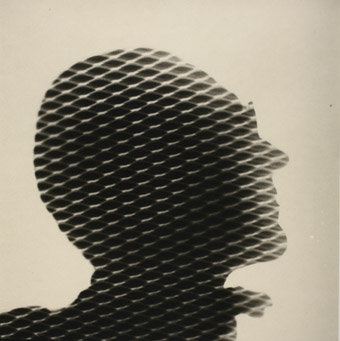
photogram, Le Corbusier, 1947, Len Lye
courtesy of the Len Lye Foundation and the Govett-Brewster Art Gallery
photogram, Le Corbusier, 1947, Len Lye
In contrast to the Fountain’s gentle swathes, Blade (1959-1976) begins as a cork ball on a springy stem setting up a light, rhythmic tapping on a length of steel. Not unlike a rectangular saw, Blade’s ‘receiving’ element begins to wobble, at first gently, then with increasing violence and sonority. As the pounding becomes more urgent, the blade buckles, complains and resonates, setting up a deep wave that ricochets throughout the room and seems to pass through my sternum each time. As the sculpture’s motions become more frenzied, and the blade is bent forward by progressively more explosive thrusts, I can’t help sneaking a peek at the transfixed teens to see if they are clued into this evidently erotic undulation. (Yes, they are). Their blushing sniggers are soon joined by the knowing chortles and outright belly laughs of other patrons. At the culmination of Blade’s performance, as ball and blade slowly return to resting state, there is one of those precious group moments that sometimes happens in the temporary community of an art gallery, as everyone simultaneously lets out an embarrassed cough and disperses abruptly. Fortunately, there’s a nearby escape into the sanctity of the scratch films in the screening room.
With Lye’s handmade films, the eyes are bombarded with “waves, stripes, blobs of violent tints, suggesting tartan, bandanna, boarding house wallpaper, fruit salad, chromatic spaghetti and an explosion in a cocktail bar” (as a reviewer in London’s Daily Mail said on the release in 1935 of A Colour Box). While the film work remains as mesmerising as ever, for many visitors who may be familiar with this, the show’s real enchantment is the way those same formal concerns are expressed across different materials and media. Lye’s practice is rigorously, even obsessively consistent: the same sensual, swirling, fraying, spraying, spreading shapes recur in paint, stencilled or incised onto film, doodled over paper, and given breathtaking mechanical form in the tangibles. The curators’ careful selection and juxtaposition of Lye’s work in the show establishes a sympathetic space for conversation between these works, enabling viewers to draw their own connections between his forms, obsessions and commanding achievements.
Biographer Roger Horrocks’ informative lecture highlights Lye’s artistic interest in notions of empathy, making it especially obvious that the ACMI exhibition too revolves around this concern with, and also within, Lye’s multiform practice. Cavallaro modestly agrees that “as curators, we spent time trying to really empathise with his work, thinking about ways to hopefully yield the most sympathetic resonance with the viewer.
“This was a somewhat tricky thing to do as, of course, Lye worked across so many mediums, and there was such a range of expression. So we thought what we would do was to try to present the work as sections, each self-contained, yet interrelated with others and able to be experienced in an integrated way. We could really ‘open up’ the work, and reveal his approaches and, invariably, connections between mediums. To do so in a way that is not didactic, more in a way that enables the visitor to experience this work on a more intimate and more personal scale, was our challenge.”
The question of the appropriate empathetic arrangement of the array of materials preoccupied much of the curators’ time in the exhibition’s planning. Tyler Cann first encountered Lye as a young art student under the influential modern art historian-critic, Yves Alain Bois, whose promotion of Lye opened the young scholar’s eyes to kinetic art developments beyond the Euro-American sphere. Cavallaro was first exposed to Lye’s work through the extraordinary scratch films, marvelling at their dynamic synchronisation and, he says, “totally captivated by their elegant simplicity; the less is more approach.”
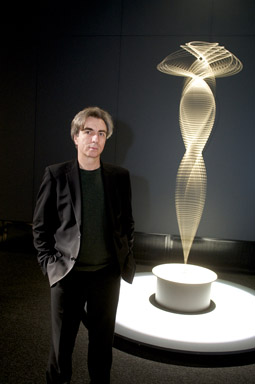
Alessio Cavallaro with Len Lye’s Zebra, 1965
photo Nolan Bradbury
Alessio Cavallaro with Len Lye’s Zebra, 1965
When I ask if he was tempted to foreground the films more, he agrees that the films are “bewitchingly beautiful” and that ACMI “could have zoomed in on that aspect alone, and it would have been fascinating—there are easily enough films by Lye that could fill Gallery 1.” However, as Cavallaro puts it, “Lye’s such a polymath, such a multimedia artist, such an artist of the 21st century—in other words, very much a contemporary artist, exploring a range of media—that the show wouldn’t have done him justice as an artist if just focused on the films.”
In particular, Cavallaro says, there was a pressing need to explore “Lye’s motion ideas with great intensity: how he applied them, how he experimented with them, and ultimately how he presented his notions of composing with motion.” To do this meant an emphasis on the “obvious connections between one medium and another, direct connections between all the work, cross currents and cross energies reverberating throughout the space. That’s one reason why we have the scratch films at the end of the journey.”
The beat of African drums from the seminal, much-loved Free Radicals (1958) is deliberately allowed to seep through and affect—or more correctly, infect—the gallery space with its urgent, primal rhythms. Len Lye would have loved this, I’m sure; he said he wanted to ensure that “the shoulder blades and thigh sinews of the gallery-goer got the resonant message” his work communicates. On seeing these “white ziggle-zag-splutter scratches on black 16mm film…in quite doodling fashion” (Lye), the visitor, everywhere constantly reminded of the kineticism of the human body, is virtually impelled to move (fortunately there is lots of space in the screening room!). This little cinema provides a dedicated space for the absorbed contemplation of these works, a fitting conclusion to the exhibition’s dazzling trip through the artist’s life and work.
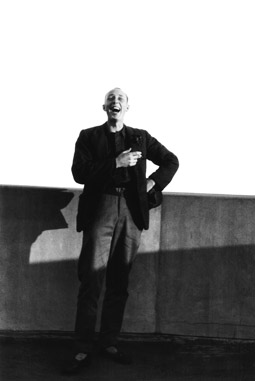
Len Lye in Sydney
photo Mary Brown. Image courtesy of the Len Lye Foundation and Govett-Brewster Art Gallery
Len Lye in Sydney
“As you leave the exhibit”, Cavallaro advises, “as you’re going up the escalator to exit, look back over your shoulder at the show and see what that different view does for you.” I did, as others should, for the ultimate conclusion to the journey: as you ascend and the show recedes, the birds-eye view reveals the topography of an amazing little universe—a kaleidoscopic Lye-land—pulsing and dancing and in a mosaic of swaying steel, light and sound.
ACMI, Len Lye, curators Alessio Cavallaro, Tyler Cann, presented by the Australian Centre for the Moving Image in collaboration with the Govett-Brewster Art Gallery (New Plymouth, New Zealand), and with the support of The Len Lye Foundation and the New Zealand Film Archive; ACMI, Melbourne, July 16-Oct 11; www.acmi.net.au/len_lye.aspx
RealTime issue #92 Aug-Sept 2009 pg. 26
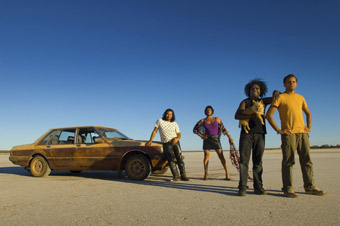
Stone Bros
THERE’S SOMETHING ODDLY FAMILIAR ABOUT RICHARD J FRANKLAND’S FEATURE FILM, STONE BROS. IT HIT ME AFTER THE SCREENING. IT’S PRISCILLA, QUEEN OF THE DESERT, BUT IN ANOTHER UNIVERSE. IN PRISCILLA, A TRIO OF TRANSVESTITES HITS THE ROAD, LEAVING THE CITY FOR AN ALIEN LAND, CENTRAL AUSTRALIA, WHERE, WITH VARYING DEGREES OF SUCCESS, THEY REDISCOVER THEMSELVES. IN STONE BROS, THE WELL-MANNERED EDDIE TOO LEAVES A FRUSTRATING CITY WITH HIS ANARCHIC COUSIN CHARLIE, BUT HEADING TO “COUNTRY”, HOPING TOO TO CONFIRM A SENSE OF SELF.
This might seem the inverse of Priscilla’s journey, but Eddie is likewise carrying a burden—he looks too much like a “whitefella” and is desperate to confirm his identity. Not only that, Charlie has sold Eddie’s jacket, thereby losing a sacred stone held in trust which Eddie must now regain on a journey beset by misadventure and some very strange encounters.
Frequently on the trip people are not what they first seem or are in states of transformation. A hitchhiking, rock guitarist turns out not to be exotic Italian but plain Ozzie; a depressed drag queen (Bangarra Dance Theatre composer David Page) is revealed to be a cousin; a wedding host turns out to be Mary G (Mark Bin Bakar); a prison officer (Peter Phelps) reads bad anthropology and transforms into a naked New Age Man; and a cute little dog becomes a wild-eyed monster, kin to the killer rabbit in Monty Python and the Holy Grail but, in the end, nicer. Even the stone turns out to have a purpose more pragmatic than spiritual. And then there are lessons in fidelity and controlling anger and learning to love.
Writer, activist and performer Richard J Frankland’s film credits include the award-winning documentary Who Killed Malcolm Smith (1993) and the intense short drama No Way To Forget (1996), based on the filmmaker’s experience as a field officer with the Royal Commission into Aboriginal Deaths in Custody. No Way To Forget was selected for Un Certain Regard in the 1996 Cannes Film festival and won the AFI Award for Best Short Film. Another award winner was his moving short drama, Harry’s War (1999), about an Aboriginal soldier killed in Word War II.
Frankland’s tautly constructed short films don’t prepare you for Stone Bros, a laidback stoner road movie with bursts of farcical energy, angst both comic and serious, sentimentality and high drama, a few too many B-grade jokes and more themes than you can point a stick at. Finely photographed by Joe Pickering across a range of landscapes and graced with a huge variety of acting styles (Luke Carroll’s Eddie provides a well crafted centre), Stone Bros barely coheres at times. But as a welcome antidote to the morose Priscilla and a more pertinent account of Indigenous culture, and not least as an all too rare Aboriginal screen comedy, it’s fascinatingly original when not downright irritating. Stone Bros could achieve cult favour but, better, it might set a precedent, encouraging more comic visions of this country’s complex cultural realities.
Stone Bros, writer, director Richard J Frankland, actors Luke Carroll, Leon Burchill, David Page, Valentino del Toro, Peter Phelps, director of photography Joe Pickering, production designer Sam Hobbs, editor Meredith Watson Jeffery, music Shane O’Mara, producers Ross Hutchens, Colin South, Media World Pictures, distributor Australian Film Syndicate; www.stonebrosmovie.com.au
RealTime issue #92 Aug-Sept 2009 pg. 28
© Keith Gallasch; for permission to reproduce apply to realtime@realtimearts.net
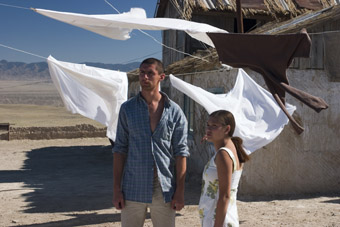
Wild Field
PLAYING IN ALL MAINLAND STATE CAPITALS FROM MID-AUGUST THROUGH TO SEPTEMBER, THE 2009 RUSSIAN RESURRECTION FILM FESTIVAL BRINGS A VERY MIXED BAG OF RUSSIAN CINEMATIC TREATS TO OUR SHORES. TYPICALLY OBSCURE METAPHYSICAL DRAMAS LINE UP ALONGSIDE A BRASH AMERICAN STYLE NAVAL BLOCKBUSTER WHILE SUBVERSIVE BLACK COMEDIES SHARE THE FLOOR WITH (WAIT FOR IT) A RAUNCHY TEEN MUSICAL. ALWAYS KEEN TO KEEP AN EYE ON THE DIVERSE AND RAPIDLY CHANGING TRENDS IN RUSSIAN CINEMA, I WAS PRIVILEGED TO GET AN EARLY GLIMPSE OF THIS YEAR’S SELECTION.
wild field (dikoe pole, 2008)
No doubt the artistic draw card of this year’s festival is Wild Field, a quiet, unusual and very beautiful film directed by Mikheil Kalatozishvili. Forever introduced as the grandson of celebrated Soviet director Mikhail Kalatozov (director of the 1958 masterpiece The Cranes are Flying), Kalatozishvili is himself an accomplished and very talented filmmaker, and in Wild Field he has made his first significant critical success. Scrupulously based on a script written by the late Aleksei Samoriadov and Petr Lutsik, the film presents a gentle and fleeting metaphor of the contemporary Russian dilemma: which road to take after communism.
Set in and around a medical outpost in the endless Kazakh steppe, Wild Field presents a miscellaneous band of post-Soviet yokels and their health problems as seen through the eyes of regional doctor Dmitri Morozov (Oleg Dolin). Dmitri, known as Mitia, is a peaceful man himself, content to tend to the needs of his clinic and make do with a far from ideal situation. But for a GP the problems of others are never far away and though he does his best to keep things in order, Mitia inevitably finds his life upturned by forces beyond his control.
An intangible film, like dust through the fingers, Wild Field has a light but also curiously haunting resonance. With an elegant flow of images (wonderfully shot by Petr Dukhovskoi) Kalatozishvili carries the audience along, gently, into the dreamlike intimacy of Mitia’s life and the surreal vastness of the Kazakh steppe. From its opening shot Wild Field teeters, like a many great Russian lyrical films, between realism and dream in the fields of parable and metaphor. Some reviewers have described the film as a work of ‘magic realism’ (like a Marquez novel displaced into the epic landscapes of Asiatic Russia) and this is perhaps a useful comparison. As with many Russian films of the past 50 years, Wild Field seems to be trying to negotiate with the troubled nation’s past through a filter of imagination, dream and fantasy, in an attempt, perhaps, to reclaim it. Though certainly less demanding than last year’s masterpiece, The Banishment, Wild Field is an obscure political-metaphysical gem that should not be missed by anyone interested in new Russian cinema. It has received a host of international awards, including Best Film at Portugal’s Estoril Festival, the Art Cinema Award at Venice and the Critics Award at Kinotavr.
morphine (morfiy, 2008)
Coincidentally, Wild Field isn’t the only “doctor in the Russian wilderness” story to feature at this year’s festival. There’s also Morphine, a subversive black comedy that makes you wonder just how much more great material is out there. Directed by Alexei Balabanov (cult director of Brother [Brat, 1997]), Morphine is based on the autobiographical reminiscences, Notes of a Young Doctor, by the great Soviet author Mikhail Bulgakov (The Master and Margarita)
Set in an eventful 1917, though with barely any mention of the revolution, Morphine follows the experiences of Mikhail Polyakov (Leonid Bichevin) as he arrives in a remote provincial town to take up a post as resident physician and surgeon. Anxious, handsome and hypersensitive, Mikhail is besieged on arrival by the kinds of health problems that destroyed Napoleon’s ranks. After contact with diphtheria, the young doctor soon finds himself with more than a casual addiction to morphine—and that’s where the real problems start. A sick man tending to the sick, Mikhail’s descent is gradual, but inevitable, until his total abandonment to despair and madness.
For the first 20 minutes of Morphine you could be forgiven for thinking that director Balabanov has grown out of the shock-tactic tendencies of his earlier films. Such is the stylistic refinery of this period piece (though with early hints of eccentricity) that it assumes the tone of a good-natured literary adaptation, of the kind institutionalised by the BBC. But fear not, because Morphine’s provincial period setting serves merely as a pretext for the doctor’s increasingly bizarre medical experiences. Once at the surgical table, the film really kicks into gear with painstaking and very imaginative recreations of Bulgakov’s detailed medical descriptions. Though at times astonishingly gruesome (sensitive viewers should close their eyes at the first mention of amputation), Morphine’s graphic portrayals never slide into gratuitous horror. The result is a surprisingly original, if not altogether profound, experience of life in early 20th century Russia, something akin to Chekhov’s Ward Six meets Gunther von Hagens. And if that doesn’t tickle your fancy, what does?
admiral (admiral, 2008)
Of course, a festival like the Russian Resurrection isn’t only for fans of the unusual and the subversive. It’s also a place where Australian audiences can get a taste of more popular Russian films. And that’s where Admiral steps in. Epic in scope, it’s the latest in a growing line of domestically targeted Russian blockbusters. Produced by Channel One studios and distributed internationally by Fox, the film broke all box office records in Russia last year.
Here in Australia, festival audiences will probably want to see Admiral on the basis of its director Andrei Kravchuk’s previous film, The Italian. It is perhaps necessary, then, to point out that few films could be less like The Italian than Admiral. Where Kravchuk previously explored the experiences of an orphan child with gentle intimacy, in Admiral he embarks on an action packed, heroic reconstruction of the life of White Army commander, Admiral Aleksandr Kolchak. A key counter-revolutionary figure in the Russian Civil War, he has remained a martyr for nationalist resistance to Bolshevism. Here we see him portrayed not only as a national hero but even a spiritual one, virtuous to the bone.
Less than subtle in its ideological allegiances, Admiral has sparked serious criticism from the liberals in Russia, who have been so bold as to question the film’s historical authenticity. Indeed, as an ideological statement, Admiral presents a provocative indication of the growing nationalist fervour in Russia. For 80 years Russians had to sit through Bolshevik propaganda, and here we see the backlash, a Potemkin from the officer’s point of view.
hipsters (stilyagi, 2008)
Another Russian director to make a very sharp U-turn is Valery Todorovsky, director of the action thriller Vice which played at last year’s festival. This year Todorovsky greets festival audiences with the colourful and epileptic Hipsters, a teen-pop-musical that will make both Russian adolescents and cultural anthropologists jump for joy.
Set in the post-Stalinist cultural “Thaw” of the mid-1950s, Hipsters uses song, dance and teenage love to educate its audience about a unique period of Soviet history, when brief glimmerings of American jazz and cool hair shone in the totalitarian state. Pinned squarely against the soulless machine of Bolshevism, Hipsters reveals, like Admiral, an overtly negative mythologizing of the Soviet state. The dreaded Party is here represented as a kind of comic book ‘evil empire.’ It is indeed a revelation to realise that the target audience of this film, Russian teenagers, will never have lived a day under the Soviet regime, the surest sign of the all-consuming tide of history.
2009 Russian Resurrection Film Festival: Palace Cinema, Como, Melbourne, Aug 19-26; Chauvel Cinema, Sydney, Aug 20-31; Palace Centro Cinema, Brisbane, Sept 3-9; Cinema Paradiso, Perth, Sept, 10-16; Palace Nova, Adelaide, Sept 10-16; www.russianresurrection.com
RealTime issue #92 Aug-Sept 2009 pg. 30
© Tom Redwood; for permission to reproduce apply to realtime@realtimearts.net
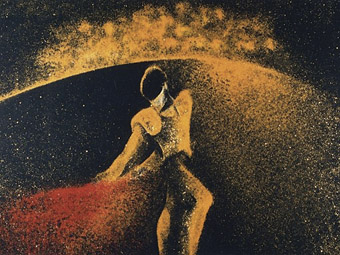
Carmen Torero
IN ITS 9TH ITERATION, THE MELBOURNE INTERNATIONAL ANIMATION FESTIVAL’S PROGRAMMING POLICY CONTINUES TO BE BRAVE AND ADVENTUROUS, AND THIS RESULTED IN ANOTHER DIVERSE SET OF PROGRAMS. THIS YEAR, THE BOAST WAS THAT MIAF SCREENED OVER 400 FILMS SELECTED FROM OVER 2,000 ENTRIES, SPREAD OVER 40 PROGRAMS AND REPRESENTING OVER 30 COUNTRIES. THAT’S A LOT TO ABSORB IN JUST SEVEN DAYS AND, AS ALWAYS, WHILE SOME SELECTIONS MAY BE A LITTLE UNDERWHELMING, THERE ARE ALWAYS UNRESERVED CLASSICS AT EVERY TURN. I MEAN THAT BOTH HISTORICALLY (MIAF TAKES GREAT CARE TO PRESENT AN OVERVIEW OF ACKNOWLEDGED GEMS FROM THE PAST) AS WELL AS INDULGENTLY: THERE ARE SO MANY MASTERPIECES BEING PRODUCED TODAY, AND MIAF, SEEMINGLY, GARNERS THEM ALL.
animating with sand
Each year, the festival spotlights a particular animation technique. In 2008, it was puppetry, which presented an excellent counterpoint to the industry’s surfeit of CGI. In 2009, it is sand animation, also promising. I was excited at the thought of a program dedicated to this laborious and visually stunning technique, which involves the manipulation of coloured powders (actual sand, most often, but also salt) over a light box, typically with hand brushes and air brushes. The program presented eight ‘classics’ and seven recent films, but the outcome was hit and miss. It seemed the form too often dictates the content because the technique necessarily involves swirling, dissolving imagery, generating too many twee scenarios (ponderous childhood reminiscing, dissolving memories) and a little too much navel-gazing, windswept hair and fluffy clouds.
A notable exception was Aleksandra Korejwo’s Carmen Torero (Poland, 1996; 3’45), based on Bizet’s Carmen. Korejwo’s skill is incredible, presenting a consistently mesmerising interpretation of Carmen’s interactions with the bullfighter, whose majestic cape-swinging movements through time and space engulf them both in great swathes of colour and grain (salt injected with dye in this instance, manipulated by animal feathers instead of brushes). Fur Mathilde (director Alla Churikova, Germany, 2009; 7’00) was also masterful, mixing a young girl’s (literally) black-and-white existence with her escape into the noise and colour of the city—some of the latter scenes are almost photorealistic, almost 3D, astonishing when you remember this is sand. But what I would really like to see in sand animation is a horror film. Imagine it, all that red powder and tenuous human forms —it would make for an excellent shower of blood, dissolving not into soft-focus memories but into traumatised brain tissue, skull fragments and exploded flesh. Just a thought…
internationals
There were 10 international programs: six mixed sessions plus tailored programs for digital forms, abstract films, long shorts and new Croatian animation. I enjoyed Bubblicious (Geoffroy De Crecy, France, 2008; 3’15), a film clip for Rex the Dog’s eponymous French house track, featuring a cut-out-style mutt rendered in 3D and singing the diva-like club anthem with serious attitude. Ridiculous, but infectious and super stylish. Two animations were distinguished by their hands-on technique. The Note (Hwang Bo Kumbyul South Korea, 2008; 3’30), about a letter that comes to life before the eyes of a child, is mesmerising, folding in on itself as ethereal bits of tracing paper prove to hold all sorts of secrets—morphing shapes, objects and scenarios barely held together by sticky tape…Almost like one of the family (Astrid Goransson, Sweden, 2008; 9’45) is bizarre and magical, with charcoal drawings on walls coming to life around a housewife in her kitchen, forming nested worlds within worlds that draw her deeper and farther away from the domestic.
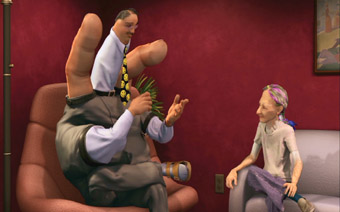
The Spine
The Necktie (Jean-Francois Levesque, France, 2008; 12’15) is a wonderful tale of Kafkaesque bureaucracy that pits our puppet hero against an internecine office conspiracy involving people who are nothing more than (again, literally) paper cut-outs. It’s an instructive example of form underscoring a story, rather than dictating it. Chris Landreth’s The Spine (Canada, 2009; 11’00), voted Best of the Fest, is a breathtaking combination of sketch artistry impressed onto CGI frames in a style Landreth has dubbed “psycho-realism.” According to the filmmaker, CGI makes animators lazy, able to cheat and do ‘incredible’ tricks without thinking; psycho-realism, then, tricks the audience into thinking the scene is reality, until everything collapses into disturbing surrealism. In The Spine, characters are trapped in a marriage counselling session as strips of flesh hang from their faces, while the lead character, free from his domineering wife, grows an actual, literal spine when initially he was just a blob of a man. Landreth is working on an animated biopic of HP Lovecraft, a truly exciting prospect. Other international highlights were to be found in the London’s Calling program, a blend of advertisements and short films showcasing the best of that city’s animation, including Marc Craste’s Varmints (UK, 2008; 24’00), which is truly warped in its mix of elements: dystopian sci fi, apocalyptic alien invasion and, yes, cuddly animals. City Paradise (Gaelle Denis, UK, 2004; 6’00) is an outstanding live-action/animation tale of a Japanese girl who visits London only to find a city even stranger than she is. It’s a really smart inversion of the standard Lost in Translation-style ‘foreignness’ attributed to places like Japan.
australian panorama
With only a few misfires, the Australian Panorama was true blue. Factoids and Slapstick (Doug Bayne, 2008; 4’15) was part of the BigPond/Screen Australia–sponsored Great Moments in History competition, in which animators were invited to consider “funny stuff that happened between the Big Bang and the end of time.” Ostensibly, it tells the story of Vlad the Impaler, but the animator steps into the frame to express doubts about the whole storytelling process—clever and fun. The Aussie Panorama screened two other films in this series, but they weren’t as good, relying on tedious toilet humour. There should be an unimpeachable, ironclad rule in film school, along with those other immutable maxims they teach about good story: “NO FART/POO/BUM JOKES. Ever.”
Be Famous and Die (Simon O’Carrigan, 2008; 4’45) uses simple techniques to deliver a deeply felt monologue about the peculiarities of Melbourne’s obsession with statues of famous people. Laura Stitzel’s fabulous The Roaring Tide (2008; 4’00), drawn in Roaring 20s deco style (all blocky, angular shapes and zoot suits) is, joyously, about shipwrecked passengers who simply refuse to admit the severity of their situation, insisting instead on partying and unadulterated hedonism. Bronze Mirror (Susan Danta, 2008; 7’00), voted best Australian film of the festival, was a worthy contender. Based on a Korean folk tale, it uses surreal CGI to depict rural folk in old Korea mesmerised by a ‘demon’ they’ve never seen before—themselves in a humble mirror. But perhaps Mutt (Glen Hunwick, 2007; 7’00), about a dog in the outback obsessed with his ball even though he has no one to play fetch with him, should have got the nod. The technique (rounded, grossly caricatured characters), the set design and the colour scheme are outstanding, and the story is just too funny, the poor dog’s antics lingering in the memory. It was one of two great Aussie canine stories, the other being Dog with Electric Collar (Steve Baker, 2008; 4’45) which uses a whip-sharp style—pulsating, fantastical and colourful—to portray a dog who just can’t stop barking, even under threat of painful death.
All up, the MIAF team, led by Malcolm Turner, have really settled into a good groove, with a programming style that delivers. Our local animators have also risen to the challenge, proffering a brace of films that stand up to scrutiny. Here’s to the future.
2009 Melbourne International Animation Festival, ACMI Cinemas, Melbourne, June 22-28; www.miaf.net
RealTime issue #92 Aug-Sept 2009 pg. 31
© Simon Sellars; for permission to reproduce apply to realtime@realtimearts.net
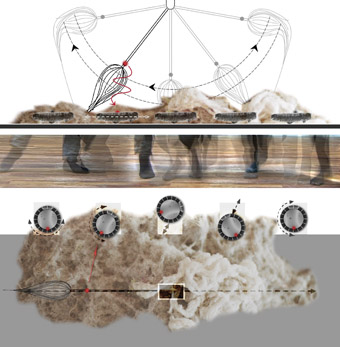
On Track, by Petra Gemeinboeck
courtesy the artist
On Track, by Petra Gemeinboeck
ANY NEW FUNDING OR INCREASED RECOGNITION FOR THE ARTS AND THOSE WHO LABOUR IN THEIR SERVICE IS CERTAINLY TO BE ENCOURAGED AND APPLAUDED. SO ARTS PRACTITIONERS AND ACADEMICS WILL WELCOME BOTH THE RECENTLY ANNOUNCED FEDERAL GOVERNMENT INITIATIVE, ARTSTART, AND THE INCLUSION OF CREATIVE WORKS IN THE 2009 ERA (EXCELLENCE IN RESEARCH FOR AUSTRALIA) DATA COLLECTION TRIAL CURRENTLY UNDERWAY IN AUSTRALIAN UNIVERSITIES. ALTHOUGH THEY ARE TARGETED TOWARDS DIFFERENT COHORTS OF THE CREATIVE ARTS COMMUNITY, BOTH SCHEMES WILL HAVE AN IMPACT ON THE EDUCATIONAL INSTITUTIONS THAT ARE OFTEN RELIED UPON TO PROVIDE A REFUGE FOR ARTS PRACTICE IN THIS COUNTRY.
Importantly, the schemes provide pathways for emerging graduate artists and recognition for the work of creative arts practitioners who double as educators and academics. That said, the reception given to Artstart and the ERA guidelines by those in the field is, quite rightly, tempered by concerns over unanswered questions and a caution borne out of past experiences. The elevation of the status of creative arts practice as a career path, as it applies in these cases to both graduates and those working within the Academy, inevitably comes at a cost. That cost is tied to the degree to which creative arts practice can be measured and audited by those who determine how funding and recognition will be allocated and rewarded.
artstart minus social security
Artstart will deliver $9.6 million over four years to be allocated as “one-off grants to help graduates start a business as professional artists.” The scheme will be administered by the Australia Council, with applications to be called for later this year. To date, no announcement has been made about the criteria which will be used to assess the applications. However, given that the scheme will cover visual artists, musicians, sound artists, filmmakers, writers and performers, the process will almost certainly take place outside the normal panel structure the Council uses when assessing funding applications. Grants of up to $10,000 will be offered to 200 applicants per annum. The grants differ from traditional arts funding in that they can be used for activities other than the production of works. So, for example, an artist might apply for funding to purchase expensive equipment or for the establishment of a small arts business. Artstart falls short of the Rudd government’s pre-election promise to “develop a ‘Social Security and the Arts’ policy that harmonises current Australia Council, Centrelink and the Australian Tax Office rules [as well as] determines the most equitable way to treat earnings and royalty payments for artists currently receiving welfare” (Arts Minister Peter Garrett’s 2007 New Directions for the Arts policy speech). That said, it must be counted as a step in the right direction.
artstart or jobstart?
Responses to the scheme from those I have consulted within the creative arts sector are mixed. Anna Munster, artist and Senior Lecturer at UNSW’s College of Fine Arts (COFA), points out that while “there’s a need for something at the lower end of the funding scheme…the ‘speak’ in which it’s couched suggests a kind of alignment with Jobstart.” She suggests that it might have been better to follow the UK model which allows artists to receive unemployment benefits for a period of time while working on an art project. Niall Lucy, Research Fellow with the Australia Research Institute at Curtin, concurs arguing that, “there’s a need for meaningful government funding of ‘meaningless’ arts programs, as opposed to all too predictable outcomes-based vocational training.” This kind of thinking can also be found in the National Association for the Visual Arts (NAVA) pre-election call for Labour to deliver on its promise to provide a “living wage” for two years after graduation for art practitioners engaged in professional activities.
for the moneywise & grant savvy
Artstart will certainly benefit those young people who are capable of tapping into revenue streams. Ross Gibson, Professor of Contemporary Arts at Sydney University, points out that “where there are young people in the arts who really, really need money, then there’s a need for Artstart. But the trick will be to find a way to make the scheme amenable to people who are not used to money, people who never grew up around money, people for whom money is not a part of their culture.” Ross Harley, Head of School of Media Arts at COFA, also notes that there is such limited funding for so many graduates. This reinforces the point that Gibson is making—the money savvy, grant savvy graduates are the ones who will benefit most from the scheme. All of those I spoke to agreed that these grants will certainly reinforce the need for educators to ensure that graduates understand how to take advantage of any government largesse directed at them. However, as Anna Munster points out, “There are not that many tertiary institutions that don’t expect some kind of ‘finished’ product as the result of a finished degree these days. But ones that serve students better provide less ‘vocational’ finished products. The best courses provide students with a set of mutable and flexible skills: critical thinking, project management, teamwork and cross-platform training (by which I mean encourage students to make work in pop bands, curate, write articles, build simple websites, coordinate live events and so on). These kinds of students don’t necessarily need Artstart but they will probably do very innovative things with it.”
art work after 30
There was also general agreement that some of the funding might well have been directed towards ensuring that once these artists reach 30 they can find sustained employment in the arts. Artist and RMIT academic, Martine Corompt says “it does seem sometimes that there is a constant support/celebration of emerging artists. But no matter how you prepare artists for the next 10 or 20 years there just aren’t enough teaching positions or commercial galleries to support them all. Perhaps there should be greater support for initiating new venues outside of the CBD (studios, galleries, performance spaces) which would create positions dealing with curating, management, administration and so on. The added benefit would be the transformation of districts/precincts in suburban or regional areas in need of rejuvenation.” As Ross Harley asks, “What happens after, when you’re a mid-career artist? Once you’ve received the ‘seed’ funding, should that then set you up to be self-sufficient?”
creative work: legitimate research
Corompt, Munster, Harley and Gibson, and many others like them, have been able to sustain themselves financially as creative arts practitioners through their work as creative arts educators. However, as Margaret Seares from the Council for the Humanities, Arts and Social Sciences (CHASS) points out, “the issue of the status and recognition of the work of academic artists, in terms of research, has been an often fraught one. The national system for collating, auditing and, ultimately, rewarding research outputs—known as HERDC—did recognise creative work for a time, but for the past decade this has not been the case. This has meant a degree of marginalisation for academic artists when the research performance of their university has come under discussion or review” (M Seares, “A new era for Creative Arts research”, www.chass.org.au/articles/ART20090430MS.php). This marginalisation has had a significant impact on the status and workloads of creative arts academics, tied as they are to demonstrable research performance. The inclusion of creative works in the 2009 ERA data collection trial is designed to directly address this issue by reinstating the recognition of creative works as legitimate research outputs.
Under the ERA guidelines, eligible research output types include original creative works, live performance of creative works, recorded/rendered creative works and curated/ produced substantial public exhibitions and events. Each work needs to be accompanied by a statement identifying the research component of the output, which must be made available in an institutionally supported repository (such as a university sponsored Research Bank). The statement must be a maximum of 250 words and must outline the research background of the work (field, context, research question), the research contribution of the work (in terms of innovation and new knowledge produced) and the significance of the work in relation to research excellence.
University based artists and writers certainly welcome these changes. Recognition of creative work as research is long overdue. That doesn’t mean, however, that those affected by these changes don’t have some reservations about whether the scheme will produce real effects. Darren Tofts, writer and academic at Swinburne University, notes, “There is still a lot of work to be done to change the research culture within many universities to acknowledge and accept that the creative arts do contribute to the intellectual and research capital of both the academy and society more widely.” Anna Munster agrees. “We have argued for years that creative works should at least count as research so here we finally have an opportunity to make that recognition happen. Hopefully, it will track and make visible the enormous contributions to research that artists do in fact make and put them in a more competitive position when it comes to applying for other kinds of external university income.”
creative limits
Ross Gibson remains circumspect. “[I]t will benefit artists who are keen or able to engage in some extra, fairly traditional routines of academic scholarship, adding some linguistic discourse onto their productions. The ERA probably won’t benefit artists who happen to teach in academies but who are not that interested in being the new-style creative arts academic. The rules are pretty clear—knowledge has to be made explicit and communicated. The arguments will occur over whether the creative art work, standing alone, is explicitly communicated knowledge. My reading of the national intellectual scene is that we’re nowhere near persuading enough people that this is true.” Niall Lucy believes ERA could also have the potential to “limit the possibilities of what may count as ‘creative’ work in terms set by university and Canberra bureaucrats.”
Artstart and the inclusion of creative works in the ERA are positive moves in the right direction for emerging artists and creative arts academics. Whether they take us closer to equitable, sustainable, workable outcomes for those working in the creative arts remains, for now, to be seen.
Image note: Installation layers in the form of a section, a video extract and a floor plan for installation work, On Track, by Petra Gemeinboeck, artist and Senior Lecturer in Interactive Media Arts at College of Fine Arts, Sydney. “A disaster-prone scenario unfolds as the protagonists, apparently set to clean, spill, interfere with and hinder each other, creating an ever more slippery mess in intricately choreographed ways.”
Thanks to Anna Munster, Martine Corompt, Darren Tofts, Niall Lucy, Ross Harley, Ross Gibson, NAVA, CHASS and Ricardo Peach (Inter-arts Office, Australia Council for the Arts) for their contributions to this article.
RealTime issue #92 Aug-Sept 2009 pg. 32
© Lisa Gye; for permission to reproduce apply to realtime@realtimearts.net
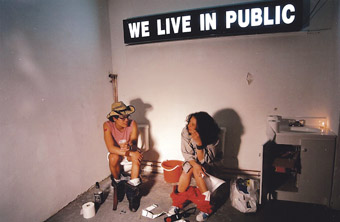
We Live In Public
IF THIS ARTICLE HAS A STRUCTURING ABSENCE, JOSH HARRIS IS ITS NAME. THE WARHOLIAN FIGURE BEHIND PSEUDO.COM, A WEBSITE THAT, IN ITS DAY, WEBCAST SHOWS ABOUT EVERYTHING FROM DEVIANT SEX TO MODERN ART BEFORE GOING BANKRUPT WHEN THE DOT-COM BUBBLE BURST (HARRIS LATER CLAIMED, IN A LETTER TO THE NEW YORK TIMES, THAT PSEUDO HAD BEEN “A FAKE COMPANY”, “AN ELABORATE PIECE OF PERFORMANCE ART”), WAS MEANT TO BE INTERVIEWED FOR THIS ARTICLE. BUT HARRIS IS NOT, AS IT TURNS OUT, A PARTICULARLY EASY MAN TO GET HOLD OF. INDEED, AS ANYONE WHO HAS SEEN THE FILM, WE LIVE IN PUBLIC, WILL ATTEST, HARRIS IS NOT AN EASY MAN, PERIOD.
Ondi Timoner’s award-winning documentary, which screened at the Sydney Film Festival in June and at the Melbourne International Film Festival in July, charts a decade in Harris’ life and work. And while Timoner is quick to point out that the film is less a portrait of Harris than an investigation of the potentially dehumanising impact of the internet on society, the image of the mercurial visionary/madman at its centre, while at times affectionate, is not always a flattering one.
When I call Timoner at her Los Angeles home, where she is packing in preparation for an intercontinental trip that will see her visit Europe and, for the second time in three months, Australia, she is quick to confirm the impression. “You’re calling me on a bad day in terms of my relationship with Josh”, she tells me. “I’m really frustrated with him right now.”
Timoner’s frustration with her subject has a lot in common with mine. Timoner, who looks a bit like Joan Allen crossed with a rock star (which for the filmmaker behind DiG!, the award-winning documentary about the neo-psychedelic bands The Brian Jonestown Massacre and The Dandy Warhols, probably shouldn’t come as a surprise) is frustrated about Harris’ constant refusals to be interviewed. Especially when getting the word out about the film is so important to its success or failure.
After the film screened at Sundance earlier this year, where it was awarded the Grand Jury Prize for US Documentary, Timoner says the question of distribution began to rear its ugly head. “It has been a real struggle to put this movie out in the right way—to put this movie out, period. Because of the current state of the economy, finding the resources has been a miracle.”
The centrepieces of Timoner’s film are two art projects spearheaded by Harris at the turn of the century: Quiet, which saw 100 artists live together for 30 days in an underground bunker wired with webcams, and We Live in Public, which saw Harris and his girlfriend wire their own home in the same way. The idea was to show the extent to which the internet would allow people their promised 15 minutes and the lengths they would then go to get it. Things went, in no uncertain terms, to shit.
The bunker turned into The Lord of the Flies and the New York City police were called in, Harris’ girlfriend left him alone in the fishbowl, traffic to the site went to hell, he went bust, and then experienced an almost inevitable nervous breakdown. While the point of both projects, to some extent, was to warn us about the path the internet was taking us down, the personal toll it took on Harris was something not even he had foreseen. “The whole cautionary tale aspect of Josh is something that I very much was inspired by in terms of making this film”, Timoner tells me. “I think there’s a price you pay for being a visionary or a genius or whatever you want to call it.”
Not that Timoner herself necessarily buys into Harris’ Orwellian view of the future and the role that the communications technologies will play in it. “Josh had a very dark and controlling, mad-scientist approach”, she says, “where he drives everyone over the edge a little bit, himself included…But that is not all that the internet is. I think it’s the most important tool we’ll have access to in our lifetime. It’s a really exciting time to be alive because of it. But as much as it allows us to self-organise and cut out the middle man—which really scares the shit out of our distributors, by the way—it does have the potential to be dangerous…The more connections we make outwards, the less we’re making inwards, with our families, with our friends, physically. And we’re doing that. We’re making that happen.”
Mostly, though, Timoner sees the internet and other interactive technologies as good things. In Sydney for the film’s Australian premier in June, she also attended the X|Media|Lab Serious Games conference, with Harris in tow, to discuss the impact of video games and other interactive technologies upon cinema (and, she makes perfectly clear, vice versa).
The meeting of cinema and video games might mean, for some, rich media and cross-platform projects like Chris Marker’s Immemory and Peter Greenaway’s The Tulse Luper Suitcases, respectively. For others it might mean films like Gus Van Sant’s Elephant and Tom Tykwer’s Run Lola Run which borrow the visual language and narrative structure of video games while remaining essentially cinematic works.
For her part, Timoner is interested in the way that the two forms, while maintaining their integrity in the face of hybridity, can engage in a conversation with one another. This is a conversation, she says, that stems from the work but takes place around it. Ideally, it will eventually branch out, moving beyond it and taking on a life of its own. “What you can do is create all sorts of elements around your film that people can engage with once it’s over”, she says. “That’s a kind of interaction, too.” For example, to coincide with the documentary which deals with climate change and economics (she is also working on a narrative biopic about the photographer Robert Mapplethorpe, in which Eliza Dushku will star) a Los Angeles-based company is designing an educational video game that will deal with many of the film’s themes. Timoner predicts “Kids aren’t going to be able to learn in a traditional education system for very much longer”. “It’s going to have to be interactive. It’s going to have to be fun, it’s going to have to be fast, and it’s going to have to be engaging.”
Inevitably, Ondi Timoner sees the interaction between cinema and video games, in whatever form it takes, as a way of getting people to think, and it is the impulse to do so that is ultimately at the heart of all her work. “I make films to inspire people to take action, whatever form that action make take”, she says. “To be conscious, to really go forth and do something with their lives, to create.” And this, of course, is ultimately political. “Next thing you know, people are walking around and living their lives”, Timoner says, “and they’re more apt to think critically about what they’re encountering, how they’re acting, all of that…That’s why I originally started making films; every film of mine has been about getting people to do that.…They’ve also been about groups and group dynamics, and about what people will give up to belong and make their lives matter. To some extent”, she says, “We Live in Public is about what we’ll give up for the attention and recognition that we feel when we go online. Obviously, it can be very exciting. Josh’s story is a warning shot.”
Director and producer for Interloper Films (Los Angeles), Ondi Timoner was a speaker at the X|Media|Lab Serious Games Conference, June 12-14; www.xmedialab.com
RealTime issue #92 Aug-Sept 2009 pg. 33
© Oscar Michaels; for permission to reproduce apply to realtime@realtimearts.net
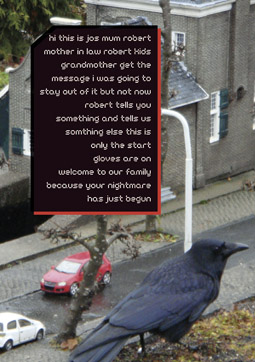
from CU The Presence of Co-Presence, Larissa Hjorth
courtesy the artist
from CU The Presence of Co-Presence, Larissa Hjorth
WE AL KNO HW 2 RIT N RECEV TXTS, ITS JST LIK MAKN A FONE CAL. BT SOM SMSS R MOR IMPRTNT THN OTHRS, LIK MST THNGS IN LIF, SOM MSGS STIL PACK A HEVY EMOSHNL PNCH
Larissa Hjorth’s CU: The Presence of Co-Presence explores the phenomenon of the Short Message Service or SMS from its humble origins as a means of communication for the deaf to a staple form of interaction amongst the growing number of ‘thumb tribes.’ The show is presented on CCP’s Night Projection Window; its translucent glass allows images to be viewed from either side. The exhibition takes the form of a 30-minute presentation that combines text messages with photographic images. The messages are not displayed for very long and are rear projected, so the best place to view the exhibition is from the footpath (or better still from the pub across the road).
The interesting thing about a work best viewed from outside the gallery is that the very exhibition becomes an embodiment of co-presence. Going to a photographic gallery only to stand out the front feels like being both there and not there, simultaneously inside and out. The text message also exemplifies this notion—the sender is present with the reader, yet still physically in the location whence the message was sent.
The text messages that Hjorth chose for the exhibition were compiled from those people had saved to their phones. Accounts of the emotions embodied in the messages were also provided to Hjorth by the recipients. From that, individual photographs were created and selected by the artist as a way to capture the emotional significance of each message.
In displaying these still photographic images as ‘moving’, the artist has the luxury of employing techniques like zooms and pans, to take the audience’s eye to areas of interest or significance. Some photographs appear at first as close-ups until zoomed out to reveal different stories. This was most memorable with the photograph accompanying the SMS “I want 2 C U”, which started with a close-up of a man and a woman in an embrace, then slowly pulled out to reveal them as part of a billboard advertising mobile internet.
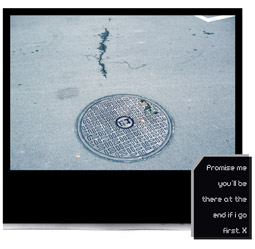
from CU The Presence of Co-Presence, Larissa Hjorth
courtesy the artist
from CU The Presence of Co-Presence, Larissa Hjorth
While the title of the show CU is a reference to the SMS shorthand of ‘see you’, when photographs start with a distorting close-up (CU, in film shorthand) another aspect of co-presence reveals itself—being in one place but seeing it from two different perspectives. A similar effect was achieved with a pan across the photograph accompanying the message “Promise you’ll be there at the end if i go first. X”, which tracked an oil filled crack as it snaked towards a manhole. These techniques also added another dimension to the emotional impact of the photographs, drawing our attention to details we ordinarily might not notice.
Accompanying the video display is an exhibition catalogue of short essays and creative pieces reflecting and expanding on the evolution and significance of the text message. Giles Lane looks at how closely linked the current Twitter craze is to the popularity of texting, while Darren Tofts pays homage to Alexander Graham Bell for inventing the telephone, the forerunner to SMS and other forms of co-presence.
Texting has become so ubiquitous because it provides people with another, possibly more intimate, way of communicating than speaking into the telephone. Sometimes there are things people would rather not say out loud, whether they are in a public place and do not want to broadcast their message or perhaps because it is so deeply personal they would rather not utter the words at all. This phenomenon has led to people saving certain messages, as they would love letters, to reread and remember forever…or at least until they get new phones.
Ultimately CU is more about the text message than the photography, however the conversation Hjorth develops between the two creates a real sense of the emotional importance that messages of any kind can have on a recipient. As Fee Plumley writes in the catalogue, it’s like the feeling you experienced when you received an affectionate note passed to you by someone in your high-school class.
Hjorth’s exhibition highlights a modern phenomenon that has captured the hearts and minds of millions of users—one is my 90-year old grandmother, Oma, who has not only taken to texting but has also embraced the shorthand that goes along with it. I’m still surprised every time my phone beeps with a message from her and even laugh out loud when I read it: “r u ok? hope 2 c u soon <3 om.”
Larissa Hjorth, CU: The Presence of Co-Presence. Centre for Contemporary Photography, June 5-Aug 1, www.ccp.org.au
RealTime issue #92 Aug-Sept 2009 pg. 34
© Jeremy Weinstein; for permission to reproduce apply to realtime@realtimearts.net
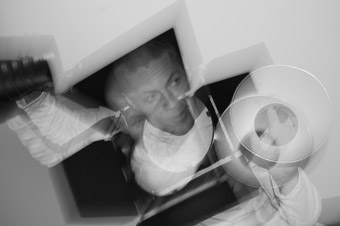
Daniel Belton
courtesy the artist
Daniel Belton
DANIEL BELTON IS A FILMMAKER AND CHOREOGRAPHER BASED IN SOUTHERN NEW ZEALAND WHOSE WORKS HAVE BEEN SHOWN AT NATIONAL AND INTERNATIONAL DANCE AND FILM FESTIVALS IN CHRISTCHURCH, OTAGO (WHERE BELTON RESIDES), EMPAC IN NEW YORK AND ELSEWHERE. BELTON FORMED GOOD COMPANY ARTS IN 1997, PRODUCING FILM, INSTALLATION AND LIVE PERFORMANCE.
Although the company’s output is diverse, its film work is pervaded by a sense of aesthetic historicism. Matchbox (2008), for example, draws on the imagery of the Bauhaus, Futurism, vaudeville, the films of Friz Lang and Buster Keaton. Earlier films allude to Albrecht Durer, Renaissance perspective and Commedia del’arte.
Belton acquired an interest in art history at an early age through his father, painter Peter Belton, who serves as designer on most of Good Company’s projects. Indeed, Belton considers the sculptural, painterly aesthetic of many of his films as representing a ‘return’ in his career. “I left high school with high marks in art”, he explains, “and I was heading to Canterbury University to study fine arts, but had auditioned for the New Zealand School of Dance. They called me up and said: ‘You’re in!’ I thought that while my body was young I should do this—and I could come back and go to art school later.” Belton graduated in 1990, subsequently dancing with many companies in New Zealand and internationally, including the Douglas Wright Company, Arc Dance and Tanz Gervasi, Austria.
In 1997 Belton settled in Dunedin in the south of New Zealand and founded Good Company. “I wanted to start making my own work, not only for theatre spaces, but to fuse the visual arts with dance, sculpture and kinetic art.”Good Company’s recent work can be divided into two main series. The most recent triptych culminated in Matchbox, growing out of the companion pieces Game (2004) and Reset (2006). These are the most closely related of Belton’s films, shot in misty, halo-infused black-and-white reminiscent of German Expressionist cinematography. Focused around the idea of a kind of combined puppet show and game-playing machine, figures interact by pushing buttons, arranging poles, dancing with each other or animating miniature figures and vaudevillian bands. Belton’s earlier trilogy—Soma Songs (2006), Seismos (2006) and After Dürer (2007)—dealt with problems of space and the articulation of line and form through movement within a set of virtual, perspectival frames, or across a multifaceted and effectively multidimensional sculptural object. Dancers crawled over planes and into inverted relationships, as in the upside-down works of MC Escher.
“I was originally drawn in to theatre by puppet shows”, Belton observes. “They are a filmic window. It’s like looking in the back of an old bellows camera. You open it up, it concertinas out, and it’s like there’s a little theatre in there, in the viewfinder. It’s a miniature proscenium arch.” Belton is keen to ensure that these relatively commonplace ideas about the relationship of film to theatre materialise in a complex—albeit still light and playful—mise en scène. The characters of Matchbox climb into and out of a graphed, perspectival space, its digitally added lines (provided by Jac Grenfell) converging on what would be the focal point for any one view. The performers are, in effect, rendered mechanical, inasmuch as they interact with the objects and materials presented to them by the flashing, almost Mondrian-like game device designed by Peter Belton.
“[This machine] is also like the sound box of a musical instrument”, adds Belton. A key part of Matchbox’s alluring blend of time and reference is to be found in the wound-down score produced by Grenfell’s digital decomposition of the music of Django Reinhardt and 1930s vaudeville. The game dings, crackles and pulses with these sounds, just as it produces pillars and squares, or offers spaces and lights with which the characters interact. Not only are several of these sonic and visual motifs coincident within Matchbox, but they perform the same dramaturgical function of rendering a machinic world of performance and of dancing from within an antiquated yet contemporary, partly-digitised format. Belton indeed goes so far as to shoot in digital video and reformat the image in 16 mm analogue film, even though in many cases his films are projected from a DVD dub.
It is this interest in bodies and forms whose motor force and activity seem derived from the logic of film and of the moving image, rather more than human, fleshy or three-dimensionally choreographic logic per se, which places Matchbox and its companion works close to the conceptual ideology of Bauhaus and Futurism. Like many dance film artists, Belton’s interest in the form originally derived from his work on archiving his own productions as well as from producing live multimedia pieces like the stage production Soma Songs (2005). “It was always frustrating because it was never like the live show”, Belton admits. “But then there was something in that loss, as well as in the discipline of locking down your reading to one visual frame.” Where some of Belton’s live performances have multiple points of interest and a circus sense of order tipping into chaos (Fellini-like, notably in Belton’s Commedia-influenced Soundings, 2001), his films are by contrast tightly focused on small groups in glowing, misty but well-defined hazes of light, or on crisp figures which stand out before a black background amidst architectural lines and shapes.
Recalling the ideas behind the extraordinary modernist marionettes and sleek, conical, monochromatically painted dolls designed by Sophie Tauber and Oscar Schlemmer, Belton insists that “working with the human body for film is like puppeteering. You craft a choreographic story with the bodies of the dancers you are working with, but in postproduction you revisit that. You can jump cut, speed things up, reverse things, slow them down, or you can layer them.” Although Belton generates much of the material which he films by giving tasks to his performers, and sees them as active agents within the process of developing the work, nevertheless the philosophy of his approach explicitly denies agency to the dancer-characters of his films. The figures who dance across his screen are not particularly human, or even necessarily embodied per se. They are formal devices within a larger mise en scène. In Matchbox in particular, the game-play set up by uncertainty over the categories of human versus non-human and agency versus puppetry produces the humour and narrative arc of the work.
In the end though, Belton’s preferred metaphor to describe his material is storytelling. “We’re storytelling beings”, he insists. “I try to make each film have enough layers to have many readings. With the way I choose my performers, I’m not trying to get a group of racehorses together. You’ve got people from all walks of life, different shapes and sizes. It’s about drawing them out and allowing them to offer as much as they can. The theatre is like an engine for telling [many] stories.” These narrative threads, forms, sounds and movements are unified through the medium of this machine, which gathers material along its lines of sight and sound, and then beams them out. “It’s like the sound box of a musical instrument”, observes Belton. “When you project film, you are projecting this information out. The soundbox from a guitar or a lute is also projecting sound out, and the theatre is projecting storytelling.”
Matchbox’s World Premiere was at the Otago Festival of the Arts, Dunedin NZ, October 2008. It was a finalist in the VideoDansa, Barcelona Prize 2009, IDN Festival, Barcelona, Spain and in the Official selection Dance on Camera Festival International Competition 2009, New York, USA.
Daniel Belton & Good Company, Matchbox, director, performer, editor Daniel Belton, co-producer, performer Donnine Harrison, performers Richard Huber, Caroline Claver, Courtney Poulier, Tim Fletcher, Emmett Hardie, Kilda Northcott, director of photography, animations, sound Jac Grenfell, lighting, animation Nils Stroop, holography Ozrac Densky, design Peter Belton & company; www.goodcompanyarts.com
RealTime issue #92 Aug-Sept 2009 pg. 35
© Jonathan Marshall; for permission to reproduce apply to realtime@realtimearts.net









































































